
Examples of The Perfect Thank You Email After A Presentation
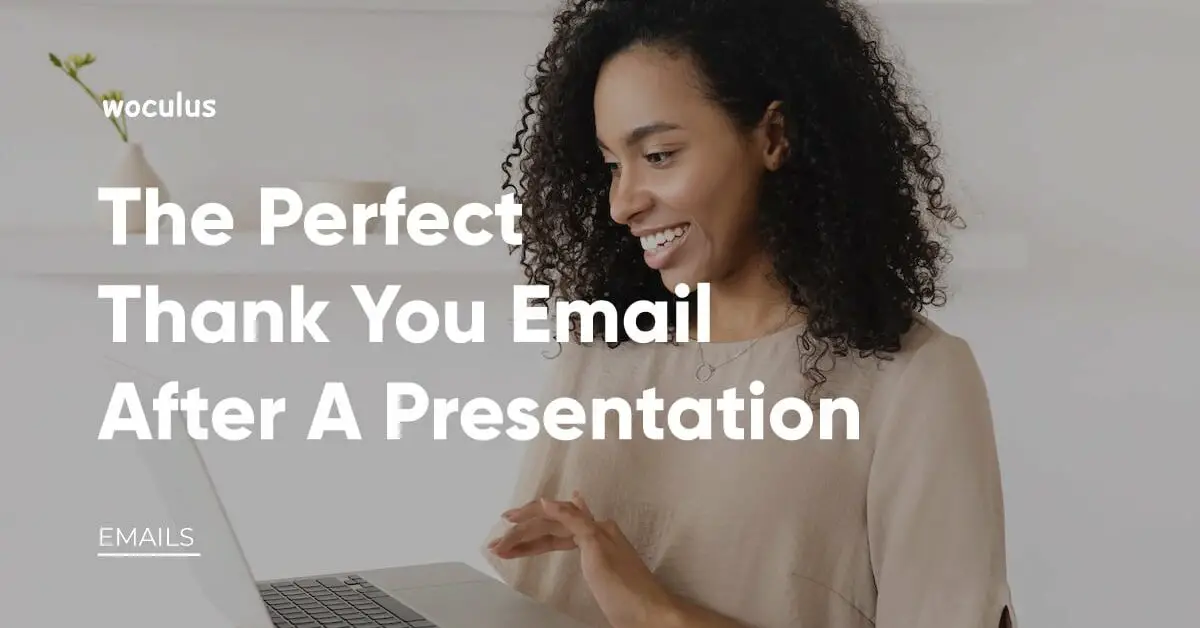
Ever imagine how you are going to craft that perfect thank you email after a presentation? Have you ever found yourself giving a presentation and walking away with a sense of accomplishment, only to wonder what comes next?
Let’s say you just finished an awesome presentation pitching your startup to potential investors or sharing groundbreaking research at a conference, a sales pitch, or a team meeting, leaving your audience inspired, informed, and motivated to take action.
What if I told you that’s only half of the journey? By sending a “Thank You” email, you have the opportunity to reinforce your message, solidify connections, and elevate your personal brand to new heights!
A lot of people often underestimate the power of expressing gratitude. The Thank-You Email is more than just a courtesy, it’s a strategic tool to leave a lasting impression and strengthen those invaluable connections you’ve worked so hard to build.
But wait, there’s more! In this post, we’ll explore how to write a captivating and impactful “Thank You” message that resonates with your audience. From nailing the tone and structure to incorporating personalized touches, we’ll cover it all. In this exciting post, I’ll reveal some expert tips and proven strategies to help you draft the PERFECT “Thank You” email after your presentation. From the right tone to nailing the content, we’ll cover it all!
Tips for creating the perfect thank you email after a presentation
In this session, we will explore some key elements that go into creating a compelling thank you email, which can be the difference between a fleeting moment in your audience’s memory and a lasting impact that sparks engagement and collaboration.
1. Time Your email
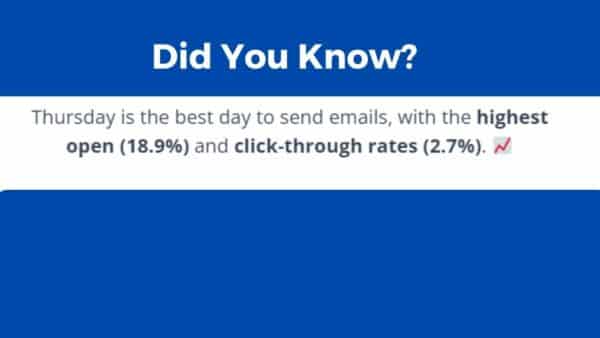
According to research conducted by Moosend , Thursday was the best of the weekdays in terms of the highest open rate and Tuesday was the second-best day. Furthermore, 8-9 am was the best time of the day to deliver them. When it comes to email, timing is very important and the success of your receiver engaging with that email can depend on it. You don’t want to send a thank you email a week after your presentation. It is more realistic and advisable to send it when the presentation is still fresh in the mind of the audience. Ideally, a thank you email after a presentation should be within 24 to 48 hours. But if it falls within the above range, you can use those criteria for more engagement. Aim to send the email while your ideas and insights are still fresh in your audience’s minds.
2. Personalize
When sending a thank you email to people who attended your presentation, personalization is key. Research shows that personalized emails are opened 82% more than generic emails . Sending a generic email just doesn’t cut it. You need to address the email specifically to each individual or important person that attended. You can start by addressing your recipients by name and mentioning specific points from your presentation that resonated with them. This thoughtful touch shows that you genuinely value their time and engagement.
3. Reinforce Key Takeaways
People are busy, especially in the professional world, there is a lot of clients to meet, deals to close and potential investor to meet. They are so busy that they can easily forget they were even at your presentation. So taking the time to refresh their memory by summarizing the key takeaways from your presentation. Reminding them of the values they gained and how they can apply those learnings in their work or projects.
4. Encourage feedback
Don’t just write a thank you email and leave it at that. Let the recipient know what you want them to do. This can encourage engagement and leads to future conversation and even connections. Encourage feedback and questions in the email. Including a call to action will help you gain insight from those experts that came to your presentation.
5. Addressing Follow-up Questions and Concerns
During your presentation, there might have been questions or concerns raised that you couldn’t address fully at the time. A thank you email provides the perfect opportunity to tackle these queries, demonstrating your attentiveness and commitment to addressing your audience’s needs.
6. Offering Additional Resources
Your presentation may have piqued the interest of some attendees who wish to delve deeper into the subject matter. Provide them with additional resources, such as research papers, reports, or relevant articles, to facilitate their exploration. This thoughtful gesture positions you as a helpful resource and reinforces your credibility as a subject matter expert.
7. Keep It Concise and Engaging
While your email should be informative, it doesn’t need to be lengthy. Craft your message with clarity, enthusiasm, and a touch of personality to keep your reader hooked. Also, you need to proofread your email before sending it. A simple typo can distract from your otherwise brilliant message. Always proofread your email before hitting that send button.
8. Include your contact information
Ensure that your email includes your contact details, making it easy for the recipients to reach out if they have further questions, want to collaborate, or express their thoughts on your presentation. Accessibility is key to fostering meaningful professional connections.
5 Samples of Thank You Emails After A Presentation
Sample 1: thank you email after pitching to investors, 2. thank you email after presenting to team members, 3. thank you email after presenting at a conference, 4. thank you email after presenting to clients, 5. thank-you email after presenting to potential partners.
In today’s fast-paced and competitive environment, taking a few moments to acknowledge the time and attention of your audience can make all the difference in building strong connections and leaving a lasting impression.
We have explored the various components that make up an effective “thank you” email, from its warm introduction to its concise yet heartfelt body. Each section plays a vital role in creating an impactful message that resonates with your recipients. By incorporating a personalized touch and highlighting key takeaways from the presentation, you demonstrate a genuine interest in fostering a meaningful relationship with your audience.
About The Author

Opeyemi Olagoke
Related posts.

How to Resolve Conflicts with Colleagues via Email
How to ask your boss for a raise via email.
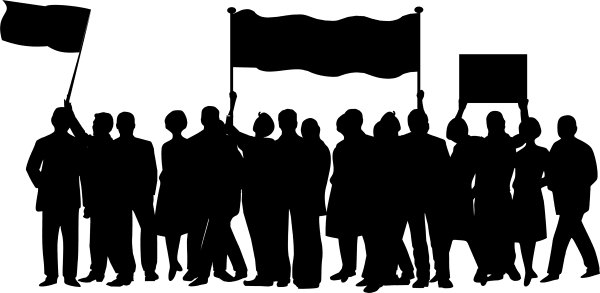
How to Protest an Unfavorable Transfer Via Email

How to File a Sexual Harassment Complaint via Email
Leave a comment cancel reply.
Your email address will not be published. Required fields are marked *
Save my name, email, and website in this browser for the next time I comment.
8 Ways To Say “Thank You” After a Presentation
Hrideep barot.
- Presentation , Speech Writing

As crucial as the beginning of a speech presentation is, the conclusion of your speech is what you leave your audience with. This may appear to be a straightforward task because, after all, you could just say thank you at the conclusion of your presentation, right? Both yes and no. Yes, since practically every presentation can be concluded by saying thank you and going away. No, because it is not unique and you should aim to make your thank you note a memorable element of your presentation. Here are 5 ways to make that “thank you” as memorable as possible.
Why is a good thank you important?
According to research , people are more likely to recall the beginning and finish of anything than the activities that occurred in between.
As a result, the beginning and finish of your presentation are critical since those are the areas that the majority of people will remember the most. A sincere thank you leaves a lasting effect on the audience, and it is a sentiment they carry with them.
8 Ways to say “Thank You”
1. appreciate the audience.
This is the simplest way of saying thanks. In this form of giving thanks, the speaker thanks the audience for giving him the time of the day, and for being attentive. An example of this would be, “Thank you for being here today, I really appreciate that you took the time to be here and listen to my presentation”. It can also be something short and sincere, like a “Thank you very much!”
When concluding an oration, an age-old approach of finishing your presentation is to summarise major aspects of your speech. It’s a closing tactic used by presenters and authors to guarantee their audience recalls their primary message.
With lectures and conventional presentation thank you speeches, including a summary for closure is fairly typical. That’s because, no matter how wonderful your presentation was, you’ll have to remind your audience of what you talked about.
A satisfactory thanks can be produced by reiterating a topic or significant concept from the introduction. The speaker may appear to be coming full circle to the audience, signalling the end of the discussion.
3. Call-To-Action
A call to action is a brief, straightforward remark intended to elicit an instant reaction from the listener. It is a great way to finish a presentation. A CTA should state clearly what you require of your audience, as well as why you’re providing the presentation in the first place.
Your CTA doesn’t have to be difficult to understand. It might even be as basic as asking your followers to like your social media pages. Alternatively, you may ask them to join your email list.
Alternatively, as can be seen in this Leonardo Di Caprio speech, a call to action can also be a wake up call asking the crowd to do something about the topic.
A quotation is commonly used as a presentation ender to leave the audience with a memorable ending. There are two methods to use quotes. In the first type, the speaker can use a quote that has already been spoken by someone else. A quote that is pertinent to the presentation will increase the audience’s understanding of the issue. We can see an example of this in the speech given by Dr Meenakshi Chaudhary.
The other way to use quotes is to make your own. It is to say something confidently, indicating that this is not merely the finish of the speech, but also a memorable piece of dialogue. At the conclusion of his address, Martin Luther King Jr. delivered the famous phrase “Free At Last!”
5. Rule of Three
The Rule of Three is a fantastic public speaking method that you can learn, practise, and adjust to any circumstance rapidly. The Rule of Three is a fundamental notion that argues that giving your audience three thoughts in a row is more engaging, pleasant, and remembered. Information given in a group of three sticks with us longer than information given in other groups.
To learn how to unlock the full potential of this incredibly powerful tool, read up on our article about it here .
6. Emotional
A thank you that appeals to emotion is as memorable as it gets. Emotions might range from humour to wholesomeness, or they can be a moment of realisation. In this speech by Sam Berns, in which he discusses how to live a happy life, he expresses his gratitude by bringing a lighthearted twist and a heartfelt conclusion to an otherwise serious presentation.
In another example, Obama appeals to the crowd with feelings of hope and change. He promises betterment and says thanks by leaving them with an optimistic memory.
7. A Trust-Builder
This is a niche way of ending a presentation, usually used only by professionals or companies who wish to express their clientage. If you have said something which makes people question you or your presentation in any way, you can end your speech or presentation with a reminder of who you are, or how valid your presentation content is.
8. Question
Giving the audience a thought-provoking question at the conclusion of your presentation is a fantastic method to ensure that they remember it for a long time. Ensure the question is relevant to the circumstance at hand, and your audience will think about the replies after hearing them.
Important Tips to Remember While saying Thank You.
- Remain professional : Just because the presentation is ending, it doesn’t allow the presenter to go back to a casual form. Stay professional and use the same language you have in the rest of the presentation.
- Perfectly time it : Timing is critical to a thank you. The thank-you shouldn’t go on for too long, and it shouldn’t be small enough to be something the audience can miss.
- Be polite: Doesn’t really need a lot of explaining. By keeping the ending polite we eliminate the possibility of offending anyone, and we win over the majority of the crowd.
- Don’t make grammatical errors : The last thing you want is to confuse your audience. Saying thank you should be something simple, memorable, and grammatically correct. Mistakes at the end will be remembered more than the content since it is at the end of the presentation.
- Personalise : Using a copy and paste thank you message after a presentation is pretty lazy. Instead, construct a one-of-a-kind, personalised thank you card that is tailored to the recipient.
- Stay on Topic: Make sure you remember and stay on topic. Don’t end on a tangent, come back to the core message.
How to say Thank You in a Powerpoint Presentation
Typically, presenters do not give their ‘Thank you’ slides any attention. A ‘Thank You’ slide does not have to mark the conclusion of your presentation; it might represent a summary or the beginning of a commercial partnership.
- Summary : You may quickly summarise the things you mentioned during the presentation on your ‘Thank you’ page. This is considerably more likely to assist your audience to remember your message than a simple ‘Thank you.’
- Build Trust : Making a duplicate of your business card on the screen is an easy approach to stay in your audience’s memory even after the presentation is over. If you’re giving a corporate presentation, your Thank You slide might simply be a large logo of your corporation with your contact information next to it.
- CTA : Instead of a dull ‘Thank you,’ have the ‘Next steps’ or ‘How to order’ slide as your final slide. If your presentation was strong, this slide will generally prompt lots of new useful questions that will assist you to make your argument.
How to Send a Thank You E-mail
Following a presentation, it’s critical to send a thank-you email. It validates the organisers’ approach to you, and it also helps you strengthen your field contacts. A thank-you email should be brief and to the point, and it should include your name. This is due to the fact that individuals receive too many spam emails and are too busy to read long emails.
To get your idea through in the shortest amount of time, include your gratitude in the subject line. Your subject line might be as straightforward as “Thank you for asking me to speak at Event Name,” or it could be more sensitive and specific. Lastly, don’t forget to add an email signature to end it in a professional manner.

Should you say Thank You?
A thank you is seen as polite and should usually be used, but it depends on the context. In business and conferences, say thank you and add a slide. For toastmaster’s speeches, the general consensus is to not add a thank you. The Thank You feels suitable and necessary in the following situations:
- When you have an audience that is sitting in voluntarily.
- If members of your audience had to travel to see you.
- If you’re thanking your staff for their hard work, use this phrase.
Instead, when in situations like these, it is better not to say thank you:
- A thank you will be callous and improper if your presentation contains bad news.
- It’s best to close with a follow-up rather than a thank you slide when you need to assign a job or leave a call to action on anything.
Should you end by asking questions?
Avoid stopping your presentation with a Q&A session, even if you include a time for the audience to ask questions. To wrap up the presentation, you’ll want to reclaim control and make some closing statements
Asking for questions, however, is important. A good way to do that is by making it clear beforehand when you are taking questions. Additionally, you also need to anticipate what sort of questions the audience will ask of you. This will ensure you are not caught off guard at the moment. Finally, don’t forget to take pauses after each question. Make sure you comprehend the question and express gratitude to the person who asked it.
Thank you is a way of showing thanks for a job well done or a present received. Your capacity to express thankfulness, regardless of whether or not you deserved the service you received, goes a long way in any situation.
With these methods you’re linking the end of your presentation to your topic, which will assist your audience recall what they just heard. These will keep your audience interested and help them remember your talk. In the majority of these cases, you’re employing an old trick: abruptly ending your presentation when your audience isn’t expecting you to do so. That element of surprise also makes your presentation memorable and makes them want to hear more from you.
So, while you’re planning your presentation material and wondering how to say thank you, remember to employ these approaches and end when people aren’t expecting it.
Enroll in our transformative 1:1 Coaching Program
Schedule a call with our expert communication coach to know if this program would be the right fit for you

8 Ways to Rise Above the Noise to Communicate Better

How to Negotiate: The Art of Getting What You Want

10 Hand Gestures That Will Make You More Confident and Efficient

- [email protected]
- +91 98203 57888
Get our latest tips and tricks in your inbox always
Copyright © 2023 Frantically Speaking All rights reserved
Kindly drop your contact details so that we can arrange call back
Select Country Afghanistan Albania Algeria AmericanSamoa Andorra Angola Anguilla Antigua and Barbuda Argentina Armenia Aruba Australia Austria Azerbaijan Bahamas Bahrain Bangladesh Barbados Belarus Belgium Belize Benin Bermuda Bhutan Bosnia and Herzegovina Botswana Brazil British Indian Ocean Territory Bulgaria Burkina Faso Burundi Cambodia Cameroon Canada Cape Verde Cayman Islands Central African Republic Chad Chile China Christmas Island Colombia Comoros Congo Cook Islands Costa Rica Croatia Cuba Cyprus Czech Republic Denmark Djibouti Dominica Dominican Republic Ecuador Egypt El Salvador Equatorial Guinea Eritrea Estonia Ethiopia Faroe Islands Fiji Finland France French Guiana French Polynesia Gabon Gambia Georgia Germany Ghana Gibraltar Greece Greenland Grenada Guadeloupe Guam Guatemala Guinea Guinea-Bissau Guyana Haiti Honduras Hungary Iceland India Indonesia Iraq Ireland Israel Italy Jamaica Japan Jordan Kazakhstan Kenya Kiribati Kuwait Kyrgyzstan Latvia Lebanon Lesotho Liberia Liechtenstein Lithuania Luxembourg Madagascar Malawi Malaysia Maldives Mali Malta Marshall Islands Martinique Mauritania Mauritius Mayotte Mexico Monaco Mongolia Montenegro Montserrat Morocco Myanmar Namibia Nauru Nepal Netherlands Netherlands Antilles New Caledonia New Zealand Nicaragua Niger Nigeria Niue Norfolk Island Northern Mariana Islands Norway Oman Pakistan Palau Panama Papua New Guinea Paraguay Peru Philippines Poland Portugal Puerto Rico Qatar Romania Rwanda Samoa San Marino Saudi Arabia Senegal Serbia Seychelles Sierra Leone Singapore Slovakia Slovenia Solomon Islands South Africa South Georgia and the South Sandwich Islands Spain Sri Lanka Sudan Suriname Swaziland Sweden Switzerland Tajikistan Thailand Togo Tokelau Tonga Trinidad and Tobago Tunisia Turkey Turkmenistan Turks and Caicos Islands Tuvalu Uganda Ukraine United Arab Emirates United Kingdom United States Uruguay Uzbekistan Vanuatu Wallis and Futuna Yemen Zambia Zimbabwe land Islands Antarctica Bolivia, Plurinational State of Brunei Darussalam Cocos (Keeling) Islands Congo, The Democratic Republic of the Cote d'Ivoire Falkland Islands (Malvinas) Guernsey Holy See (Vatican City State) Hong Kong Iran, Islamic Republic of Isle of Man Jersey Korea, Democratic People's Republic of Korea, Republic of Lao People's Democratic Republic Libyan Arab Jamahiriya Macao Macedonia, The Former Yugoslav Republic of Micronesia, Federated States of Moldova, Republic of Mozambique Palestinian Territory, Occupied Pitcairn Réunion Russia Saint Barthélemy Saint Helena, Ascension and Tristan Da Cunha Saint Kitts and Nevis Saint Lucia Saint Martin Saint Pierre and Miquelon Saint Vincent and the Grenadines Sao Tome and Principe Somalia Svalbard and Jan Mayen Syrian Arab Republic Taiwan, Province of China Tanzania, United Republic of Timor-Leste Venezuela, Bolivarian Republic of Viet Nam Virgin Islands, British Virgin Islands, U.S.
Thank You Letter After Presentation: How To, Templates & Examples

Image Source
You have just delivered or attended a presentation and are wondering what to do now? You are at the right place. In this article, we will guide you on what to do after a presentation. To start with, you need to thank the person to whom you delivered the presentation or who delivered the presentation to you. There are a number of ways of doing this. You can thank the person verbally or through a written thank you note or letter. Though verbal words might not stay forever, written letters are eternal. So it is always a better idea to thank the recipient with a letter.
Thank you notes after the presentation are useful in reminding the recipient about you. It acts as a follow up after the presentation. Your thank you note will make your clients, potential customers and others aware of your kind gesture of showing gratitude. However, writing a thank you note after the presentation is not so easy. It is a technical follow up letter that should be written with due care and diligence. To help you with writing a perfect note of thanks, we have prepared a guide.
In this guide, we will go through what a thank you note is, when it is needed and we will also learn how to write it. The next part of this article has 6 sample letters to help you. You can take hints from the samples and write your personal thank you note.
What is a Thank You Letter After Presentation?
A note of thanks is required after you give a presentation or take one. This letter can be written to show your gratefulness and appreciation towards someone. It is a formal letter written in a formal format. It acts like a follow up note with those who attended your presentation. The recipients of this letter can be your prospective clients so it is very important to write this letter. This follow up thank you letter will also remind them about your presentation and might increase your chances of getting noticed.
Through this letter, you can also give more information to your clients and say anything that you couldn;t say during the presentation. You can subtly suggest your client to consider your offer again. Writing this letter will make you stand out and help strengthen your relationship with the recipient. If this letter is for a sales presentation, it can increase your chances of closing the deal. If this letter is for any other presentation, it will reflect your appreciation and gratitude towards the recipient of the letter.
You can send this letter as a handwritten note or as an email. Emails are more common in the business world so you may choose to send a thank you email to the recipient. However. If you are writing this letter to someone you have a personal relationship with and want to be remembered, then you may consider giving them a handwritten letter.
When is a Thank You Letter After Presentation Required?
A thank you note after the presentation is needed after the presentation is completed. It can be written in various situations. Some of them are described below:
- This letter can be written when someone who gave the presentation would like to thank the person who took the presentation.
- It can be written when someone from the group giving a presentation wants to thank the teammates for their support and hard work.
- You can write this letter as an attendee to the one giving the presentation to say thanks for their efforts.
- The school or college teacher can write it to the students giving a presentation to thank them for spreading awareness and knowledge on the topic.
- A sales person can write this as a follow up letter after giving a presentation to a client or prospective customer.
- You can write this letter to thank the employee who gave a presentation in the meeting for any project.
- The person who was presenting can write it to the attendees to thank them for taking out time to attend the presentation.
These are some situations when you can write a thank you note after a presentation.
Check out our next section to learn how to write a good thank you note.
Tips to Write an Effective Thank You Letter After Presentation
This section will guide you on how to write a thank you letter that is effective.
- Begin this letter with words of gratitude. As you are writing this letter to thank someone for investing their time with you, you should start it by saying so.
- You should use a catchy subject line and be very specific in writing the subject line. The subject of the letter or email determines if it will be opened or might go unnoticed. So you should make sure to write something that can make your letter get noticed.
- Follow the format of a formal letter while writing this note. As this thank you note is usually written for formal conversations, you should ensure that you follow the correct format.
A sample formal letter format is given below
Address of the Sender
Email Address of the Sender
Name of Recipient
Address of the Recipient
Subject: Thank You for _____ Presentation Letter
Dear ______ (Name of the Recipient)
(Body of the Letter)
(Signature)
Sender’s Full Name
- You should try to include a short presentation summary in your letter. This will remind the recipient about your presentation. Use this summary to highlight anything that you would like the recipient to focus on.
- Follow up with the recipient by asking them if they liked the presentation or not. You can also answer any questions that they might have through your letters.
- Keep this letter short and concise. Most people do not have the time to read longer letters so it is advisable that you keep your letter short.
- Finish the letter with a professional ending note. You can use ‘Sincerely’ as the ending note. Also make sure to sign the letter in your name. You can use your stamp also.
- Make sure to use the right salutations in the letter.
Following these tips will make sure that your letter is effective and well- written.
Sample Thank You Letters After Presentation
We have curated 6 thank you letter samples that you can send after presentations. You can use these letters to get help for writing your letter or you can even send these templates after making some customizations in them.
Sample 1- Thank You Letter after presentation to team members

Name of Receiver
Address of the Receiver
Subject: Thank You Letter for Presentation
With this letter, I would like to thank you for giving your valuable time and input in making this presentation. With all of your efforts and hard work we were able to deliver our presentation on time and in perfect manner.
The audience and judges enjoyed our presentation a lot. And because of your dedication, we won the award for best presentation last night. It feels great to work with an amazing team like you. I am grateful to work with such a great team.
Once again, I would like to thank you for your efforts. Hope to present our business at more such seminars in the near future.
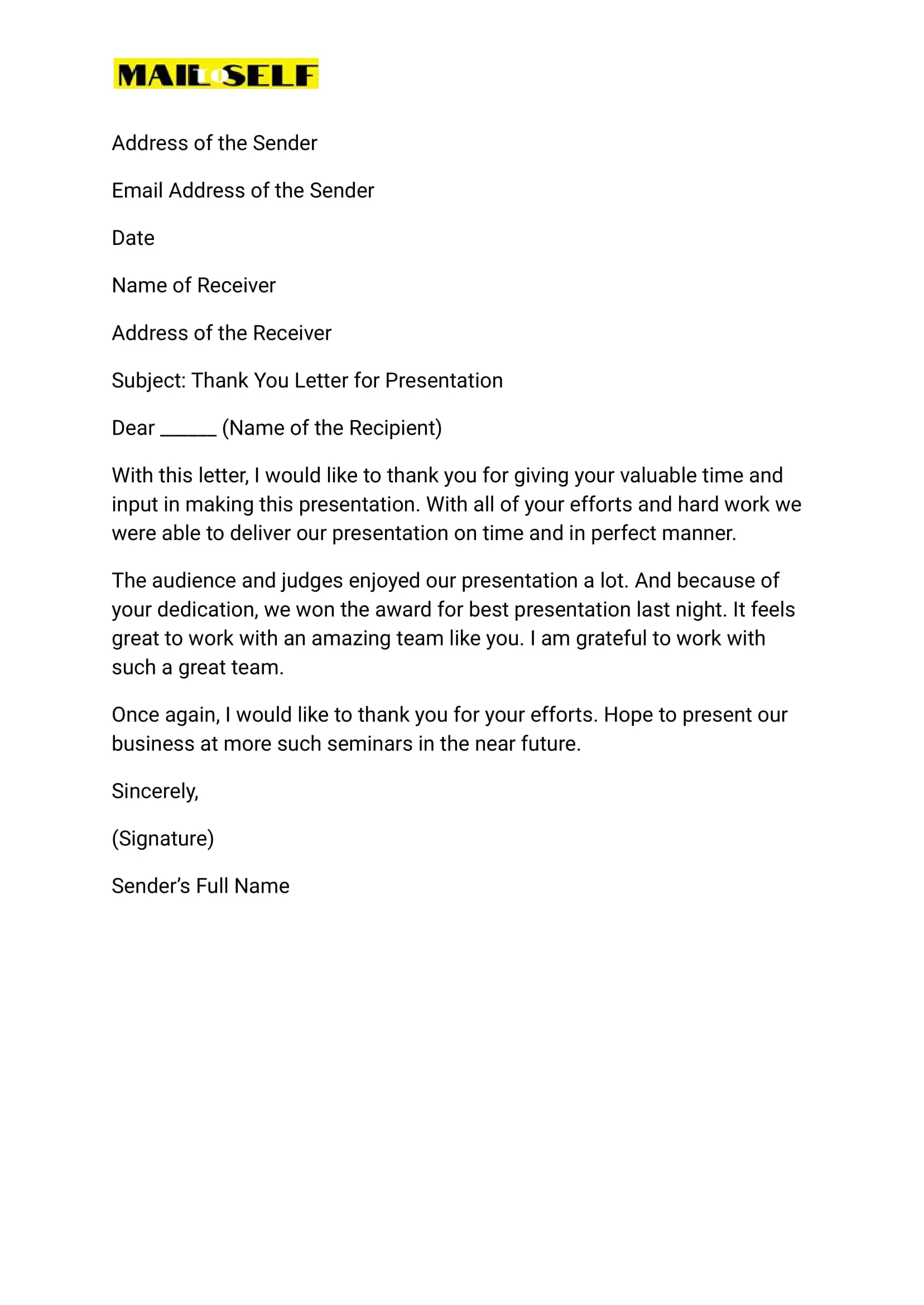
Sample 2- Thank You Note After Presentation to the Employee
Subject: Thank You Letter for presentation
I would like to thank you for delivering such an outstanding and amazing presentation last Monday. I am grateful to have an employee like you who is such a wonderful speaker. I am pleased to have you as a team member. Thank you for taking the initiative by participating and presenting our companies on such a big platform. Your work deserves appreciation.
Thank you once again for presenting our company’s values and aspects in all business conferences in such an interactive manner.
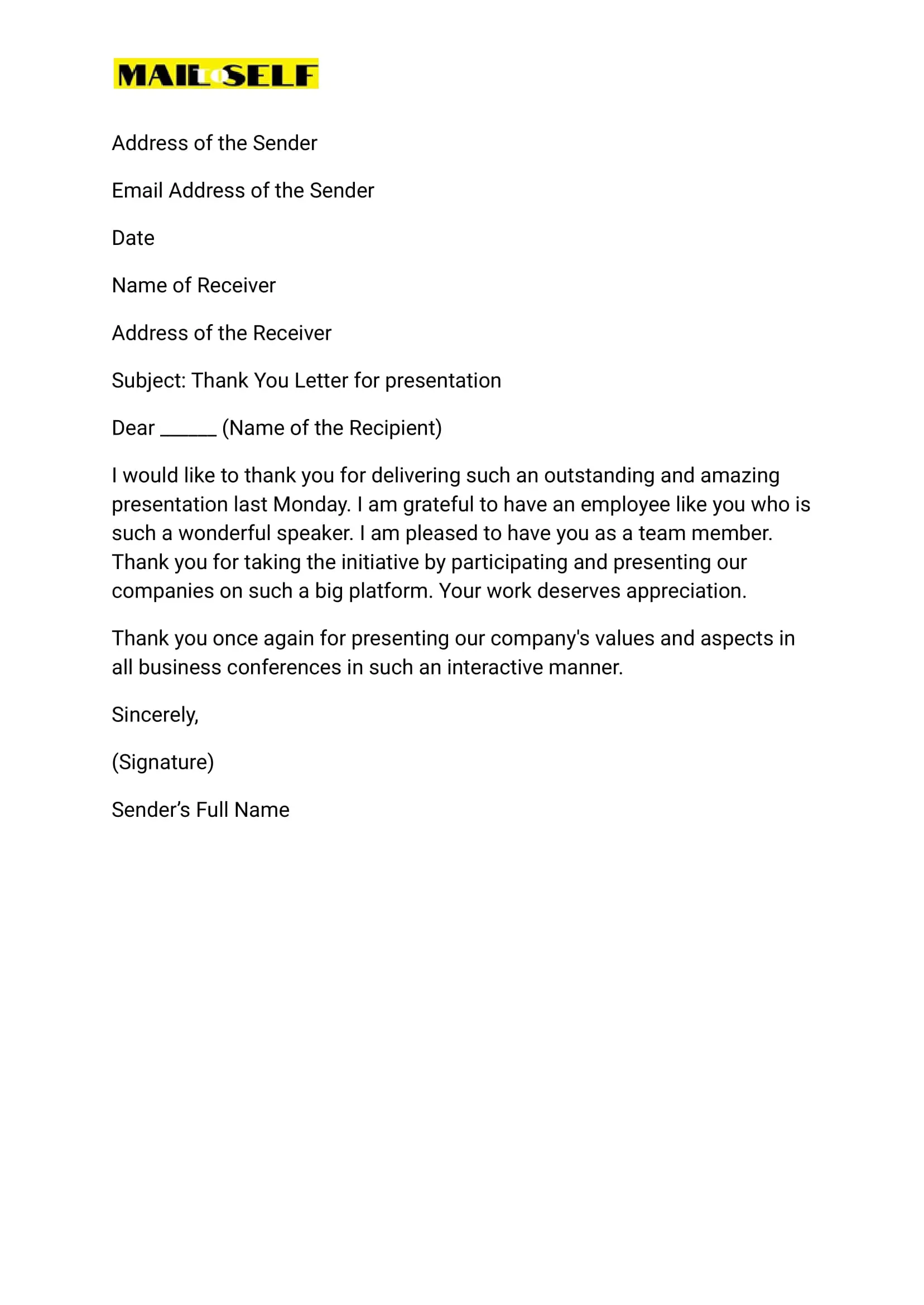
Sample 3- Thank You After Presentation to Attendees
With this letter I want to thank you for attending my presentation yesterday. I hope my presentation on ‘Drug Abuse’ will create a difference in everyone’s views. I am amazed to see how most of the people are not aware of illegal usage of drugs in our country. I am grateful to have such an amazing guest like you who has motivated me to speak on social topics and create awareness.
Thank you for inspiring me and supporting me in this cause. The kind of appreciation and moral support that you have given as an audience is invaluable. I hope to conduct a few more presentations for you on some major social topics. Once again, thank you.
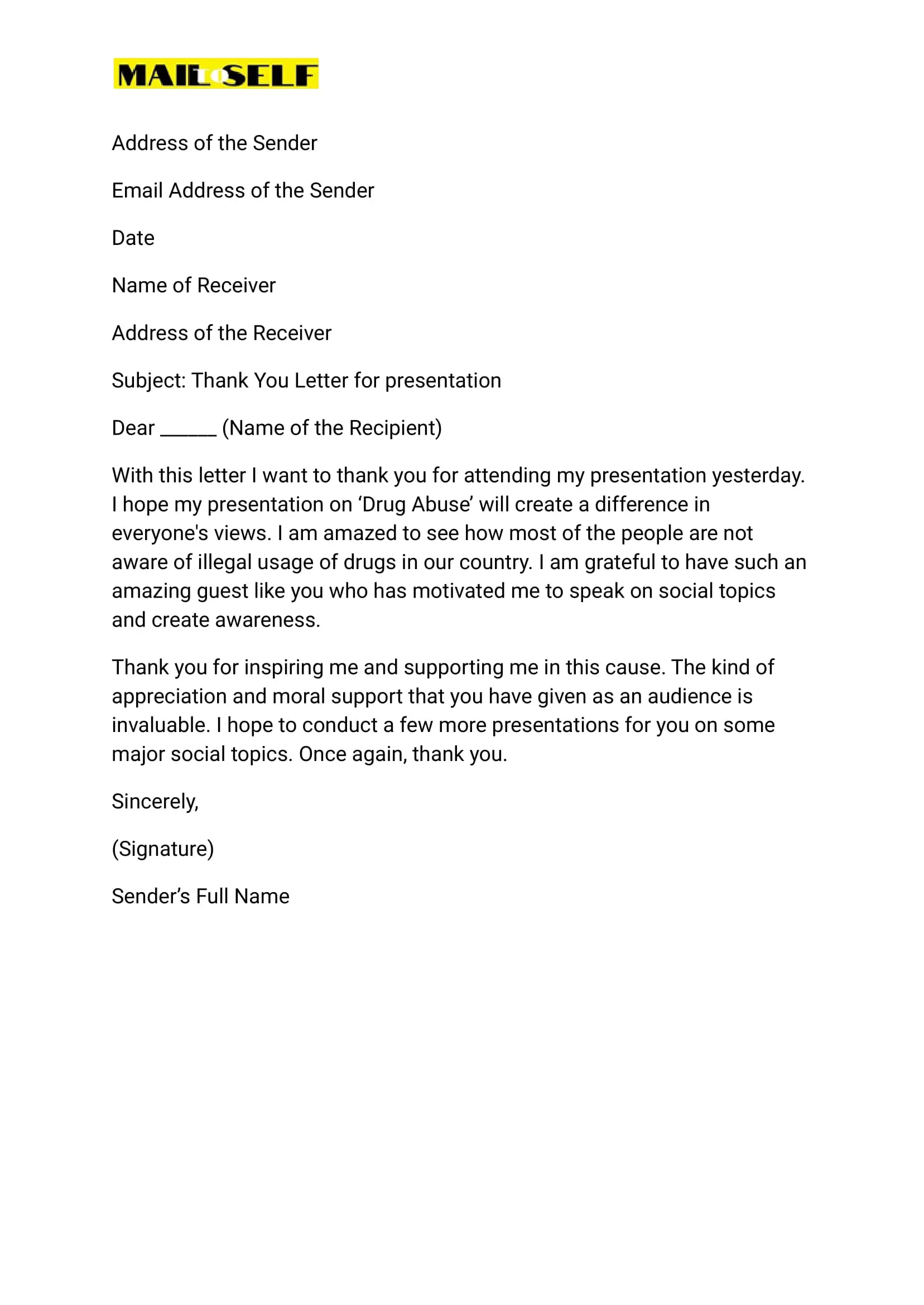
Sample 4- Thank You Note After Presentation for Sales Follow Up
Thank you for giving me such a great opportunity to share my business proposal with you over yesterday’s lunch meeting. Thank you for expressing your interest in our new project. I hope your doubts and points are now solved after yesterday’s presentation.
As per our discussion, I will send you the email listing the required documents which you need to submit before October XX,XXXX.
I look forward to hearing from you. Hoping for a positive response from your side. Thank you once again for taking out valuable time from your hectic schedule to attend the presentation.
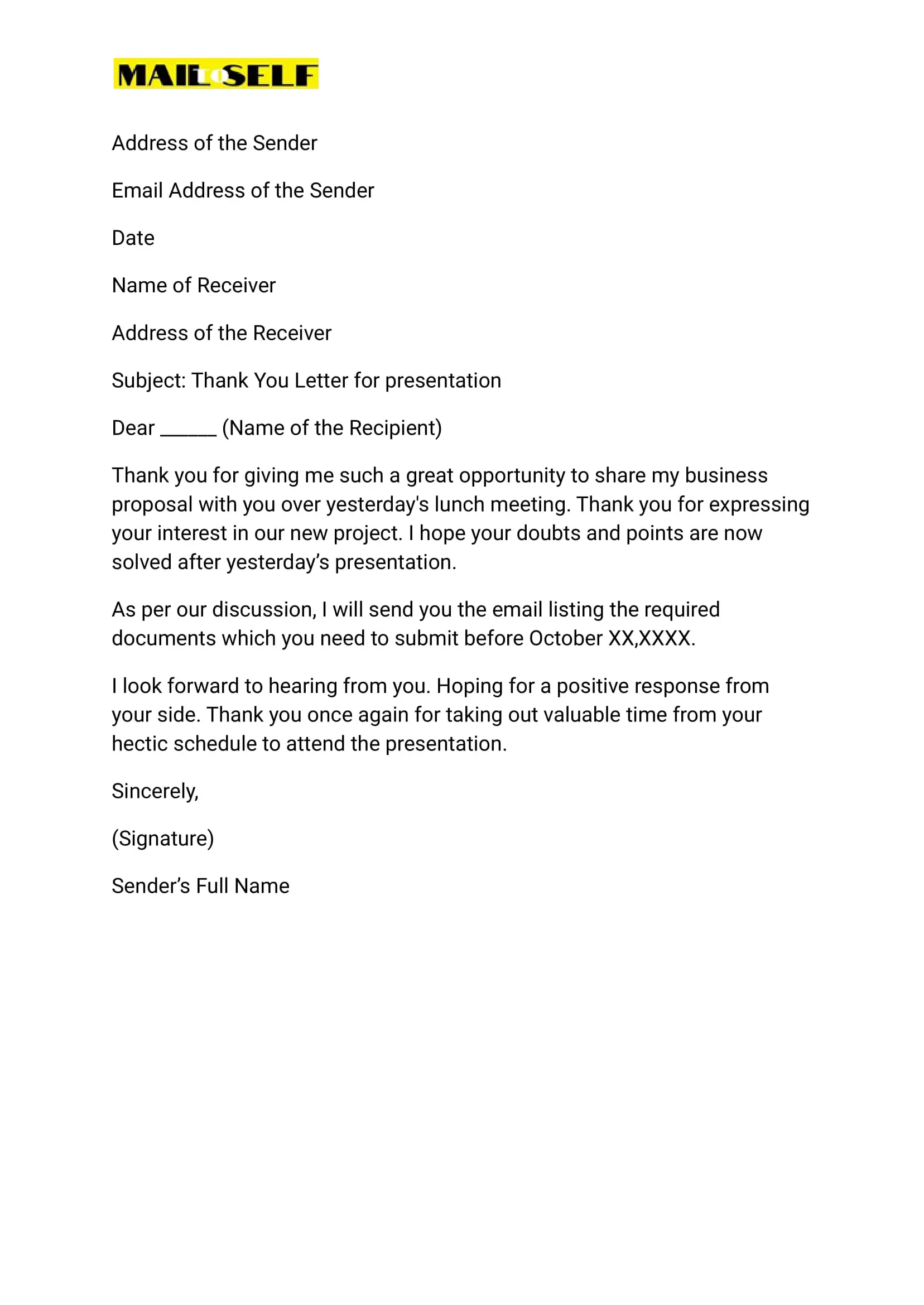
Sample 5- Thank You After Presentation to Presenter by College Principal
Subject: Thank You Letter after Presentation
On behalf of my college management, I would like to thank you for speaking and presenting your ideas on ‘Sustainable development’. All the students enjoyed the presentation and they seemed very motivated. Your thoughts were very inspiring and insightful for everyone. Your way of presenting your important thoughts with a bit of humour made the event more interesting.
Once again, thank you for sharing your innovative ideas and thoughts with us. I would like to thank you for giving our college an opportunity to host you. We look forward to hosting many such events in our college having you as presenter.
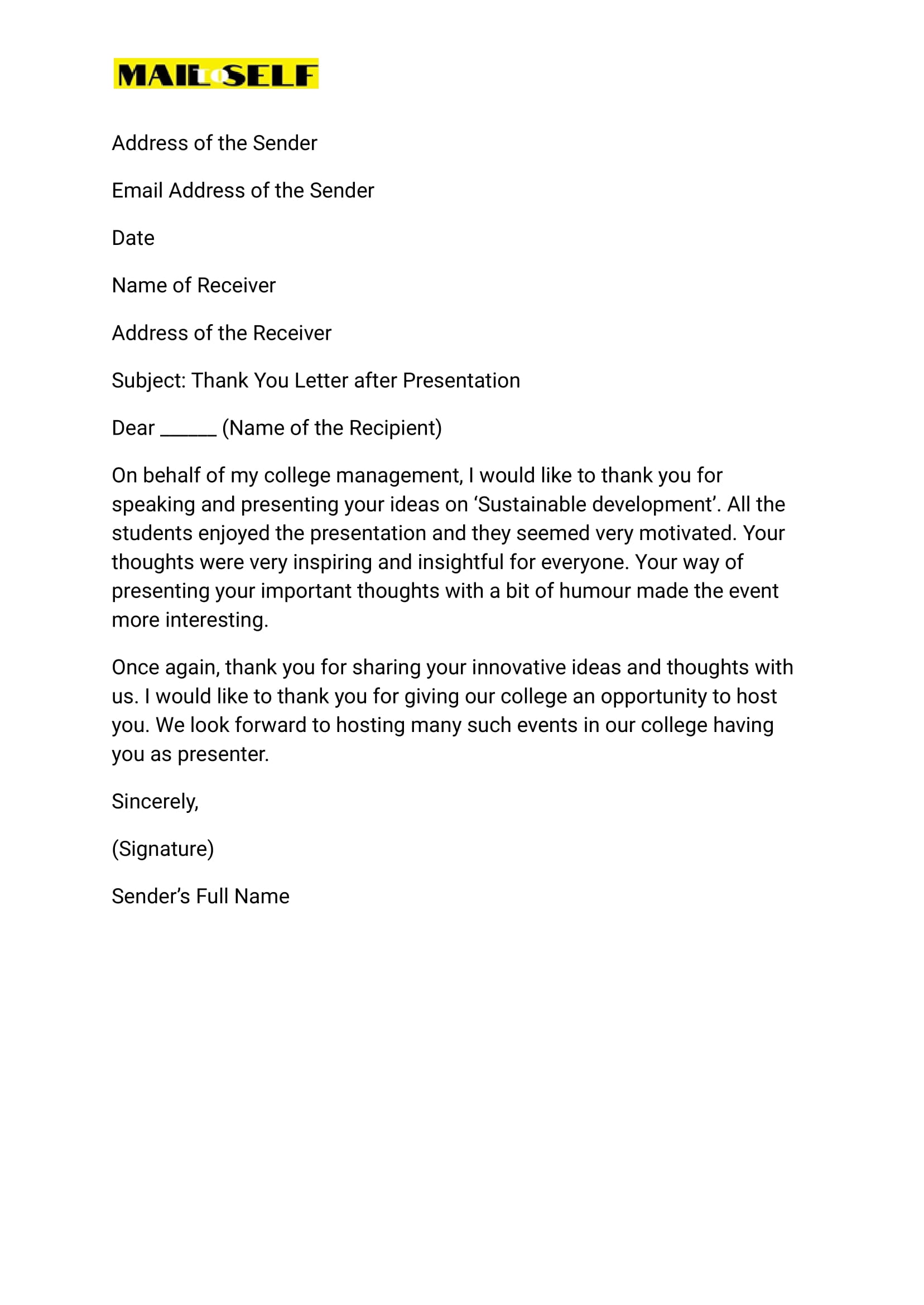
Sample 6- Thank You Note to Boss After Presentation
I would like to take a minute to thank you for giving me such a golden opportunity to deliver the presentation in front of our client. Thank you for trusting me and keeping faith in me and giving me such an important project. It is an amazing experience to work with you and learn new skills from you.
Your valuable feedback is very much inspiring and insightful. Thank you for sharing your ideas.
Thank you so much once again for being a supportive and ever guiding boss. Hope to see myself working with you and taking this company to great heights in the coming future.
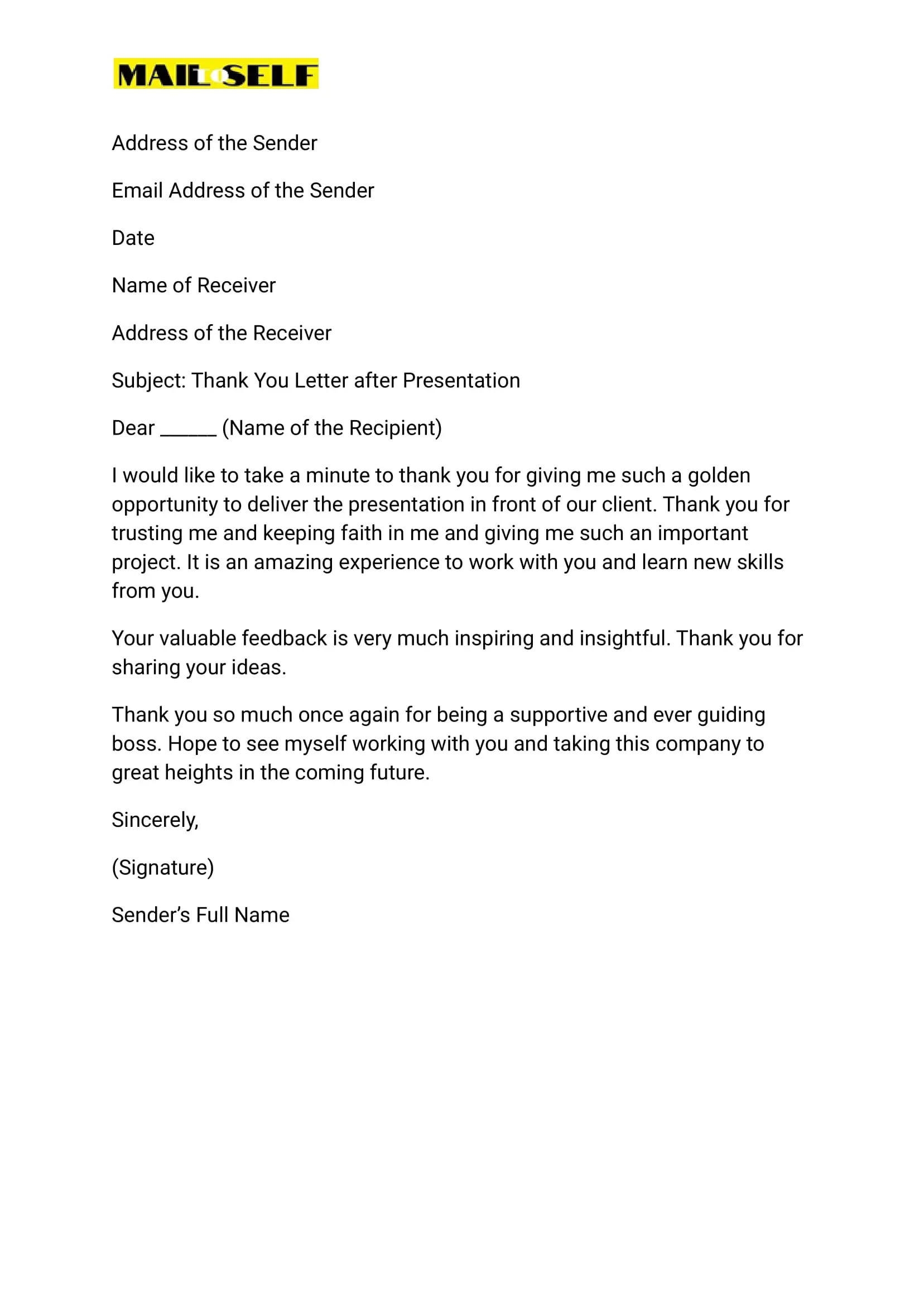
Invitation Acceptance Thank You Letter: How To, Templates & Examples

Thank You Letter After Job Fair: How To, Templates & Examples
© 2023 Mail To Self
How to Say Thank You in a Presentation: A Comprehensive Guide
Expressing gratitude is an essential aspect of any presentation. Whether you are delivering a business pitch, giving a speech, or presenting your ideas, showing appreciation towards your audience is crucial. In this comprehensive guide, we will explore different ways to say thank you in both formal and informal contexts. We will also provide tips, examples, and regional variations (if necessary) to help you master the art of expressing gratitude during your presentations.
Formal Ways to Say Thank You
When presenting in a formal setting, such as a professional conference, company meeting, or academic seminar, it is important to use a language that reflects professionalism and respects the formal environment. Here are a few formal ways to say thank you:
- Expressing Gratitude Verbally:
In a formal presentation, expressing your gratitude verbally can have a profound impact. Use phrases such as:
“I would like to express my sincere gratitude to all of you for being here today.”
“I am extremely grateful for the opportunity to address such an esteemed audience.”
Using Formal Language in Slides:
Alongside your verbal expressions of thanks, you can use gratitude-focused slides in your presentation. Incorporating phrases like “Thank You” or “We Appreciate Your Time” within your slides can emphasize your gratitude and leave a lasting impression.
Sending Follow-up Emails or Letters:
In highly formal situations, it can be advantageous to follow up with a thank-you email or letter. This will allow you to express your gratitude in a more personalized and detailed manner. Avoid using generic templates and make sure to tailor each message to show your sincere appreciation.
Informal Ways to Say Thank You
When presenting in an informal context, such as a team meeting or a casual gathering, you can use a more relaxed and casual language to express gratitude. Here are a few informal ways to say thank you:
- Using Informal Language:
Being less formal allows you to connect with your audience on a more personal level. You can use phrases like:
“I just wanted to say a big thank you to everyone who made this event possible!”
“I’m grateful to each of you for your contributions in making this project a success.”
Adding Humor and Light-heartedness:
In an informal setting, incorporating humor can create a positive and relaxed atmosphere. You can use light-hearted phrases to show your appreciation, such as:
“I want to give a huge shout-out to our amazing team. Without you, we’d be lost like a bunch of penguins in the desert!”
“I am so thankful to all of you for your hard work and dedication. You guys are the real MVPs!”
Using Visuals and Memes:
Incorporating visuals or memes into your presentation can add a touch of informality while expressing your gratitude. Using images or GIFs that convey appreciation can help your audience connect with your message on a more emotional level.
Tips for Expressing Gratitude in Presentations
Expressing gratitude is an art, and when done right, it can have a significant impact on your audience. Here are some tips to help you effectively express your thanks during your presentations:
- Show sincerity: Whether you are using formal or informal language, make sure your expressions of thanks are genuine and heartfelt. Avoid using generic phrases and strive to be authentic.
- Keep it concise: Expressing gratitude shouldn’t overshadow the main content of your presentation. Keep your thank-you messages concise and to the point, ensuring they don’t detract from the overall message you want to deliver.
- Be specific: When thanking individuals or groups, mention specific contributions they made or how they have positively impacted your presentation or project. This shows that you value their efforts and highlights their significance.
- Use non-verbal cues: In addition to verbal expressions, use non-verbal cues like smiles, nods, or even applause to further amplify your gratitude and create an atmosphere of appreciation.
- Consider cultural nuances: If presenting in a multicultural environment, be mindful of cultural differences when expressing gratitude. Conduct research to understand any regional variations in expressing thanks and tailor your approach accordingly.
Examples of Saying Thank You in Presentations
Here are a few examples showcasing different ways to say thank you in presentations:
“I want to take a moment to express my deepest appreciation for the unwavering support of our incredible team throughout this challenging project. Without each of you, we could not have accomplished such remarkable success. Thank you!”
“Thank you all for being here today. Your presence and engagement demonstrate your commitment to our shared goals. I am genuinely grateful for the opportunity to connect with such a remarkable audience.”
“To our partners and sponsors, thank you for believing in our vision and supporting us every step of the way. Your contribution has been invaluable, and we are tremendously thankful for your unwavering trust.”
Remember, expressing gratitude is about acknowledging and valuing others’ contributions. By incorporating these tips and examples into your presentations, you will create a lasting impact and foster positive relationships with your audience. Now, go out there and express your heartfelt appreciation!
Related Posts

Guide: How to Say "Thank You, but No Thank You"
When someone offers their help, opinion, or assistance, it is important to show gratitude and acknowledge their kindness even if you are unable to accept it. Expressing your appreciation while gently declining can maintain positive relationships and avoid hurt feelings. In this guide, we will explore formal and informal ways to say "thank you, but no thank you" and provide you with tips and examples for various situations.
Guide: How to Say "Thank You, but No Thank You" Politely
Expressing gratitude while declining an offer or invitation can be a delicate task. It's important to be both respectful and clear in your response. In this guide, we'll explore various ways to say "thank you, but no thank you" politely, catering to both formal and informal situations. While regional variations may exist, we will focus on widely accepted and applicable approaches. So, let's dive in and master the art of gracious declination!
Guide on How to Say "Thank You, but No Thank You" to a Job Offer
Receiving a job offer is an exciting moment in your professional journey. However, there may come a time when you need to decline an offer. It's crucial to handle this situation with grace and maintain positive relationships. In this guide, we'll explore formal and informal ways to express your gratitude while politely declining a job offer. Let's dive in!
How to Say Thank You for a Thank You: A Comprehensive Guide
Expressing gratitude is an essential part of building and maintaining strong relationships. Often, we find ourselves in the position of wanting to thank someone for their expressions of thanks. Whether in a formal or informal setting, it is important to respond with sincerity and warmth. In this guide, we will explore various ways to say thank you for a thank you, offering tips, examples, and regional variations where applicable.
How to Say Thank You for a Thank You Card: A Comprehensive Guide
Receiving a thank you card is a heartwarming gesture that deserves a thoughtful response. Expressing gratitude in return not only shows appreciation but also strengthens the bond between you and the sender. In this guide, we will explore various ways to say thank you for a thank you card, including formal and informal approaches. While regional variations exist, we'll focus on general tips and examples to help you craft the perfect response.
How to Say Thank You for a Thank You Email: A Comprehensive Guide
Responding to a thank you email with gratitude is a wonderful way to express appreciation and maintain strong relationships. Whether you're responding formally or informally, this guide will provide you with essential tips, examples, and variations to help you craft the perfect thank you response. Let's explore various approaches you can take!
Guide: How to Say Thank You for a Thank You Gift
Receiving a thank you gift is a wonderful gesture that deserves its own expression of gratitude. Whether you want to convey your appreciation in a formal or informal manner, knowing the right words to say can strengthen your connection with the person who thoughtfully recognized your kindness. In this guide, we will provide you with tips, examples, and regional variations on how to say thank you for a thank you gift. So, let's dive in!
How to Say Thank You for a Thank You Note
Receiving a thank you note is a heartwarming gesture that shows someone appreciates you. Whether you've received a thank you note for a kind act, a gift, or a simple act of support, responding with gratitude is the perfect way to reciprocate the sentiment. In this guide, we'll explore different ways to say thank you for a thank you note, both formally and informally. Here you'll find numerous tips, examples, and variations to express your gratitude!
Cancel reply
Save my name, email, and website in this browser for the next time I comment.
Arabic Cantonese Chinese Dutch English Farsi Filipino French German Greek Hawaiian Hebrew Hindi Irish Italian Japan Japanese Korean Latin Mandarin Mexican Navajo Norwegian Polish Portuguese Punjabi Romanian Russian Sanskrit Sign Language Spanish Swahili Swedish Tagalog Tamil Thai Turkish Ukrainian Urdu Vietnamese

- Privacy Policy
Compliment or Praise a Speaker • Example Letters, Guides and Samples
A speaker at a seminar, symposium, conference, meeting, or convention deserves your special compliments and praise if you benefited from his or her efforts. The speaker may wonder how the audience received the speech. A brief, sincere note with positive feedback will always be appreciated.
How to write this compliment letter:
- Tell the speaker that you enjoyed his or her speech.
- Mention specifically what you liked about the speech or presentation and, if appropriate, explain how you have personally benefited from the speech.
- Conclude by thanking the speaker.
Example Letter #1
I thoroughly enjoyed your presentation yesterday evening. Your delivery was so engaging that I lost all track of time. By any measure you are a very effective speaker and educator. I found your comments regarding future computers especially intriguing. On behalf of the Doe Corporation, thank you for a memorable presentation and hope you will visit us again.
Example Letter #2
We want to tell you how much we enjoyed your presentation to our study group last Friday. We have been reading a lot about the history of our state, and your illustrated talk made it all come alive for us. Those of us who have ancestors who settled this region were especially grateful for your discussion their contributions. It was thoughtful of you to add those personal observations. Your talk also gave a great boost to our efforts to recruit additional members. Thank you very much for an enlightening and stimulating presentation.
Example Letter #3
Congratulations on the speech you gave at the annual symposium last Friday. The topic was timely, and you presented the material on the new innovations in a way that everyone could understand. I personally feel much more confident working with the new system now than I did before your presentation. Thank you for a very valuable experience.
Write Your Letter Step-by-Step
1 Tell the speaker that you enjoyed his or her speech.
Sample Sentences for Step 1
- I enjoyed the lecture you gave at Doe University last Tuesday.
- I appreciated the speech you gave yesterday.
- I want to compliment you on your speech. It was very relevant to our current debates on funding local education.
- I am very grateful you took the time out of your busy schedule to address our small group.
- You gave a terrific presentation at this year's Doe symposium.
- We were all pleased with your topic for Saturday's lecture.
- Your comments the other evening were exactly what I needed to hear.
- Your discussion-group presentation was the highlight of the conference.
Sample Phrases for Step 1
- a most valuable addition to
- am glad that I attended your
- appreciate the time you gave
- express my appreciation for
- feel fortunate to have
- how much I appreciated
- the highlight of
- thoroughly enjoyed the
- want to compliment you on
- want you to know
- was a great success
- was a pleasure to listen to
- was most stimulating
- was one of the finest
- were enthralled by
- were so impressed with
- were very pleased with
- wish to express my appreciation for
- your fascinating presentation on
- your presentation was
- your insightful presentation
2 Mention specifically what you liked about the speech or presentation and, if appropriate, explain how you have personally benefited from the speech.
Sample Sentences for Step 2
- It was the best lecture of the year. You were witty and very informative.
- You maintained remarkable poise in the face of a potentially hostile audience.
- As usual, your speech brought new insights from current research. Your talks always motivate our staff to stick with their work.
- Your presentation drew the audience in and held their attention for two full hours. There was never a dull moment.
- I was glad you reserved a few minutes to field questions. Your answers were very insightful.
- It was a pleasure to hear your humorous stories.
- Your remarks triggered new ideas that will benefit our corporation for years to come.
- You helped kindle a renewed enthusiasm for my profession.
- I plan to implement some of your ideas with my own clientele.
- You gave me a new sense of pride in my career.
- We have already begun to implement some of your suggestions and are confident they will improve our manufacturing process.
- Since we have just purchased a new home, your remarks about personal money management were especially helpful.
- After listening to your report on the situation in Third World countries, I knew I had chosen the right course of study.
Sample Phrases for Step 2
- both the style and the substance of your
- both witty and informative
- brought new insights
- came alive for me
- clear, factual analysis
- delightfully entertaining
- gave rise to ongoing discussion
- gave me a new sense of
- have already taken steps to
- heartily agree with you that
- hit the nail on the head
- imaginative presentation of
- intelligent, well thought-out solutions to
- particularly appreciated your
- plan to implement your
- put some of your ideas into practice
- rekindled an enthusiasm for
- triggered new ideas
- used humor to make your point
- valuable information you gave
- were especially helpful
- will certainly help me in
- your in-depth knowledge of
- your original approach to
3 Conclude by thanking the speaker.
Sample Sentences for Step 3
- Thank you for your helpful comments.
- Thank you for your enlightening speech.
- I appreciated your lecture and felt as if you were speaking directly to me.
- Please accept our thanks for a great presentation
- Thank you for speaking to us this week.
- We thank you for your stimulating speech.
Sample Phrases for Step 3
- accept our thanks for
- am grateful for
- best wishes for
- for an outstanding
- for all the
- for your time and effort
- for adding so much to our
- for speaking at our
- giving us such a worthwhile
- hope you will be able to
- it was our privilege to
- look forward to
- on behalf of
- such an excellent
- thank you once again for
- thank you for
- will be sure to
- wish you continued success
- your most helpful
Recommended Letter-Writing Resources

Action Verbs for Resumes and Cover Letters

Business Letter Format Tips

Letter Closings
7 Brilliant Ways to End Any Presentation: When to Use a Presentation Thank You Address
I like building and growing simple yet powerful products for the world and the worldwide web.
Published Date : December 4, 2020
Reading Time :
As important as an introduction is to a Speech <p data-sourcepos="3:1-3:271">A form of communication involving spoken language, it is used to express ideas, share information, tell stories, persuade, or entertain. Public speaking is a powerful tool used in diverse contexts, ranging from casual conversations to formal presentations.</p><br /><h2 data-sourcepos="5:1-5:27"><strong>Components of a Speech:</strong></h2> <ul data-sourcepos="7:1-10:0"> <li data-sourcepos="7:1-7:73"><strong>Content:</strong> The information, message, or story conveyed through words.</li> <li data-sourcepos="8:1-8:106"><strong>Delivery:</strong> The vocal and physical presentation, including clarity, volume, gestures, and eye contact.</li> <li data-sourcepos="9:1-10:0"><strong>Structure:</strong> The organization of the content, typically following an introduction, body, and conclusion.</li> </ul> <h2 data-sourcepos="11:1-11:21"><strong>Speech in Action:</strong></h2> <ul data-sourcepos="13:1-17:0"> <li data-sourcepos="13:1-13:88"><strong>Informing:</strong> Sharing knowledge and facts, educating an audience on a specific topic.</li> <li data-sourcepos="14:1-14:119"><strong>Persuading:</strong> Advocating for a particular viewpoint, using arguments and evidence to influence thoughts or actions.</li> <li data-sourcepos="15:1-15:93"><strong>Motivating:</strong> Inspiring and energizing an audience, fostering action and positive change.</li> <li data-sourcepos="16:1-17:0"><strong>Entertaining:</strong> Engaging and delighting an audience through humor, storytelling, or creative language.</li> </ul> <h2 data-sourcepos="18:1-18:32"><strong>Public Speaking and Anxiety:</strong></h2> <p data-sourcepos="20:1-20:227">Many people experience <strong>public speaking anxiety</strong>, a fear of speaking in front of an audience. While it's common, effective preparation, practice, and breathing techniques can significantly reduce anxiety and improve delivery.</p><br /><h2 data-sourcepos="22:1-22:32"><strong>Different Types of Speeches:</strong></h2> <ul data-sourcepos="24:1-28:0"> <li data-sourcepos="24:1-24:81"><strong>Informative speech:</strong> Focuses on conveying information clearly and concisely.</li> <li data-sourcepos="25:1-25:102"><strong>Persuasive speech:</strong> Aims to convince the audience to adopt a particular viewpoint or take action.</li> <li data-sourcepos="26:1-26:99"><strong>Motivational speech:</strong> Inspires and energizes the audience, building enthusiasm and commitment.</li> <li data-sourcepos="27:1-28:0"><strong>Entertaining speech:</strong> Aim to amuse and delight the audience, often using humor, storytelling, or anecdotes.</li> </ul> <h2 data-sourcepos="29:1-29:33"><strong>Crafting a Compelling Speech:</strong></h2> <ul data-sourcepos="31:1-35:0"> <li data-sourcepos="31:1-31:106"><strong>Know your audience:</strong> Tailor your content and delivery to their interests, needs, and prior knowledge.</li> <li data-sourcepos="32:1-32:107"><strong>Have a clear message:</strong> Identify the main point you want to convey and structure your speech around it.</li> <li data-sourcepos="33:1-33:111"><strong>Engage your audience:</strong> Use varied vocal techniques, storytelling, and visual aids to keep them interested.</li> <li data-sourcepos="34:1-35:0"><strong>Practice, practice, practice:</strong> Rehearse your speech out loud to refine your delivery and build confidence.</li> </ul> <h2 data-sourcepos="36:1-36:13"><strong>Remember:</strong></h2> <p data-sourcepos="38:1-38:281">Speech is a powerful tool for communication, connection, and influence. By understanding its elements, addressing potential anxieties, and tailoring your delivery to different contexts, you can harness the power of speech to achieve your intended goals and captivate your audience.</p> " href="https://orai.com/glossary/speech/" data-gt-translate-attributes="[{"attribute":"data-cmtooltip", "format":"html"}]" tabindex="0" role="link">speech presentation, the end of your presentation is what you leave your audience with. Giving a proper presentation thank you address is a helpful public speaking skill .
When is it appropriate to simply say “thank you” and close your presentation?
In what moments does a presentation require more from you?
How do you tell your audience to thank you for watching my presentation if you made a visual presentation?
What is the importance of saying thank you to your audience for listening?
We intend to answer all these questions in this article, and we hope you read the whole page to understand the complete concept of the presentation. Thank you.
How Should I End a Presentation? Different Ways of Ending a Speech Or a Presentation
As a Speech <p data-sourcepos="3:1-3:271">A form of communication involving spoken language, it is used to express ideas, share information, tell stories, persuade, or entertain. Public speaking is a powerful tool used in diverse contexts, ranging from casual conversations to formal presentations.</p><br /><h2 data-sourcepos="5:1-5:27"><strong>Components of a Speech:</strong></h2> <ul data-sourcepos="7:1-10:0"> <li data-sourcepos="7:1-7:73"><strong>Content:</strong> The information, message, or story conveyed through words.</li> <li data-sourcepos="8:1-8:106"><strong>Delivery:</strong> The vocal and physical presentation, including clarity, volume, gestures, and eye contact.</li> <li data-sourcepos="9:1-10:0"><strong>Structure:</strong> The organization of the content, typically following an introduction, body, and conclusion.</li> </ul> <h2 data-sourcepos="11:1-11:21"><strong>Speech in Action:</strong></h2> <ul data-sourcepos="13:1-17:0"> <li data-sourcepos="13:1-13:88"><strong>Informing:</strong> Sharing knowledge and facts, educating an audience on a specific topic.</li> <li data-sourcepos="14:1-14:119"><strong>Persuading:</strong> Advocating for a particular viewpoint, using arguments and evidence to influence thoughts or actions.</li> <li data-sourcepos="15:1-15:93"><strong>Motivating:</strong> Inspiring and energizing an audience, fostering action and positive change.</li> <li data-sourcepos="16:1-17:0"><strong>Entertaining:</strong> Engaging and delighting an audience through humor, storytelling, or creative language.</li> </ul> <h2 data-sourcepos="18:1-18:32"><strong>Public Speaking and Anxiety:</strong></h2> <p data-sourcepos="20:1-20:227">Many people experience <strong>public speaking anxiety</strong>, a fear of speaking in front of an audience. While it's common, effective preparation, practice, and breathing techniques can significantly reduce anxiety and improve delivery.</p><br /><h2 data-sourcepos="22:1-22:32"><strong>Different Types of Speeches:</strong></h2> <ul data-sourcepos="24:1-28:0"> <li data-sourcepos="24:1-24:81"><strong>Informative speech:</strong> Focuses on conveying information clearly and concisely.</li> <li data-sourcepos="25:1-25:102"><strong>Persuasive speech:</strong> Aims to convince the audience to adopt a particular viewpoint or take action.</li> <li data-sourcepos="26:1-26:99"><strong>Motivational speech:</strong> Inspires and energizes the audience, building enthusiasm and commitment.</li> <li data-sourcepos="27:1-28:0"><strong>Entertaining speech:</strong> Aim to amuse and delight the audience, often using humor, storytelling, or anecdotes.</li> </ul> <h2 data-sourcepos="29:1-29:33"><strong>Crafting a Compelling Speech:</strong></h2> <ul data-sourcepos="31:1-35:0"> <li data-sourcepos="31:1-31:106"><strong>Know your audience:</strong> Tailor your content and delivery to their interests, needs, and prior knowledge.</li> <li data-sourcepos="32:1-32:107"><strong>Have a clear message:</strong> Identify the main point you want to convey and structure your speech around it.</li> <li data-sourcepos="33:1-33:111"><strong>Engage your audience:</strong> Use varied vocal techniques, storytelling, and visual aids to keep them interested.</li> <li data-sourcepos="34:1-35:0"><strong>Practice, practice, practice:</strong> Rehearse your speech out loud to refine your delivery and build confidence.</li> </ul> <h2 data-sourcepos="36:1-36:13"><strong>Remember:</strong></h2> <p data-sourcepos="38:1-38:281">Speech is a powerful tool for communication, connection, and influence. By understanding its elements, addressing potential anxieties, and tailoring your delivery to different contexts, you can harness the power of speech to achieve your intended goals and captivate your audience.</p> " href="https://orai.com/glossary/speech/" data-gt-translate-attributes="[{"attribute":"data-cmtooltip", "format":"html"}]" tabindex="0" role="link">speech expert who has attended many presentations and orations, I can tell that each presenter concludes their Speech <p data-sourcepos="3:1-3:271">A form of communication involving spoken language, it is used to express ideas, share information, tell stories, persuade, or entertain. Public speaking is a powerful tool used in diverse contexts, ranging from casual conversations to formal presentations.</p><br /><h2 data-sourcepos="5:1-5:27"><strong>Components of a Speech:</strong></h2> <ul data-sourcepos="7:1-10:0"> <li data-sourcepos="7:1-7:73"><strong>Content:</strong> The information, message, or story conveyed through words.</li> <li data-sourcepos="8:1-8:106"><strong>Delivery:</strong> The vocal and physical presentation, including clarity, volume, gestures, and eye contact.</li> <li data-sourcepos="9:1-10:0"><strong>Structure:</strong> The organization of the content, typically following an introduction, body, and conclusion.</li> </ul> <h2 data-sourcepos="11:1-11:21"><strong>Speech in Action:</strong></h2> <ul data-sourcepos="13:1-17:0"> <li data-sourcepos="13:1-13:88"><strong>Informing:</strong> Sharing knowledge and facts, educating an audience on a specific topic.</li> <li data-sourcepos="14:1-14:119"><strong>Persuading:</strong> Advocating for a particular viewpoint, using arguments and evidence to influence thoughts or actions.</li> <li data-sourcepos="15:1-15:93"><strong>Motivating:</strong> Inspiring and energizing an audience, fostering action and positive change.</li> <li data-sourcepos="16:1-17:0"><strong>Entertaining:</strong> Engaging and delighting an audience through humor, storytelling, or creative language.</li> </ul> <h2 data-sourcepos="18:1-18:32"><strong>Public Speaking and Anxiety:</strong></h2> <p data-sourcepos="20:1-20:227">Many people experience <strong>public speaking anxiety</strong>, a fear of speaking in front of an audience. While it's common, effective preparation, practice, and breathing techniques can significantly reduce anxiety and improve delivery.</p><br /><h2 data-sourcepos="22:1-22:32"><strong>Different Types of Speeches:</strong></h2> <ul data-sourcepos="24:1-28:0"> <li data-sourcepos="24:1-24:81"><strong>Informative speech:</strong> Focuses on conveying information clearly and concisely.</li> <li data-sourcepos="25:1-25:102"><strong>Persuasive speech:</strong> Aims to convince the audience to adopt a particular viewpoint or take action.</li> <li data-sourcepos="26:1-26:99"><strong>Motivational speech:</strong> Inspires and energizes the audience, building enthusiasm and commitment.</li> <li data-sourcepos="27:1-28:0"><strong>Entertaining speech:</strong> Aim to amuse and delight the audience, often using humor, storytelling, or anecdotes.</li> </ul> <h2 data-sourcepos="29:1-29:33"><strong>Crafting a Compelling Speech:</strong></h2> <ul data-sourcepos="31:1-35:0"> <li data-sourcepos="31:1-31:106"><strong>Know your audience:</strong> Tailor your content and delivery to their interests, needs, and prior knowledge.</li> <li data-sourcepos="32:1-32:107"><strong>Have a clear message:</strong> Identify the main point you want to convey and structure your speech around it.</li> <li data-sourcepos="33:1-33:111"><strong>Engage your audience:</strong> Use varied vocal techniques, storytelling, and visual aids to keep them interested.</li> <li data-sourcepos="34:1-35:0"><strong>Practice, practice, practice:</strong> Rehearse your speech out loud to refine your delivery and build confidence.</li> </ul> <h2 data-sourcepos="36:1-36:13"><strong>Remember:</strong></h2> <p data-sourcepos="38:1-38:281">Speech is a powerful tool for communication, connection, and influence. By understanding its elements, addressing potential anxieties, and tailoring your delivery to different contexts, you can harness the power of speech to achieve your intended goals and captivate your audience.</p> " href="https://orai.com/glossary/speech/" data-gt-translate-attributes="[{"attribute":"data-cmtooltip", "format":"html"}]" tabindex="0" role="link">speech in different ways. Most speakers will showcase presentation thank you images as a visual aid at the end of a PowerPoint, while others give a summary.
Irrespective of the speaker’s methods, here are seven ways to end a presentation or speech .
1. Closing with a Summary
Summarizing key points of your Speech <p data-sourcepos="3:1-3:271">A form of communication involving spoken language, it is used to express ideas, share information, tell stories, persuade, or entertain. Public speaking is a powerful tool used in diverse contexts, ranging from casual conversations to formal presentations.</p><br /><h2 data-sourcepos="5:1-5:27"><strong>Components of a Speech:</strong></h2> <ul data-sourcepos="7:1-10:0"> <li data-sourcepos="7:1-7:73"><strong>Content:</strong> The information, message, or story conveyed through words.</li> <li data-sourcepos="8:1-8:106"><strong>Delivery:</strong> The vocal and physical presentation, including clarity, volume, gestures, and eye contact.</li> <li data-sourcepos="9:1-10:0"><strong>Structure:</strong> The organization of the content, typically following an introduction, body, and conclusion.</li> </ul> <h2 data-sourcepos="11:1-11:21"><strong>Speech in Action:</strong></h2> <ul data-sourcepos="13:1-17:0"> <li data-sourcepos="13:1-13:88"><strong>Informing:</strong> Sharing knowledge and facts, educating an audience on a specific topic.</li> <li data-sourcepos="14:1-14:119"><strong>Persuading:</strong> Advocating for a particular viewpoint, using arguments and evidence to influence thoughts or actions.</li> <li data-sourcepos="15:1-15:93"><strong>Motivating:</strong> Inspiring and energizing an audience, fostering action and positive change.</li> <li data-sourcepos="16:1-17:0"><strong>Entertaining:</strong> Engaging and delighting an audience through humor, storytelling, or creative language.</li> </ul> <h2 data-sourcepos="18:1-18:32"><strong>Public Speaking and Anxiety:</strong></h2> <p data-sourcepos="20:1-20:227">Many people experience <strong>public speaking anxiety</strong>, a fear of speaking in front of an audience. While it's common, effective preparation, practice, and breathing techniques can significantly reduce anxiety and improve delivery.</p><br /><h2 data-sourcepos="22:1-22:32"><strong>Different Types of Speeches:</strong></h2> <ul data-sourcepos="24:1-28:0"> <li data-sourcepos="24:1-24:81"><strong>Informative speech:</strong> Focuses on conveying information clearly and concisely.</li> <li data-sourcepos="25:1-25:102"><strong>Persuasive speech:</strong> Aims to convince the audience to adopt a particular viewpoint or take action.</li> <li data-sourcepos="26:1-26:99"><strong>Motivational speech:</strong> Inspires and energizes the audience, building enthusiasm and commitment.</li> <li data-sourcepos="27:1-28:0"><strong>Entertaining speech:</strong> Aim to amuse and delight the audience, often using humor, storytelling, or anecdotes.</li> </ul> <h2 data-sourcepos="29:1-29:33"><strong>Crafting a Compelling Speech:</strong></h2> <ul data-sourcepos="31:1-35:0"> <li data-sourcepos="31:1-31:106"><strong>Know your audience:</strong> Tailor your content and delivery to their interests, needs, and prior knowledge.</li> <li data-sourcepos="32:1-32:107"><strong>Have a clear message:</strong> Identify the main point you want to convey and structure your speech around it.</li> <li data-sourcepos="33:1-33:111"><strong>Engage your audience:</strong> Use varied vocal techniques, storytelling, and visual aids to keep them interested.</li> <li data-sourcepos="34:1-35:0"><strong>Practice, practice, practice:</strong> Rehearse your speech out loud to refine your delivery and build confidence.</li> </ul> <h2 data-sourcepos="36:1-36:13"><strong>Remember:</strong></h2> <p data-sourcepos="38:1-38:281">Speech is a powerful tool for communication, connection, and influence. By understanding its elements, addressing potential anxieties, and tailoring your delivery to different contexts, you can harness the power of speech to achieve your intended goals and captivate your audience.</p> " href="https://orai.com/glossary/speech/" data-gt-translate-attributes="[{"attribute":"data-cmtooltip", "format":"html"}]" tabindex="0" role="link">speech when concluding an oration is an age-old method of finishing your address. It is a technique speakers and writers use to close and ensure their audience remembers their main point.
Using a summary for closure is common with lectures and the traditional presentation thank-you addresses.
2. Closing with the Power of Three
The Power of Three uses a pattern of three words, phrases, or more to emphasize a point and make it more memorable. A typical phrase Julius Caesar uses is “I came, I saw, I conquered.”
3. Closing with Metaphors
Metaphors are a figure of Speech <p data-sourcepos="3:1-3:271">A form of communication involving spoken language, it is used to express ideas, share information, tell stories, persuade, or entertain. Public speaking is a powerful tool used in diverse contexts, ranging from casual conversations to formal presentations.</p><br /><h2 data-sourcepos="5:1-5:27"><strong>Components of a Speech:</strong></h2> <ul data-sourcepos="7:1-10:0"> <li data-sourcepos="7:1-7:73"><strong>Content:</strong> The information, message, or story conveyed through words.</li> <li data-sourcepos="8:1-8:106"><strong>Delivery:</strong> The vocal and physical presentation, including clarity, volume, gestures, and eye contact.</li> <li data-sourcepos="9:1-10:0"><strong>Structure:</strong> The organization of the content, typically following an introduction, body, and conclusion.</li> </ul> <h2 data-sourcepos="11:1-11:21"><strong>Speech in Action:</strong></h2> <ul data-sourcepos="13:1-17:0"> <li data-sourcepos="13:1-13:88"><strong>Informing:</strong> Sharing knowledge and facts, educating an audience on a specific topic.</li> <li data-sourcepos="14:1-14:119"><strong>Persuading:</strong> Advocating for a particular viewpoint, using arguments and evidence to influence thoughts or actions.</li> <li data-sourcepos="15:1-15:93"><strong>Motivating:</strong> Inspiring and energizing an audience, fostering action and positive change.</li> <li data-sourcepos="16:1-17:0"><strong>Entertaining:</strong> Engaging and delighting an audience through humor, storytelling, or creative language.</li> </ul> <h2 data-sourcepos="18:1-18:32"><strong>Public Speaking and Anxiety:</strong></h2> <p data-sourcepos="20:1-20:227">Many people experience <strong>public speaking anxiety</strong>, a fear of speaking in front of an audience. While it's common, effective preparation, practice, and breathing techniques can significantly reduce anxiety and improve delivery.</p><br /><h2 data-sourcepos="22:1-22:32"><strong>Different Types of Speeches:</strong></h2> <ul data-sourcepos="24:1-28:0"> <li data-sourcepos="24:1-24:81"><strong>Informative speech:</strong> Focuses on conveying information clearly and concisely.</li> <li data-sourcepos="25:1-25:102"><strong>Persuasive speech:</strong> Aims to convince the audience to adopt a particular viewpoint or take action.</li> <li data-sourcepos="26:1-26:99"><strong>Motivational speech:</strong> Inspires and energizes the audience, building enthusiasm and commitment.</li> <li data-sourcepos="27:1-28:0"><strong>Entertaining speech:</strong> Aim to amuse and delight the audience, often using humor, storytelling, or anecdotes.</li> </ul> <h2 data-sourcepos="29:1-29:33"><strong>Crafting a Compelling Speech:</strong></h2> <ul data-sourcepos="31:1-35:0"> <li data-sourcepos="31:1-31:106"><strong>Know your audience:</strong> Tailor your content and delivery to their interests, needs, and prior knowledge.</li> <li data-sourcepos="32:1-32:107"><strong>Have a clear message:</strong> Identify the main point you want to convey and structure your speech around it.</li> <li data-sourcepos="33:1-33:111"><strong>Engage your audience:</strong> Use varied vocal techniques, storytelling, and visual aids to keep them interested.</li> <li data-sourcepos="34:1-35:0"><strong>Practice, practice, practice:</strong> Rehearse your speech out loud to refine your delivery and build confidence.</li> </ul> <h2 data-sourcepos="36:1-36:13"><strong>Remember:</strong></h2> <p data-sourcepos="38:1-38:281">Speech is a powerful tool for communication, connection, and influence. By understanding its elements, addressing potential anxieties, and tailoring your delivery to different contexts, you can harness the power of speech to achieve your intended goals and captivate your audience.</p> " href="https://orai.com/glossary/speech/" data-gt-translate-attributes="[{"attribute":"data-cmtooltip", "format":"html"}]" tabindex="0" role="link">speech that compares two entities figuratively and makes it seem like they are the same. In basic English Language, the definition of metaphors indicates a form of comparison without using comparative words (for example, like and as).
It is ideal for Motivational speech <p data-sourcepos="3:1-3:374">A <strong>motivational speech</strong> aims to inspire, encourage, and energize an audience. It ignites their passion, sparks action, and instills a sense of belief in themselves and their ability to achieve their goals. It is a powerful tool used in <strong>professional speaking</strong> to boost morale, drive performance, and foster a positive and collaborative environment.</p><br /><h2 data-sourcepos="5:1-5:17"><strong>Key Elements:</strong></h2> <ul data-sourcepos="7:1-12:0"> <li data-sourcepos="7:1-7:145"><strong>Compelling vision:</strong> Articulate a clear and inspiring vision for the future, outlining goals and aspirations that resonate with the audience.</li> <li data-sourcepos="8:1-8:140"><strong>Empathy and understanding:</strong> Acknowledge challenges and obstacles, demonstrating empathy and connection with the audience's experiences.</li> <li data-sourcepos="9:1-9:134"><strong>Empowering message:</strong> Focus on empowering the audience, emphasizing their strengths, potential, and ability to overcome obstacles.</li> <li data-sourcepos="10:1-10:170"><strong>Storytelling and anecdotes:</strong> Integrate relatable stories, personal experiences, or inspiring examples to illustrate points and connect with the audience emotionally.</li> <li data-sourcepos="11:1-12:0"><strong>Call to action:</strong> Provide a clear and actionable call to action, motivating the audience to take specific steps towards achieving their goals.</li> </ul> <h2 data-sourcepos="13:1-13:38"><strong>Benefits of Motivational Speeches:</strong></h2> <ul data-sourcepos="15:1-20:0"> <li data-sourcepos="15:1-15:116"><strong>Boosts morale and motivation:</strong> Inspires individuals to strive for their full potential and overcome challenges.</li> <li data-sourcepos="16:1-16:142"><strong>Promotes teamwork and collaboration:</strong> Fosters a shared purpose and encourages individuals to work together towards common goals.</li> <li data-sourcepos="17:1-17:118"><strong>Enhances confidence and self-belief:</strong> Empowers individuals to believe in themselves and their ability to succeed.</li> <li data-sourcepos="18:1-18:121"><strong>Increases creativity and innovation:</strong> Inspires individuals to think outside the box and pursue innovative solutions.</li> <li data-sourcepos="19:1-20:0"><strong>Drives positive change:</strong> Motivates individuals to take action and contribute to positive change in their personal and professional lives.</li> </ul> <h2 data-sourcepos="21:1-21:46"><strong>Developing a Powerful Motivational Speech:</strong></h2> <ul data-sourcepos="23:1-28:0"> <li data-sourcepos="23:1-23:96"><strong>Define your purpose:</strong> Identify the desired outcome you want your speech to achieve.</li> <li data-sourcepos="24:1-24:119"><strong>Know your audience:</strong> Understand their motivations, challenges, and aspirations to tailor your message effectively.</li> <li data-sourcepos="25:1-25:134"><strong>Focus on storytelling:</strong> Use compelling stories and anecdotes to illustrate your points and connect with the audience emotionally.</li> <li data-sourcepos="26:1-26:170"><strong>Practice and rehearse:</strong> Hone your delivery to refine timing, vocal variety, and stage presence. Consider using <strong>public speaking tips</strong> to enhance your presentation.</li> <li data-sourcepos="27:1-28:0"><strong>Deliver with passion and authenticity:</strong> Inject your enthusiasm and genuine belief in your message to inspire the audience.</li> </ul> <h2 data-sourcepos="29:1-29:20"><strong>Additional Tips:</strong></h2> <ul data-sourcepos="31:1-35:0"> <li data-sourcepos="31:1-31:123"><strong>Use humor strategically:</strong> Use humor appropriately to lighten the mood and connect with the audience on a deeper level.</li> <li data-sourcepos="32:1-32:121"><strong>Embrace your personality:</strong> Let your unique personality shine through to create a genuine and captivating connection.</li> <li data-sourcepos="33:1-33:121"><strong>End with a memorable closing:</strong> Leave the audience with a powerful quote, inspiring call to action, or lasting image.</li> <li data-sourcepos="34:1-35:0"><strong>Seek </strong>feedback from trusted colleagues or advisors to refine your speech and delivery.</li> </ul> <h2 data-sourcepos="36:1-36:371"><strong>Remember:</strong></h2> <p data-sourcepos="36:1-36:371">A well-crafted and delivered <strong>motivational speech</strong> can be a transformative experience for both the speaker and the audience. By understanding the key elements, focusing on your audience, and honing your <strong>professional speaking</strong> skills, you can deliver speeches that ignite passion, inspire action, and empower individuals to achieve their full potential.</p> " href="https://orai.com/glossary/motivational-speech/" data-gt-translate-attributes="[{"attribute":"data-cmtooltip", "format":"html"}]" tabindex="0" role="link">motivational speech presentations and graduation speeches . This type of closing works perfectly if you use an analogy, anecdote, or reference to the comparative subject during your presentation.
4. Using Facts to Recreate Engagement
Some of the most memorable Speech <p data-sourcepos="3:1-3:271">A form of communication involving spoken language, it is used to express ideas, share information, tell stories, persuade, or entertain. Public speaking is a powerful tool used in diverse contexts, ranging from casual conversations to formal presentations.</p><br /><h2 data-sourcepos="5:1-5:27"><strong>Components of a Speech:</strong></h2> <ul data-sourcepos="7:1-10:0"> <li data-sourcepos="7:1-7:73"><strong>Content:</strong> The information, message, or story conveyed through words.</li> <li data-sourcepos="8:1-8:106"><strong>Delivery:</strong> The vocal and physical presentation, including clarity, volume, gestures, and eye contact.</li> <li data-sourcepos="9:1-10:0"><strong>Structure:</strong> The organization of the content, typically following an introduction, body, and conclusion.</li> </ul> <h2 data-sourcepos="11:1-11:21"><strong>Speech in Action:</strong></h2> <ul data-sourcepos="13:1-17:0"> <li data-sourcepos="13:1-13:88"><strong>Informing:</strong> Sharing knowledge and facts, educating an audience on a specific topic.</li> <li data-sourcepos="14:1-14:119"><strong>Persuading:</strong> Advocating for a particular viewpoint, using arguments and evidence to influence thoughts or actions.</li> <li data-sourcepos="15:1-15:93"><strong>Motivating:</strong> Inspiring and energizing an audience, fostering action and positive change.</li> <li data-sourcepos="16:1-17:0"><strong>Entertaining:</strong> Engaging and delighting an audience through humor, storytelling, or creative language.</li> </ul> <h2 data-sourcepos="18:1-18:32"><strong>Public Speaking and Anxiety:</strong></h2> <p data-sourcepos="20:1-20:227">Many people experience <strong>public speaking anxiety</strong>, a fear of speaking in front of an audience. While it's common, effective preparation, practice, and breathing techniques can significantly reduce anxiety and improve delivery.</p><br /><h2 data-sourcepos="22:1-22:32"><strong>Different Types of Speeches:</strong></h2> <ul data-sourcepos="24:1-28:0"> <li data-sourcepos="24:1-24:81"><strong>Informative speech:</strong> Focuses on conveying information clearly and concisely.</li> <li data-sourcepos="25:1-25:102"><strong>Persuasive speech:</strong> Aims to convince the audience to adopt a particular viewpoint or take action.</li> <li data-sourcepos="26:1-26:99"><strong>Motivational speech:</strong> Inspires and energizes the audience, building enthusiasm and commitment.</li> <li data-sourcepos="27:1-28:0"><strong>Entertaining speech:</strong> Aim to amuse and delight the audience, often using humor, storytelling, or anecdotes.</li> </ul> <h2 data-sourcepos="29:1-29:33"><strong>Crafting a Compelling Speech:</strong></h2> <ul data-sourcepos="31:1-35:0"> <li data-sourcepos="31:1-31:106"><strong>Know your audience:</strong> Tailor your content and delivery to their interests, needs, and prior knowledge.</li> <li data-sourcepos="32:1-32:107"><strong>Have a clear message:</strong> Identify the main point you want to convey and structure your speech around it.</li> <li data-sourcepos="33:1-33:111"><strong>Engage your audience:</strong> Use varied vocal techniques, storytelling, and visual aids to keep them interested.</li> <li data-sourcepos="34:1-35:0"><strong>Practice, practice, practice:</strong> Rehearse your speech out loud to refine your delivery and build confidence.</li> </ul> <h2 data-sourcepos="36:1-36:13"><strong>Remember:</strong></h2> <p data-sourcepos="38:1-38:281">Speech is a powerful tool for communication, connection, and influence. By understanding its elements, addressing potential anxieties, and tailoring your delivery to different contexts, you can harness the power of speech to achieve your intended goals and captivate your audience.</p> " href="https://orai.com/glossary/speech/" data-gt-translate-attributes="[{"attribute":"data-cmtooltip", "format":"html"}]" tabindex="0" role="link">speech presentations end with things that regain the audience’s attention. If you search Google, you will find facts related to your discussion and share them to surprise your audience.
5. Using an Illustration or Image
Similar to metaphors, you can finish with stories or use an illustration to close. This method is quite common because many orators can use it to start and end their speeches.
Visual aids are essential to help drive your point across when you present, and you can also use them to close effectively.
6. Closing with a Quote or a Short Sentence
If you can condense your summary to a less wordy, short sentence, it tends to leave a longer-lasting impression on your listeners. It is essential to ensure that the short message conveys your authenticity and the importance of your message.
Using a quote is a timeless way to conclude any type of Speech <p data-sourcepos="3:1-3:271">A form of communication involving spoken language, it is used to express ideas, share information, tell stories, persuade, or entertain. Public speaking is a powerful tool used in diverse contexts, ranging from casual conversations to formal presentations.</p><br /><h2 data-sourcepos="5:1-5:27"><strong>Components of a Speech:</strong></h2> <ul data-sourcepos="7:1-10:0"> <li data-sourcepos="7:1-7:73"><strong>Content:</strong> The information, message, or story conveyed through words.</li> <li data-sourcepos="8:1-8:106"><strong>Delivery:</strong> The vocal and physical presentation, including clarity, volume, gestures, and eye contact.</li> <li data-sourcepos="9:1-10:0"><strong>Structure:</strong> The organization of the content, typically following an introduction, body, and conclusion.</li> </ul> <h2 data-sourcepos="11:1-11:21"><strong>Speech in Action:</strong></h2> <ul data-sourcepos="13:1-17:0"> <li data-sourcepos="13:1-13:88"><strong>Informing:</strong> Sharing knowledge and facts, educating an audience on a specific topic.</li> <li data-sourcepos="14:1-14:119"><strong>Persuading:</strong> Advocating for a particular viewpoint, using arguments and evidence to influence thoughts or actions.</li> <li data-sourcepos="15:1-15:93"><strong>Motivating:</strong> Inspiring and energizing an audience, fostering action and positive change.</li> <li data-sourcepos="16:1-17:0"><strong>Entertaining:</strong> Engaging and delighting an audience through humor, storytelling, or creative language.</li> </ul> <h2 data-sourcepos="18:1-18:32"><strong>Public Speaking and Anxiety:</strong></h2> <p data-sourcepos="20:1-20:227">Many people experience <strong>public speaking anxiety</strong>, a fear of speaking in front of an audience. While it's common, effective preparation, practice, and breathing techniques can significantly reduce anxiety and improve delivery.</p><br /><h2 data-sourcepos="22:1-22:32"><strong>Different Types of Speeches:</strong></h2> <ul data-sourcepos="24:1-28:0"> <li data-sourcepos="24:1-24:81"><strong>Informative speech:</strong> Focuses on conveying information clearly and concisely.</li> <li data-sourcepos="25:1-25:102"><strong>Persuasive speech:</strong> Aims to convince the audience to adopt a particular viewpoint or take action.</li> <li data-sourcepos="26:1-26:99"><strong>Motivational speech:</strong> Inspires and energizes the audience, building enthusiasm and commitment.</li> <li data-sourcepos="27:1-28:0"><strong>Entertaining speech:</strong> Aim to amuse and delight the audience, often using humor, storytelling, or anecdotes.</li> </ul> <h2 data-sourcepos="29:1-29:33"><strong>Crafting a Compelling Speech:</strong></h2> <ul data-sourcepos="31:1-35:0"> <li data-sourcepos="31:1-31:106"><strong>Know your audience:</strong> Tailor your content and delivery to their interests, needs, and prior knowledge.</li> <li data-sourcepos="32:1-32:107"><strong>Have a clear message:</strong> Identify the main point you want to convey and structure your speech around it.</li> <li data-sourcepos="33:1-33:111"><strong>Engage your audience:</strong> Use varied vocal techniques, storytelling, and visual aids to keep them interested.</li> <li data-sourcepos="34:1-35:0"><strong>Practice, practice, practice:</strong> Rehearse your speech out loud to refine your delivery and build confidence.</li> </ul> <h2 data-sourcepos="36:1-36:13"><strong>Remember:</strong></h2> <p data-sourcepos="38:1-38:281">Speech is a powerful tool for communication, connection, and influence. By understanding its elements, addressing potential anxieties, and tailoring your delivery to different contexts, you can harness the power of speech to achieve your intended goals and captivate your audience.</p> " href="https://orai.com/glossary/speech/" data-gt-translate-attributes="[{"attribute":"data-cmtooltip", "format":"html"}]" tabindex="0" role="link">speech or presentation. However, it is essential to have a quote relevant to your address; if not, you can make a quote out of a point you made while presenting.
7. Making a Provocative Closing
Closing provocatively uses calls to action to move your audience toward a particular goal. An example of this type of conclusion is usually observed with preachers, activists, and advertisers.
Many preachers make altar calls at the end of their sermons, and activists usually end with a wake-up call to move the audience to action.
What is the Best Way to End a PowerPoint Presentation?
PowerPoint presentations take a lot of time and can take an audience almost no time to forget. Figuring out how to make a strong closing will help give your audience something to remember.
The way you close each ppt depends on the nature of your discussion.
Closing a Persuasive PPT
Your thank you note for the presentation after a persuasive PowerPoint should win the members of your audience over. To convince them ultimately, you can include:
- A call-to-action
- Verified facts
Closing an Informative PPT
Informative PPTs share data, so the ideal closure for them is a presentation thank-you images that show:
- A summary of all the ideas you shared
- A conclusive concept map
- Bulleted key points
- A recap of the objectives of the presentation
Closing an Introductory PPT
The general concept of introductory Speech <p data-sourcepos="3:1-3:271">A form of communication involving spoken language, it is used to express ideas, share information, tell stories, persuade, or entertain. Public speaking is a powerful tool used in diverse contexts, ranging from casual conversations to formal presentations.</p><br /><h2 data-sourcepos="5:1-5:27"><strong>Components of a Speech:</strong></h2> <ul data-sourcepos="7:1-10:0"> <li data-sourcepos="7:1-7:73"><strong>Content:</strong> The information, message, or story conveyed through words.</li> <li data-sourcepos="8:1-8:106"><strong>Delivery:</strong> The vocal and physical presentation, including clarity, volume, gestures, and eye contact.</li> <li data-sourcepos="9:1-10:0"><strong>Structure:</strong> The organization of the content, typically following an introduction, body, and conclusion.</li> </ul> <h2 data-sourcepos="11:1-11:21"><strong>Speech in Action:</strong></h2> <ul data-sourcepos="13:1-17:0"> <li data-sourcepos="13:1-13:88"><strong>Informing:</strong> Sharing knowledge and facts, educating an audience on a specific topic.</li> <li data-sourcepos="14:1-14:119"><strong>Persuading:</strong> Advocating for a particular viewpoint, using arguments and evidence to influence thoughts or actions.</li> <li data-sourcepos="15:1-15:93"><strong>Motivating:</strong> Inspiring and energizing an audience, fostering action and positive change.</li> <li data-sourcepos="16:1-17:0"><strong>Entertaining:</strong> Engaging and delighting an audience through humor, storytelling, or creative language.</li> </ul> <h2 data-sourcepos="18:1-18:32"><strong>Public Speaking and Anxiety:</strong></h2> <p data-sourcepos="20:1-20:227">Many people experience <strong>public speaking anxiety</strong>, a fear of speaking in front of an audience. While it's common, effective preparation, practice, and breathing techniques can significantly reduce anxiety and improve delivery.</p><br /><h2 data-sourcepos="22:1-22:32"><strong>Different Types of Speeches:</strong></h2> <ul data-sourcepos="24:1-28:0"> <li data-sourcepos="24:1-24:81"><strong>Informative speech:</strong> Focuses on conveying information clearly and concisely.</li> <li data-sourcepos="25:1-25:102"><strong>Persuasive speech:</strong> Aims to convince the audience to adopt a particular viewpoint or take action.</li> <li data-sourcepos="26:1-26:99"><strong>Motivational speech:</strong> Inspires and energizes the audience, building enthusiasm and commitment.</li> <li data-sourcepos="27:1-28:0"><strong>Entertaining speech:</strong> Aim to amuse and delight the audience, often using humor, storytelling, or anecdotes.</li> </ul> <h2 data-sourcepos="29:1-29:33"><strong>Crafting a Compelling Speech:</strong></h2> <ul data-sourcepos="31:1-35:0"> <li data-sourcepos="31:1-31:106"><strong>Know your audience:</strong> Tailor your content and delivery to their interests, needs, and prior knowledge.</li> <li data-sourcepos="32:1-32:107"><strong>Have a clear message:</strong> Identify the main point you want to convey and structure your speech around it.</li> <li data-sourcepos="33:1-33:111"><strong>Engage your audience:</strong> Use varied vocal techniques, storytelling, and visual aids to keep them interested.</li> <li data-sourcepos="34:1-35:0"><strong>Practice, practice, practice:</strong> Rehearse your speech out loud to refine your delivery and build confidence.</li> </ul> <h2 data-sourcepos="36:1-36:13"><strong>Remember:</strong></h2> <p data-sourcepos="38:1-38:281">Speech is a powerful tool for communication, connection, and influence. By understanding its elements, addressing potential anxieties, and tailoring your delivery to different contexts, you can harness the power of speech to achieve your intended goals and captivate your audience.</p> " href="https://orai.com/glossary/speech/" data-gt-translate-attributes="[{"attribute":"data-cmtooltip", "format":"html"}]" tabindex="0" role="link">speech presentations is to:
If you give an initial pitch, the best presentation thank you images will give your audience a proper means to contact you or follow up on your next program.
Note: When concluding any PowerPoint, your thank you for watching my presentation slide will naturally need to follow the same pattern as the entire PPT. It is also helpful if you are creative with the presentation. Thank you.
The General Importance of Saying Thank You
Saying thank you means expressing gratitude for an action completed or a gift. In any setting, your ability to express gratitude, irrespective of whether or not you deserved the service you got, goes a long way.
Some advantages of expressing gratitude include:
What is the importance of presenting thank you images?
As a part of the audience, after listening to a speaker talk all day, especially when you can leave but stay, a minute presentation thank you would suffice.
It’s no secret that some presenters do not say thank you after their Speech <p data-sourcepos="3:1-3:271">A form of communication involving spoken language, it is used to express ideas, share information, tell stories, persuade, or entertain. Public speaking is a powerful tool used in diverse contexts, ranging from casual conversations to formal presentations.</p><br /><h2 data-sourcepos="5:1-5:27"><strong>Components of a Speech:</strong></h2> <ul data-sourcepos="7:1-10:0"> <li data-sourcepos="7:1-7:73"><strong>Content:</strong> The information, message, or story conveyed through words.</li> <li data-sourcepos="8:1-8:106"><strong>Delivery:</strong> The vocal and physical presentation, including clarity, volume, gestures, and eye contact.</li> <li data-sourcepos="9:1-10:0"><strong>Structure:</strong> The organization of the content, typically following an introduction, body, and conclusion.</li> </ul> <h2 data-sourcepos="11:1-11:21"><strong>Speech in Action:</strong></h2> <ul data-sourcepos="13:1-17:0"> <li data-sourcepos="13:1-13:88"><strong>Informing:</strong> Sharing knowledge and facts, educating an audience on a specific topic.</li> <li data-sourcepos="14:1-14:119"><strong>Persuading:</strong> Advocating for a particular viewpoint, using arguments and evidence to influence thoughts or actions.</li> <li data-sourcepos="15:1-15:93"><strong>Motivating:</strong> Inspiring and energizing an audience, fostering action and positive change.</li> <li data-sourcepos="16:1-17:0"><strong>Entertaining:</strong> Engaging and delighting an audience through humor, storytelling, or creative language.</li> </ul> <h2 data-sourcepos="18:1-18:32"><strong>Public Speaking and Anxiety:</strong></h2> <p data-sourcepos="20:1-20:227">Many people experience <strong>public speaking anxiety</strong>, a fear of speaking in front of an audience. While it's common, effective preparation, practice, and breathing techniques can significantly reduce anxiety and improve delivery.</p><br /><h2 data-sourcepos="22:1-22:32"><strong>Different Types of Speeches:</strong></h2> <ul data-sourcepos="24:1-28:0"> <li data-sourcepos="24:1-24:81"><strong>Informative speech:</strong> Focuses on conveying information clearly and concisely.</li> <li data-sourcepos="25:1-25:102"><strong>Persuasive speech:</strong> Aims to convince the audience to adopt a particular viewpoint or take action.</li> <li data-sourcepos="26:1-26:99"><strong>Motivational speech:</strong> Inspires and energizes the audience, building enthusiasm and commitment.</li> <li data-sourcepos="27:1-28:0"><strong>Entertaining speech:</strong> Aim to amuse and delight the audience, often using humor, storytelling, or anecdotes.</li> </ul> <h2 data-sourcepos="29:1-29:33"><strong>Crafting a Compelling Speech:</strong></h2> <ul data-sourcepos="31:1-35:0"> <li data-sourcepos="31:1-31:106"><strong>Know your audience:</strong> Tailor your content and delivery to their interests, needs, and prior knowledge.</li> <li data-sourcepos="32:1-32:107"><strong>Have a clear message:</strong> Identify the main point you want to convey and structure your speech around it.</li> <li data-sourcepos="33:1-33:111"><strong>Engage your audience:</strong> Use varied vocal techniques, storytelling, and visual aids to keep them interested.</li> <li data-sourcepos="34:1-35:0"><strong>Practice, practice, practice:</strong> Rehearse your speech out loud to refine your delivery and build confidence.</li> </ul> <h2 data-sourcepos="36:1-36:13"><strong>Remember:</strong></h2> <p data-sourcepos="38:1-38:281">Speech is a powerful tool for communication, connection, and influence. By understanding its elements, addressing potential anxieties, and tailoring your delivery to different contexts, you can harness the power of speech to achieve your intended goals and captivate your audience.</p> " href="https://orai.com/glossary/speech/" data-gt-translate-attributes="[{"attribute":"data-cmtooltip", "format":"html"}]" tabindex="0" role="link">speech , so what do you gain by thanking your audience?
- It helps you reinforce already established values.
- Strengthens speaker-audience relationships.
- Serves as a foundation for trust.
- Stimulates conversation by question and answer strategies.
- It makes you unique in numerous places.
How to Say Thank You at the End of Your Presentation: Simple Tips and Tricks
Saying thank you is not only about expressing gratitude. Often, saying thank you is a business strategy, and presenting thank you images must prove their worth for your business.
Some simple pointers to remember are:
- Remain professional
- Avoid grammatical errors as much as possible.
- Try not to seem salesy; instead, be polite.
- Employ perfect timing
Using the Right Voice Tone
Every type of presentation setting demands a specific tone type. You will need to adjust your tone to avoid being misunderstood.
Personalize It and Try to Maintain Relevance
It is rather rude to use a copy-and-paste post-presentation thank you message. Instead, it’s best to make a unique, personalized thank-you note that is audience-specific.
Additionally, it’s best to remain within the subject matter for the conclusion by sharing relevant information.
Ask Questions and Answer Previous Ones
If you have any questions before the presentation, it is best to answer them now. If you used an “any questions slide,” you can also answer questions from there.
When your time starts finishing, and you cannot answer any more questions, try to provide contact details or follow up with their concerns.
Practice the perfect end to your presentation with Orai
When to Use and When to Avoid a Thank You Presentation Slide
Using tact is a vital tool when facing Public Speaking <!-- wp:paragraph --> <p>Public speaking refers to any live presentation or speech. It can cover a variety of topics on various fields and careers (you can find out more about public speaking careers here: https://orai.com/blog/public-speaking-careers/. Public speaking can inform, entertain, or educate an audience and sometimes has visual aids.</p> <!-- /wp:paragraph --><br /><!-- wp:paragraph --> <p>Public speaking is done live, so the speakers need to consider certain factors to deliver a successful speech. No matter how good the speech is, if the audience doesn't connect with the speaker, then it may fall flat. Therefore, speakers have to use a lot more nonverbal communication techniques to deliver their message. </p> <!-- /wp:paragraph --><br /><!-- wp:heading --> <h2>Tips for public speaking</h2> <!-- /wp:heading --><br /><!-- wp:list --> <ul> <li>Have a sense of humor.</li> <li>Tell personal stories that relate to the speech you're giving.</li> <li>Dress appropriately for the event. Formal and business casual outfits work best.</li> <li>Project a confident and expressive voice.</li> <li>Always try to use simple language that everyone can understand.</li> <li>Stick to the time given to you.</li> <li>Maintain eye contact with members of your audience and try to connect with them.</li> </ul> <!-- /wp:list --> " href="https://orai.com/glossary/public-speaking/" data-gt-translate-attributes="[{"attribute":"data-cmtooltip", "format":"html"}]" tabindex="0" role="link">public speaking opportunities. Knowing when it is okay to share a thank you presentation slide and when it isn’t necessary is essential.
Some of the times when saying thank you for listening to my presentation is appropriate and essential are:
- When you have an audience that shows up voluntarily, it is essential to express gratitude.
- If you are expressing gratitude to your team for putting in hard work
- If your audience needed to travel to attend your presentation
On the other hand, there are some situations when presentation thank you images are either inappropriate or unnecessary:
- If you plan to answer questions after your presentation or host an interactive session, presentation thank you images will prompt your audience to leave the meeting.
- If your presentation has terrible news, a presentation thank you will be insensitive and inappropriate.
- When you need to assign a task or follow up on anything, it’s better to end with that than a thank you slide.
Potential Alternatives to a Presentation Thank You Image
Ending with a simple presentation, thank you, is often seen as a weak presentation. It is usually best to complete your presentation creatively or using a call-to-action.
So, in what ways can you effectively end your Speech <p data-sourcepos="3:1-3:271">A form of communication involving spoken language, it is used to express ideas, share information, tell stories, persuade, or entertain. Public speaking is a powerful tool used in diverse contexts, ranging from casual conversations to formal presentations.</p><br /><h2 data-sourcepos="5:1-5:27"><strong>Components of a Speech:</strong></h2> <ul data-sourcepos="7:1-10:0"> <li data-sourcepos="7:1-7:73"><strong>Content:</strong> The information, message, or story conveyed through words.</li> <li data-sourcepos="8:1-8:106"><strong>Delivery:</strong> The vocal and physical presentation, including clarity, volume, gestures, and eye contact.</li> <li data-sourcepos="9:1-10:0"><strong>Structure:</strong> The organization of the content, typically following an introduction, body, and conclusion.</li> </ul> <h2 data-sourcepos="11:1-11:21"><strong>Speech in Action:</strong></h2> <ul data-sourcepos="13:1-17:0"> <li data-sourcepos="13:1-13:88"><strong>Informing:</strong> Sharing knowledge and facts, educating an audience on a specific topic.</li> <li data-sourcepos="14:1-14:119"><strong>Persuading:</strong> Advocating for a particular viewpoint, using arguments and evidence to influence thoughts or actions.</li> <li data-sourcepos="15:1-15:93"><strong>Motivating:</strong> Inspiring and energizing an audience, fostering action and positive change.</li> <li data-sourcepos="16:1-17:0"><strong>Entertaining:</strong> Engaging and delighting an audience through humor, storytelling, or creative language.</li> </ul> <h2 data-sourcepos="18:1-18:32"><strong>Public Speaking and Anxiety:</strong></h2> <p data-sourcepos="20:1-20:227">Many people experience <strong>public speaking anxiety</strong>, a fear of speaking in front of an audience. While it's common, effective preparation, practice, and breathing techniques can significantly reduce anxiety and improve delivery.</p><br /><h2 data-sourcepos="22:1-22:32"><strong>Different Types of Speeches:</strong></h2> <ul data-sourcepos="24:1-28:0"> <li data-sourcepos="24:1-24:81"><strong>Informative speech:</strong> Focuses on conveying information clearly and concisely.</li> <li data-sourcepos="25:1-25:102"><strong>Persuasive speech:</strong> Aims to convince the audience to adopt a particular viewpoint or take action.</li> <li data-sourcepos="26:1-26:99"><strong>Motivational speech:</strong> Inspires and energizes the audience, building enthusiasm and commitment.</li> <li data-sourcepos="27:1-28:0"><strong>Entertaining speech:</strong> Aim to amuse and delight the audience, often using humor, storytelling, or anecdotes.</li> </ul> <h2 data-sourcepos="29:1-29:33"><strong>Crafting a Compelling Speech:</strong></h2> <ul data-sourcepos="31:1-35:0"> <li data-sourcepos="31:1-31:106"><strong>Know your audience:</strong> Tailor your content and delivery to their interests, needs, and prior knowledge.</li> <li data-sourcepos="32:1-32:107"><strong>Have a clear message:</strong> Identify the main point you want to convey and structure your speech around it.</li> <li data-sourcepos="33:1-33:111"><strong>Engage your audience:</strong> Use varied vocal techniques, storytelling, and visual aids to keep them interested.</li> <li data-sourcepos="34:1-35:0"><strong>Practice, practice, practice:</strong> Rehearse your speech out loud to refine your delivery and build confidence.</li> </ul> <h2 data-sourcepos="36:1-36:13"><strong>Remember:</strong></h2> <p data-sourcepos="38:1-38:281">Speech is a powerful tool for communication, connection, and influence. By understanding its elements, addressing potential anxieties, and tailoring your delivery to different contexts, you can harness the power of speech to achieve your intended goals and captivate your audience.</p> " href="https://orai.com/glossary/speech/" data-gt-translate-attributes="[{"attribute":"data-cmtooltip", "format":"html"}]" tabindex="0" role="link">speech using visual aids without needing to use presentation thank you images?
Using a “One More Thing” Slide
This type of presentation thank you option introduces (for lack of a better term) the final bomb or the hidden gem. For example, if you were introducing a new product, your one more thing slide would probably show an unexpected benefit of purchasing the product to woo your audience.
This type of slide is inappropriate for every presentation, so you will have to consider the nature of your audience when inputting this idea.
A Slide that Continues the Conversation
This type of ending could feature a form of presentation thank you that continues the discussion. It may be a bunch of arguments that gear your audience’s communication with each other or with you.
Ideally, you will need to provide them with contact information so they can communicate with you after you finish. If you are searching for new prospects for partnership or employment, this is the best slide to include such details.
Closing with “Any Questions?”
This type of closing is the most common aside from the mainstream presentation thank you images. As I stated earlier, it isn’t appropriate to include a presentation thank you if you hope to continue any discussion.
Asking for questions boosts audience engagement and serves as a memory aid so they remember your presentation. However, it isn’t uncommon to have no one asking you questions while you present.
If you want to avoid the awkwardness of an unanswered no-questions slide, here are some things you can try:
- Asking the first question yourself is an icebreaker.; your inquiry has the potential to open room for more questions
- Ask a friend in the audience to break the ice with the first question.
- Asking your audience to prepare for questions in advance by providing them with the necessary materials
- Distributing pre-presenting writing material to the audience to motivate them to write down questions they might have had during your Speech <p data-sourcepos="3:1-3:271">A form of communication involving spoken language, it is used to express ideas, share information, tell stories, persuade, or entertain. Public speaking is a powerful tool used in diverse contexts, ranging from casual conversations to formal presentations.</p><br /><h2 data-sourcepos="5:1-5:27"><strong>Components of a Speech:</strong></h2> <ul data-sourcepos="7:1-10:0"> <li data-sourcepos="7:1-7:73"><strong>Content:</strong> The information, message, or story conveyed through words.</li> <li data-sourcepos="8:1-8:106"><strong>Delivery:</strong> The vocal and physical presentation, including clarity, volume, gestures, and eye contact.</li> <li data-sourcepos="9:1-10:0"><strong>Structure:</strong> The organization of the content, typically following an introduction, body, and conclusion.</li> </ul> <h2 data-sourcepos="11:1-11:21"><strong>Speech in Action:</strong></h2> <ul data-sourcepos="13:1-17:0"> <li data-sourcepos="13:1-13:88"><strong>Informing:</strong> Sharing knowledge and facts, educating an audience on a specific topic.</li> <li data-sourcepos="14:1-14:119"><strong>Persuading:</strong> Advocating for a particular viewpoint, using arguments and evidence to influence thoughts or actions.</li> <li data-sourcepos="15:1-15:93"><strong>Motivating:</strong> Inspiring and energizing an audience, fostering action and positive change.</li> <li data-sourcepos="16:1-17:0"><strong>Entertaining:</strong> Engaging and delighting an audience through humor, storytelling, or creative language.</li> </ul> <h2 data-sourcepos="18:1-18:32"><strong>Public Speaking and Anxiety:</strong></h2> <p data-sourcepos="20:1-20:227">Many people experience <strong>public speaking anxiety</strong>, a fear of speaking in front of an audience. While it's common, effective preparation, practice, and breathing techniques can significantly reduce anxiety and improve delivery.</p><br /><h2 data-sourcepos="22:1-22:32"><strong>Different Types of Speeches:</strong></h2> <ul data-sourcepos="24:1-28:0"> <li data-sourcepos="24:1-24:81"><strong>Informative speech:</strong> Focuses on conveying information clearly and concisely.</li> <li data-sourcepos="25:1-25:102"><strong>Persuasive speech:</strong> Aims to convince the audience to adopt a particular viewpoint or take action.</li> <li data-sourcepos="26:1-26:99"><strong>Motivational speech:</strong> Inspires and energizes the audience, building enthusiasm and commitment.</li> <li data-sourcepos="27:1-28:0"><strong>Entertaining speech:</strong> Aim to amuse and delight the audience, often using humor, storytelling, or anecdotes.</li> </ul> <h2 data-sourcepos="29:1-29:33"><strong>Crafting a Compelling Speech:</strong></h2> <ul data-sourcepos="31:1-35:0"> <li data-sourcepos="31:1-31:106"><strong>Know your audience:</strong> Tailor your content and delivery to their interests, needs, and prior knowledge.</li> <li data-sourcepos="32:1-32:107"><strong>Have a clear message:</strong> Identify the main point you want to convey and structure your speech around it.</li> <li data-sourcepos="33:1-33:111"><strong>Engage your audience:</strong> Use varied vocal techniques, storytelling, and visual aids to keep them interested.</li> <li data-sourcepos="34:1-35:0"><strong>Practice, practice, practice:</strong> Rehearse your speech out loud to refine your delivery and build confidence.</li> </ul> <h2 data-sourcepos="36:1-36:13"><strong>Remember:</strong></h2> <p data-sourcepos="38:1-38:281">Speech is a powerful tool for communication, connection, and influence. By understanding its elements, addressing potential anxieties, and tailoring your delivery to different contexts, you can harness the power of speech to achieve your intended goals and captivate your audience.</p> " href="https://orai.com/glossary/speech/" data-gt-translate-attributes="[{"attribute":"data-cmtooltip", "format":"html"}]" tabindex="0" role="link">speech so that you can answer them effectively.
Practice your presentations with Orai. Get feedback on your tone, tempo, Confidence <p data-sourcepos="3:1-3:305">In the context of <strong>public speaking</strong>, <strong>confidence</strong> refers to the belief in one's ability to communicate effectively and deliver one's message with clarity and impact. It encompasses various elements, including self-belief, composure, and the ability to manage one's <strong>fear of public speaking</strong>.</p><br /><h2 data-sourcepos="5:1-5:16"><strong>Key Aspects:</strong></h2> <ul data-sourcepos="7:1-12:0"> <li data-sourcepos="7:1-7:108"><strong>Self-belief:</strong> A strong conviction in your knowledge, skills, and ability to connect with your audience.</li> <li data-sourcepos="8:1-8:95"><strong>Composure:</strong> Maintaining calmness and poise under pressure, even in challenging situations.</li> <li data-sourcepos="9:1-9:100"><strong>Assertiveness:</strong> Expressing your ideas clearly and concisely, avoiding hesitation or self-doubt.</li> <li data-sourcepos="10:1-10:104"><strong>Positive self-talk:</strong> Countering negative thoughts with affirmations and focusing on your strengths.</li> <li data-sourcepos="11:1-12:0"><strong>Strong body language:</strong> Using gestures, posture, and eye contact that project confidence and professionalism.</li> </ul> <h2 data-sourcepos="13:1-13:27"><strong>Benefits of Confidence:</strong></h2> <ul data-sourcepos="15:1-19:0"> <li data-sourcepos="15:1-15:99"><strong>Reduced anxiety:</strong> Feeling confident helps manage <strong>fear of public speaking</strong> and stage fright.</li> <li data-sourcepos="16:1-16:133"><strong>Engaging delivery:</strong> Confident speakers project their voices, hold eye contact, and connect with their audience more effectively.</li> <li data-sourcepos="17:1-17:137"><strong>Increased persuasiveness:</strong> A confident presentation inspires belief and motivates your audience to listen and remember your message.</li> <li data-sourcepos="18:1-19:0"><strong>Greater impact:</strong> Confidently delivered speeches leave a lasting impression and achieve desired outcomes.</li> </ul> <h2 data-sourcepos="20:1-20:15"><strong>Challenges:</strong></h2> <ul data-sourcepos="22:1-26:0"> <li data-sourcepos="22:1-22:112">Overcoming <strong>fear of public speaking</strong>: Many people experience some level of anxiety when speaking publicly.</li> <li data-sourcepos="23:1-23:101"><strong>Imposter syndrome:</strong> Doubting your abilities and qualifications, even when objectively qualified.</li> <li data-sourcepos="24:1-24:92"><strong>Negative self-talk:</strong> Internalized criticism and limiting beliefs can hamper confidence.</li> <li data-sourcepos="25:1-26:0"><strong>Past negative experiences:</strong> Unsuccessful presentations or negative feedback can erode confidence.</li> </ul> <h2 data-sourcepos="27:1-27:24"><strong>Building Confidence:</strong></h2> <ul data-sourcepos="29:1-36:0"> <li data-sourcepos="29:1-29:102"><strong>Practice and preparation:</strong> Thoroughly rehearse your speech to feel comfortable with the material.</li> <li data-sourcepos="30:1-30:101"><strong>Visualization:</strong> Imagine yourself delivering a successful presentation with confidence and poise.</li> <li data-sourcepos="31:1-31:100"><strong>Positive self-talk:</strong> Actively replace negative thoughts with affirmations about your abilities.</li> <li data-sourcepos="32:1-32:106"><strong>Seek feedback:</strong> Ask trusted individuals for constructive criticism and use it to improve your skills.</li> <li data-sourcepos="33:1-33:157">Consider a <strong>speaking coach</strong>: Working with a coach can provide personalized guidance and support to address specific challenges and confidence barriers.</li> <li data-sourcepos="34:1-34:114"><strong>Start small:</strong> Gradually increase the size and complexity of your speaking engagements as you gain experience.</li> <li data-sourcepos="35:1-36:0"><strong>Focus on progress:</strong> Celebrate small successes and acknowledge your improvement over time.</li> </ul> <h2 data-sourcepos="37:1-37:282"><strong>Remember:</strong></h2> <p data-sourcepos="37:1-37:282"><strong>Confidence</strong> in public speaking is a journey, not a destination. By actively practicing, embracing feedback, and focusing on your strengths, you can overcome <strong>fear of public speaking</strong> and develop the <strong>confidence</strong> to deliver impactful and memorable presentations.</p> " href="https://orai.com/glossary/confidence/" data-gt-translate-attributes="[{"attribute":"data-cmtooltip", "format":"html"}]" tabindex="0" role="link">confidence , and consciousness to help you get your presentation on point.
Thank You Letters: Taking it A Step Further
Numerous presentations, especially business idea pitching, hardly lead to immediate sales. In such a case, ending with a presentation, thank you, and contact information isn’t enough.
You will need to take it further by sending a thank you letter so they can remind you, mostly if they have already forgotten. So, how do you follow up on a potential client or previous sponsor with a presentation? Thank you.
Elements of a Good Thank You Letter
When writing an excellent thank you letter, you must consider elements to ensure that your recipient reads it and carries out the appropriate action.
You do not require a soothsayer to tell you that people do not read every letter. So, how do you beat the odds and make your message worthwhile? Here are some elements you can include to that effect.
A Strong Subject Line
If you can remember the times you intentionally opened spam mail, I am sure it had something to do with the subject. Most companies treat letters like this as spam and have no reason to read them.
However, if you can create a subject line that clearly states your intentions, you have a better chance of having your mail read.
Clearly Expressed Gratitude
Start the letter by expressing gratitude for attending your presentation and giving you time. You can also include other factors in your message that you need to express gratitude for.
A Summary of Your Presentation
They aren’t likely to have any reason to remember all the points you made during your presentation. Now is the perfect time to remind them and highlight the issues you presented they could have missed.
It’s best to use bullet points to give them room for skim reading. Additionally, if you have reached an agreement, you should include it in the letter for Clarity <p data-sourcepos="3:1-3:269">In <strong>public speaking</strong>, <strong>clarity</strong> refers to the quality of your message being readily understood and interpreted by your audience. It encompasses both the content and delivery of your speech, ensuring your message resonates and leaves a lasting impact.</p><br /><h2 data-sourcepos="5:1-5:16"><strong>Key Aspects:</strong></h2> <ul data-sourcepos="7:1-13:0"> <li data-sourcepos="7:1-7:133"><strong>Conciseness:</strong> Avoid unnecessary details, digressions, or excessive complexity. Focus on delivering the core message efficiently.</li> <li data-sourcepos="8:1-8:149"><strong>Simple language:</strong> Choose words and phrases your audience understands readily, avoiding jargon or technical terms unless you define them clearly.</li> <li data-sourcepos="9:1-9:145"><strong>Logical structure:</strong> Organize your thoughts and ideas logically, using transitions and signposts to guide your audience through your message.</li> <li data-sourcepos="10:1-10:136"><strong>Effective visuals:</strong> If using visuals, ensure they are clear, contribute to your message, and don't distract from your spoken words.</li> <li data-sourcepos="11:1-11:144"><strong>Confident delivery:</strong> Speak clearly and articulately, avoiding mumbling or rushing your words. Maintain good eye contact with your audience.</li> <li data-sourcepos="12:1-13:0"><strong>Active voice:</strong> Emphasize active voice for better flow and avoid passive constructions that can be less engaging.</li> </ul> <h2 data-sourcepos="14:1-14:24"><strong>Benefits of Clarity:</strong></h2> <ul data-sourcepos="16:1-20:0"> <li data-sourcepos="16:1-16:123"><strong>Enhanced audience engagement:</strong> A clear message keeps your audience interested and helps them grasp your points easily.</li> <li data-sourcepos="17:1-17:123"><strong>Increased credibility:</strong> Clear communication projects professionalism and expertise, building trust with your audience.</li> <li data-sourcepos="18:1-18:111"><strong>Improved persuasiveness:</strong> A well-understood message is more likely to resonate and win over your audience.</li> <li data-sourcepos="19:1-20:0"><strong>Reduced confusion:</strong> Eliminating ambiguity minimizes misinterpretations and ensures your message arrives as intended.</li> </ul> <h2 data-sourcepos="21:1-21:15"><strong>Challenges:</strong></h2> <ul data-sourcepos="23:1-27:0"> <li data-sourcepos="23:1-23:129"><strong>Condensing complex information:</strong> Simplifying complex topics without sacrificing crucial details requires skill and practice.</li> <li data-sourcepos="24:1-24:128"><strong>Understanding your audience:</strong> Tailoring your language and structure to resonate with a diverse audience can be challenging.</li> <li data-sourcepos="25:1-25:85"><strong>Managing nerves:</strong> Nerves can impact your delivery, making it unclear or rushed.</li> <li data-sourcepos="26:1-27:0"><strong>Avoiding jargon:</strong> Breaking technical habits and simplifying language requires constant awareness.</li> </ul> <h2 data-sourcepos="28:1-28:22"><strong>Improving Clarity:</strong></h2> <ul data-sourcepos="30:1-35:0"> <li data-sourcepos="30:1-30:117"><strong>Practice and rehearse:</strong> The more you rehearse your speech, the more natural and clear your delivery will become.</li> <li data-sourcepos="31:1-31:107"><strong>Seek feedback:</strong> Share your draft speech with others and ask for feedback on clarity and comprehension.</li> <li data-sourcepos="32:1-32:161"><strong>Consider a public speaking coach:</strong> A coach can provide personalized guidance on structuring your message, simplifying language, and improving your delivery.</li> <li data-sourcepos="33:1-33:128"><strong>Join a public speaking group:</strong> Practicing in a supportive environment can help you gain confidence and refine your clarity.</li> <li data-sourcepos="34:1-35:0"><strong>Listen to effective speakers:</strong> Analyze how clear and impactful others achieve communication.</li> </ul> <h2 data-sourcepos="36:1-36:250"><strong>Remember:</strong></h2> <p data-sourcepos="36:1-36:250"><strong>Clarity</strong> is a cornerstone of impactful <strong>public speaking</strong>. By honing your message, focusing on delivery, and actively seeking feedback, you can ensure your audience receives your message clearly and leaves a lasting impression.</p> " href="https://orai.com/glossary/clarity/" data-gt-translate-attributes="[{"attribute":"data-cmtooltip", "format":"html"}]" tabindex="0" role="link">clarity .
Answers to Prior Questions
If they had questions you could not answer while presenting, now is the perfect time to answer them. It is a gesture that shows potential clients that you care about their concerns.
Additionally, you can encourage more questions to keep the conversation going.
A Professional Closing Note
Most people have customized closing remarks that they send with each mail that usually have the following characteristics in small icons:
- Your name and position in the company
- The company’s name (and logo, if possible)
- The company’s website URL
Practice with Orai and become an expert
Final Tips For Thank You Letters and Speeches
Irrespective of how you decide to make your presentation thank you slide, these six tips will help you:
- Include a call to action for your audience.
- Try not to end with questions.
- Refer to the opening message.
- Use anecdotes to summarize.
- Incorporate the rule of three where you can.
- Avoid leaving your audience confused about whether or not your presentation is over.
Examples of Presentation Thank You Letter
Subject line: A follow-up on (topic or product)
Hi (insert name)
Express gratitude: I am grateful you took the time to attend today’s program. (Include gratitude for any other sacrifice they made.
Here is a quick recap (___)
Concerning your questions on ___, here is an attachment with detailed answers. Feel free to ask further questions.
We look forward to hearing from you.
Kind regard,
Business Signature
How should you make a clear call to action to the audience at the end of a presentation?
A powerful presentation ends with a clear, direct call to action. Don’t hope your message inspires action – explicitly tell your audience what you want them to do, why it matters, and its impact. Make it specific, compelling, and relevant, using examples or statistics to drive home the importance. Leave them knowing exactly what steps to take next and the benefits or consequences involved, maximizing your chances of a positive response.
When is it beneficial to ask a rhetorical question at the end of a talk?
Want your talk to linger? End with a powerful rhetorical question! It sparks reflection, reinforces key points, and piques curiosity, leaving your audience captivated long after the presentation ends. Use it to challenge, inspire, and make your message truly unforgettable.
How can you utilize a cartoon or animation to conclude your presentation effectively?
Utilizing a cartoon or animation to conclude your presentation effectively involves integrating visuals that complement your message. Consider incorporating a relevant cartoon that conveys a metaphor or key idea of your presentation. Using humor in the cartoon can also help engage your audience and make your message more memorable. By ending on a visual note, you can leave a lasting impression and reinforce the main points you want your audience to remember.
How should you end a presentation without a “Questions?” slide?
To wrap up a presentation without a designated “Questions?” slide, it is beneficial to encourage audience interaction throughout the presentation by allowing questions to be asked at any point. This ensures that the questions and answers are directly related to the content being discussed. However, if questions are to be fielded at the end of the presentation, a powerful technique is to conclude with a striking image that reinforces and encapsulates the central message or theme addressed during the talk. This visual aid should be a memorable takeaway for the audience, leaving a lasting impression that harmonizes with the presentation’s content. Utilizing this method, you can successfully conclude your presentation on a strong note without needing a specific “Questions?” slide.
Why is it recommended to use a summary slide instead of a “Thank You” slide at the end of a presentation?
Skip the “Questions?” slide! Encourage real-time engagement throughout, then end with a powerful image that resonates with your message. It’ll be a memorable takeaway; no dedicated question slide is needed!
How can quotes and interesting anecdotes be effectively integrated into the conclusion of a speech?
Spice up your Speech <p data-sourcepos="3:1-3:271">A form of communication involving spoken language, it is used to express ideas, share information, tell stories, persuade, or entertain. Public speaking is a powerful tool used in diverse contexts, ranging from casual conversations to formal presentations.</p><br /><h2 data-sourcepos="5:1-5:27"><strong>Components of a Speech:</strong></h2> <ul data-sourcepos="7:1-10:0"> <li data-sourcepos="7:1-7:73"><strong>Content:</strong> The information, message, or story conveyed through words.</li> <li data-sourcepos="8:1-8:106"><strong>Delivery:</strong> The vocal and physical presentation, including clarity, volume, gestures, and eye contact.</li> <li data-sourcepos="9:1-10:0"><strong>Structure:</strong> The organization of the content, typically following an introduction, body, and conclusion.</li> </ul> <h2 data-sourcepos="11:1-11:21"><strong>Speech in Action:</strong></h2> <ul data-sourcepos="13:1-17:0"> <li data-sourcepos="13:1-13:88"><strong>Informing:</strong> Sharing knowledge and facts, educating an audience on a specific topic.</li> <li data-sourcepos="14:1-14:119"><strong>Persuading:</strong> Advocating for a particular viewpoint, using arguments and evidence to influence thoughts or actions.</li> <li data-sourcepos="15:1-15:93"><strong>Motivating:</strong> Inspiring and energizing an audience, fostering action and positive change.</li> <li data-sourcepos="16:1-17:0"><strong>Entertaining:</strong> Engaging and delighting an audience through humor, storytelling, or creative language.</li> </ul> <h2 data-sourcepos="18:1-18:32"><strong>Public Speaking and Anxiety:</strong></h2> <p data-sourcepos="20:1-20:227">Many people experience <strong>public speaking anxiety</strong>, a fear of speaking in front of an audience. While it's common, effective preparation, practice, and breathing techniques can significantly reduce anxiety and improve delivery.</p><br /><h2 data-sourcepos="22:1-22:32"><strong>Different Types of Speeches:</strong></h2> <ul data-sourcepos="24:1-28:0"> <li data-sourcepos="24:1-24:81"><strong>Informative speech:</strong> Focuses on conveying information clearly and concisely.</li> <li data-sourcepos="25:1-25:102"><strong>Persuasive speech:</strong> Aims to convince the audience to adopt a particular viewpoint or take action.</li> <li data-sourcepos="26:1-26:99"><strong>Motivational speech:</strong> Inspires and energizes the audience, building enthusiasm and commitment.</li> <li data-sourcepos="27:1-28:0"><strong>Entertaining speech:</strong> Aim to amuse and delight the audience, often using humor, storytelling, or anecdotes.</li> </ul> <h2 data-sourcepos="29:1-29:33"><strong>Crafting a Compelling Speech:</strong></h2> <ul data-sourcepos="31:1-35:0"> <li data-sourcepos="31:1-31:106"><strong>Know your audience:</strong> Tailor your content and delivery to their interests, needs, and prior knowledge.</li> <li data-sourcepos="32:1-32:107"><strong>Have a clear message:</strong> Identify the main point you want to convey and structure your speech around it.</li> <li data-sourcepos="33:1-33:111"><strong>Engage your audience:</strong> Use varied vocal techniques, storytelling, and visual aids to keep them interested.</li> <li data-sourcepos="34:1-35:0"><strong>Practice, practice, practice:</strong> Rehearse your speech out loud to refine your delivery and build confidence.</li> </ul> <h2 data-sourcepos="36:1-36:13"><strong>Remember:</strong></h2> <p data-sourcepos="38:1-38:281">Speech is a powerful tool for communication, connection, and influence. By understanding its elements, addressing potential anxieties, and tailoring your delivery to different contexts, you can harness the power of speech to achieve your intended goals and captivate your audience.</p> " href="https://orai.com/glossary/speech/" data-gt-translate-attributes="[{"attribute":"data-cmtooltip", "format":"html"}]" tabindex="0" role="link">speech conclusion: ditch the tired quotes and choose fresh voices relevant to your audience and topic. Share authentic anecdotes that resonate personally, and weave them seamlessly with your reflections for deeper impact. Memorable endings leave audiences thinking long after your final words.
When used as a closing statement, what impact can a short, memorable sentence or sound bite have on the audience?
Short and sweet: Ditch lengthy closings! Craft a concise, magnetic sentence that captures your message. In today’s attention-deficit world, it’ll linger long after your Speech <p data-sourcepos="3:1-3:271">A form of communication involving spoken language, it is used to express ideas, share information, tell stories, persuade, or entertain. Public speaking is a powerful tool used in diverse contexts, ranging from casual conversations to formal presentations.</p><br /><h2 data-sourcepos="5:1-5:27"><strong>Components of a Speech:</strong></h2> <ul data-sourcepos="7:1-10:0"> <li data-sourcepos="7:1-7:73"><strong>Content:</strong> The information, message, or story conveyed through words.</li> <li data-sourcepos="8:1-8:106"><strong>Delivery:</strong> The vocal and physical presentation, including clarity, volume, gestures, and eye contact.</li> <li data-sourcepos="9:1-10:0"><strong>Structure:</strong> The organization of the content, typically following an introduction, body, and conclusion.</li> </ul> <h2 data-sourcepos="11:1-11:21"><strong>Speech in Action:</strong></h2> <ul data-sourcepos="13:1-17:0"> <li data-sourcepos="13:1-13:88"><strong>Informing:</strong> Sharing knowledge and facts, educating an audience on a specific topic.</li> <li data-sourcepos="14:1-14:119"><strong>Persuading:</strong> Advocating for a particular viewpoint, using arguments and evidence to influence thoughts or actions.</li> <li data-sourcepos="15:1-15:93"><strong>Motivating:</strong> Inspiring and energizing an audience, fostering action and positive change.</li> <li data-sourcepos="16:1-17:0"><strong>Entertaining:</strong> Engaging and delighting an audience through humor, storytelling, or creative language.</li> </ul> <h2 data-sourcepos="18:1-18:32"><strong>Public Speaking and Anxiety:</strong></h2> <p data-sourcepos="20:1-20:227">Many people experience <strong>public speaking anxiety</strong>, a fear of speaking in front of an audience. While it's common, effective preparation, practice, and breathing techniques can significantly reduce anxiety and improve delivery.</p><br /><h2 data-sourcepos="22:1-22:32"><strong>Different Types of Speeches:</strong></h2> <ul data-sourcepos="24:1-28:0"> <li data-sourcepos="24:1-24:81"><strong>Informative speech:</strong> Focuses on conveying information clearly and concisely.</li> <li data-sourcepos="25:1-25:102"><strong>Persuasive speech:</strong> Aims to convince the audience to adopt a particular viewpoint or take action.</li> <li data-sourcepos="26:1-26:99"><strong>Motivational speech:</strong> Inspires and energizes the audience, building enthusiasm and commitment.</li> <li data-sourcepos="27:1-28:0"><strong>Entertaining speech:</strong> Aim to amuse and delight the audience, often using humor, storytelling, or anecdotes.</li> </ul> <h2 data-sourcepos="29:1-29:33"><strong>Crafting a Compelling Speech:</strong></h2> <ul data-sourcepos="31:1-35:0"> <li data-sourcepos="31:1-31:106"><strong>Know your audience:</strong> Tailor your content and delivery to their interests, needs, and prior knowledge.</li> <li data-sourcepos="32:1-32:107"><strong>Have a clear message:</strong> Identify the main point you want to convey and structure your speech around it.</li> <li data-sourcepos="33:1-33:111"><strong>Engage your audience:</strong> Use varied vocal techniques, storytelling, and visual aids to keep them interested.</li> <li data-sourcepos="34:1-35:0"><strong>Practice, practice, practice:</strong> Rehearse your speech out loud to refine your delivery and build confidence.</li> </ul> <h2 data-sourcepos="36:1-36:13"><strong>Remember:</strong></h2> <p data-sourcepos="38:1-38:281">Speech is a powerful tool for communication, connection, and influence. By understanding its elements, addressing potential anxieties, and tailoring your delivery to different contexts, you can harness the power of speech to achieve your intended goals and captivate your audience.</p> " href="https://orai.com/glossary/speech/" data-gt-translate-attributes="[{"attribute":"data-cmtooltip", "format":"html"}]" tabindex="0" role="link">speech , leaving a powerful impression and resonating with your audience. Remember, short and impactful embodies your voice and drive home your key points. Boom!
In what situations is it appropriate to acknowledge individuals or companies at the end of a presentation?
Say thanks! Publicly acknowledging collaborators, data sources, and presentation helpers in research, information use, and preparation scenarios shows respect, professionalism, and gratitude. Use both verbal mentions and presentation software credits for maximum impact. Remember, a little appreciation goes a long way!
How can visual aids, such as a running clock or images, be employed to emphasize key points during the conclusion of a speech?
End with a bang! Use visuals like a ticking clock to build urgency or powerful images to solidify your message. Leave them on display for reflection, letting the visuals do the final talking and ensuring your key points leave a lasting impression.
How can surprising facts be used to re-engage the audience’s attention at the end of a presentation?
Surprise them! When attention fades, drop a shocking fact with stats. Use online resources to find fresh info, keeping sources handy for Q&A. It’ll re-energize them, offering new insights and solidifying your credibility. Boom!
What role can storytelling play in concluding a presentation and engaging the audience?
Storytime! Wrap up with a short, impactful story – personal or relevant to your topic. Think customer experience or a case study with heart. Make it relatable, spark empathy, and tie it back to your key points. Boom – a memorable, engaging ending that sticks!
How can I make my presentation memorable using the “power of three” communication method?
Rule of three! Organize your conclusion in trios: points, examples, and stories. Brains love patterns and threes stick! Memorable, impactful, and resonating – that’s your ending goal. Keep it simple, repeat key points, and leave them with a lasting impression.
How can I effectively end a presentation or speech to leave a lasting impression on the audience?
Nail your ending! Use the power of three: storytelling, surprising facts, or visuals to grab attention. Acknowledge others, craft a short & memorable closing, summarize key points, repeat key messages, and end with energy to inspire action. Leave a lasting impression, not a fade-out!
How can you ensure that your audience understands when your presentation has concluded?
End strong! Rule of three for impact, clear closing cue (no guessing!), confident “thank you,” and wait for applause. No fidgeting, no weak exits. Leave them wanting more, not wondering if it’s over!
Final Notes: Saying Thank You is a Vital Life Skill
As far as life goes, saying thank you properly is essential. Even if you are giving a paid lecture or presentation, thank you notes give your audience a sense of importance for participating in your work process.
An asset every public speaker has after overcoming the fear of Public Speaking <!-- wp:paragraph --> <p>Public speaking refers to any live presentation or speech. It can cover a variety of topics on various fields and careers (you can find out more about public speaking careers here: https://orai.com/blog/public-speaking-careers/. Public speaking can inform, entertain, or educate an audience and sometimes has visual aids.</p> <!-- /wp:paragraph --><br /><!-- wp:paragraph --> <p>Public speaking is done live, so the speakers need to consider certain factors to deliver a successful speech. No matter how good the speech is, if the audience doesn't connect with the speaker, then it may fall flat. Therefore, speakers have to use a lot more nonverbal communication techniques to deliver their message. </p> <!-- /wp:paragraph --><br /><!-- wp:heading --> <h2>Tips for public speaking</h2> <!-- /wp:heading --><br /><!-- wp:list --> <ul> <li>Have a sense of humor.</li> <li>Tell personal stories that relate to the speech you're giving.</li> <li>Dress appropriately for the event. Formal and business casual outfits work best.</li> <li>Project a confident and expressive voice.</li> <li>Always try to use simple language that everyone can understand.</li> <li>Stick to the time given to you.</li> <li>Maintain eye contact with members of your audience and try to connect with them.</li> </ul> <!-- /wp:list --> " href="https://orai.com/glossary/public-speaking/" data-gt-translate-attributes="[{"attribute":"data-cmtooltip", "format":"html"}]" tabindex="0" role="link">public speaking is their ability to express gratitude to their audience for the time they spent listening.
I hope you remember to say thank you creatively!
You might also like
How many words is a 5-minute speech, good attention getters for speeches with 10+ examples, quick links.
- Presentation Topics
Useful Links
- Start free trial
- The art of public speaking
- improve public speaking
- mastering public speaking
- public speaking coach
- professional speaking
- public speaking classes - Courses
- public speaking anxiety
- © Orai 2023
Automated page speed optimizations for fast site performance
- Games, topic printables & more
- The 4 main speech types
- Example speeches
- Commemorative
- Declamation
- Demonstration
- Informative
- Introduction
- Student Council
- Speech topics
- Poems to read aloud
- How to write a speech
- Using props/visual aids
- Acute anxiety help
- Breathing exercises
- Letting go - free e-course
- Using self-hypnosis
- Delivery overview
- 4 modes of delivery
- How to make cue cards
- How to read a speech
- 9 vocal aspects
- Vocal variety
- Diction/articulation
- Pronunciation
- Speaking rate
- How to use pauses
- Eye contact
- Body language
- Voice image
- Voice health
- Public speaking activities and games
- About me/contact
How to write a thank you speech
With example speeches and a printable planner
By: Susan Dugdale | Last modified: 04-22-2022
A thank you speech or appreciation speech prepared and given with sincerity means a lot to those you acknowledge.
Dive right in. There's all the assistance you need on this page to write an excellent speech of thanks.
What you'll find on this page
- the types of occasions it could be good to have a thank you speech ready to give
- best practice and content suggestions to guide you step by step through writing a short thank you speech
- a sample thank you speech for an award (and a link to an example thank you speech for a 18th birthday party)
- a printable thank you speech planner to download
- links to thank you quotations you may like to use
- notes covering rehearsal and delivery
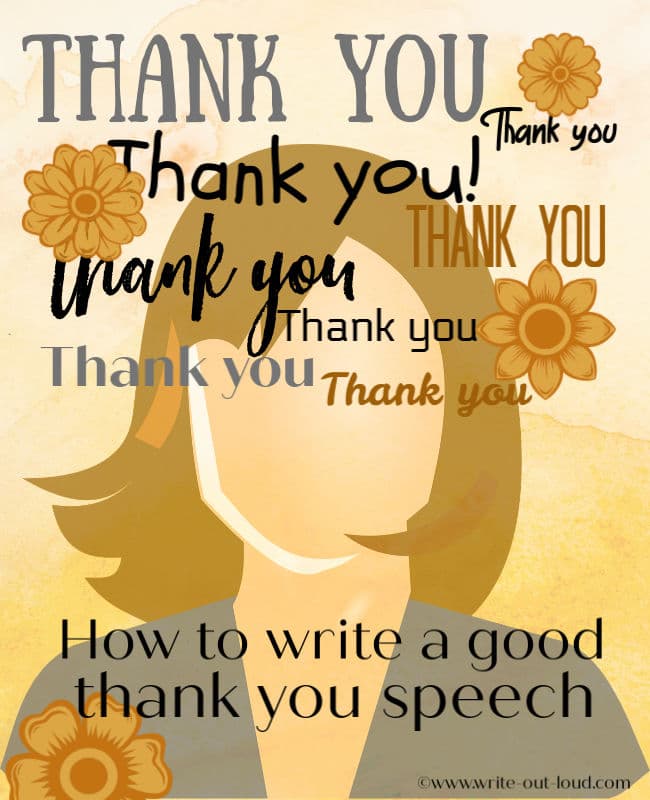
'No man is an island'
When we achieve, we usually do so because others have helped. Your speech of appreciation is the gift or acknowledgment you give in return for what was given you.
When is a thank you speech appropriate?
Any time is good to say thank you! However, a more formal speech of thanks could fit any of these occasions.
- for coming to my graduation, farewell, birthday, or retirement party
- for the promotion
- for the award
- for coming to our wedding and your gifts, our engagement party, our 50th wedding anniversary
- for coming to the opening of my new business...
Be prepared! Best practice guidelines
Generally the decision to leap to your feet and give a thank you speech is not spontaneous. You will likely have some forewarning and time to consider exactly what you want to say and who you want to mention.
Deciding on the content
Cover these three content areas and you'll be fine.
- WHO are you thanking? Note their names in ranking order- the most important first.
- WHAT are you thanking them for? Be specific rather than general. Naming what you are grateful for gives your thanks more meaning.
- WHAT did their gift of time, expertise, encouragement, money... mean to you? Again, be specific. This is your chance to publicly give credit where it's due, to compliment, to praise. Take it.
Writing your speech
When you've sorted out who you wish to mention and what for, you are ready to begin writing.
Like any other form of speech you need 3 parts:- an opening, the body or middle where you put all your acknowledgments, and a conclusion.
1. Introduction/opening
In your introduction or opening give the reason for the occasion and why it is you're going to thank everyone. What you say, and how you say it, will set the tone for the remainder of the speech.
Depending on the number of people on your 'thank you/appreciation' list and the amount of time you have, consider including a small story about the lead-up making this event possible. A well-chosen personal anecdote will always go down well because it lets those listening share your experience more deeply.
Check out this page on story telling in speeches for more information.
In the body of your speech, start at the top of your list of people to thank and work your way through it. Take care to give the most important people the most time.
For those whom you want to mention but don't have enough time to make individual acknowledgments consider grouping them according to function.
Example: "To Alex, Mary, Judy and Sam, thank you for making me remember to laugh. You helped me keep my sanity and perspective when the going was tough."
3. Conclusion
In the conclusion, summarize your main points and finish.
Return to Top
Sample thank you speech for receiving an award
Here's a short sample thank you speech for you to see how it could be done. There are many ways covering the required content. This is one.
The person giving this speech is thanking an organization for giving him an award.
It is 374 words long. When spoken it will take approximately 2 minutes + to deliver. That's about the right length. It's brief and covers everything needed.
As you read it through imagine hearing it out loud.

Speech text
"Who's considered the incredible power of thank you? Those two words express gratitude, humility, understanding, as well as acknowledgement.
I am here with you: my family, many of my friends and colleagues because I need to say all of that, and then some more.
Thank you for coming to share my being given the Fred Smith Award for Community Service. It's very humbling.
There's a phrase I'm sure you know: it takes a village to raise a child. In this case it's not a child that's been raised but awareness and a long needed community resource - the Parksville Community Literacy Center. The village behind it and me, is you.
In particular thank you to my wife Marlene who has always understood and shared my conviction that communities are healthiest when its resources are equally shared, and that the ability to read underpins long term social and economic well being.
I know the hours I spent after work helping to establish our new Center tested her, especially when I was home late, again.
Remarkably she continues to support, and love me. For that I will always be grateful.
Mary Hill, Catherine Beech and Matthew Fall from the Fred Smith Foundation – thank you for sharing the vision of an integrated community and for being so incredibly supportive. You understood what we were trying to achieve and helped make it possible. Your generous gifts of time, expertise and funds are deeply appreciated.
This award may have my name on it, but in truth it belongs to everybody who has worked to make the center a reality. Have you got a spare day or two? If I called out all those people we'd be here for quite some time! Instead, I'll simply say thank you. You know who you are.
The time and effort you've given ensures that the Parksville people who want it will have access to effective literacy programs and resources. That is a priceless gift. As Nobel Peace Prize winner former UN Secretary General, Kofi Annan said “Literacy is a bridge from misery to hope.”
Thank you for the award and thank you on behalf of all those who will cross that bridge to a brighter future."
Here's another example. This one is a thank you speech for a birthday . The speaker is thanking his parents and guests for the celebration in honor of his 18th birthday.
Thanks but NO thanks!
What I really need is a Thanksgiving Speech!
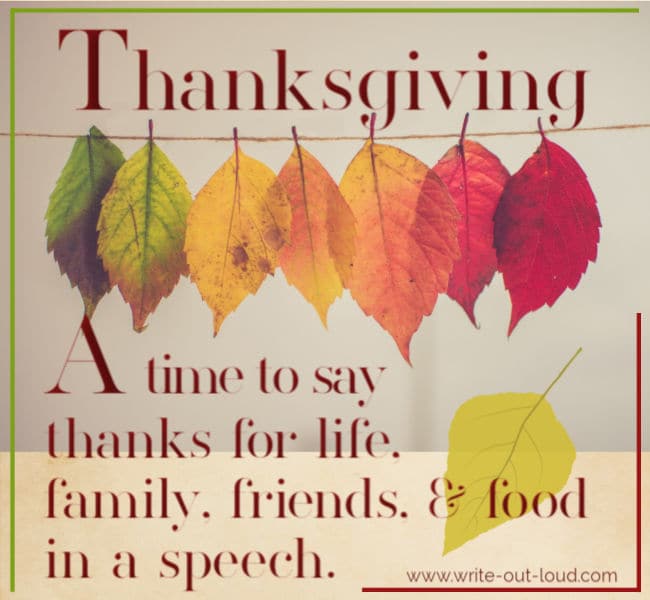
And it's here. Choose a theme. Complete the template. And give your Thanksgiving Speech with confidence.
Get a printable thank you speech planner
Regardless of whether you are preparing a thank you speech for the guests who came to your wedding, engagement, retirement, farewell, graduation or birthday party, the steps are the same.
This printable planner will guide you through the four needed. Each one is fully explained with an example.
Completing it will make writing your speech so much easier.
Either click the link or the image below to: download a printable thank you speech planner .

Use a quotation to help show your gratitude
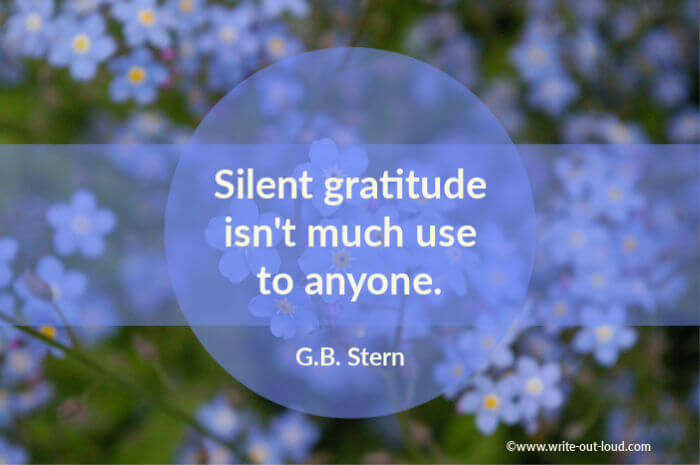
Before you finalize the content, check out these 'thank you quotations' .
They offer different ways of expressing your gratitude. You could find just what you need to spark your creativity and provide the thread/theme to unite your speech. It can be so much more than a long string of thank you, thank you, thank you, thank you ...
Tips to help you get your thank you speech right
Rehearsal, practice and feedback.

Many people make the assumption that once they've got the words of their speech sorted, they're set to go.
That's not true! Practice completes the process.
Giving yourself several rehearsals, firstly by yourself and then in front of friends or family, will help enormously. Click the link for detailed information about how to rehearse effectively .
For the condensed and shortened version covering good rehearsal practice follow the points below.
1. Content check
Before investing too much time and energy into rehearsing your speech say it through in front of a few trusted friends or colleagues. It is much, much easier to change text prior to practicing it than after you've begun working with it. Ask them to listen:
- to make sure you've included everyone you should, in the right order and thanked them for the right things.
- for tone. Does the vocabulary fit the occasion? Are the stories right? Is the speech positive? Is it inclusive?
Edit as needed, and then have your test audience listen again.
Getting the timing right is an essential part of making it a success. Go on too long and people stop listening. Be too brief and there's a danger you've missed things out.
The only way to find out how long your speech is, is to time yourself as you say it out loud at a normal speaking rate. If it's too long, look for areas you can cut. Maybe you need to group a few more people together or perhaps you need to shorten some of the specific examples about why it is you're thanking someone. If it's too short, add more detail. Repeat until you get the length right.
If you'd like to check the number of words you have in your speech against how many minutes it will take to say them go to: how many words per minute are there in a speech .
3. Use cue cards
If you're at all worried about forgetting things, losing your place or muddling what you want to say, use cue cards. They'll take the anxiety away.
Write the main points of your thank you speech on cue cards. Good notes will keep you on track while ensuring you cover everything you want to like, for instance, the name of every person you want to thank and why.
(Click the link if you don't know about using or how to make cue cards . Cue cards are preferable to reading your speech.
However sometimes you just have to read because...for all sorts of reasons. If that's you, do it well. Find out how to read a speech effectively .)
*About The Speech Builder - this is an app that "builds" personalized speeches. If you're needing a speech to say thank you for an award of any sort; academic, sporting, civic, or artistic, the speech builder can help.
Are you sweating over a business thank you speech?
One thanking your colleagues for a job well done?
speaking out loud
Subscribe for FREE weekly alerts about what's new For more see speaking out loud

Top 10 popular pages
- Welcome speech
- Demonstration speech topics
- Impromptu speech topic cards
- Thank you quotes
- Impromptu public speaking topics
- Farewell speeches
- Phrases for welcome speeches
- Student council speeches
- Free sample eulogies
From fear to fun in 28 ways
A complete one stop resource to scuttle fear in the best of all possible ways - with laughter.

Useful pages
- Search this site
- About me & Contact
- Blogging Aloud
- Free e-course
- Privacy policy
©Copyright 2006-24 www.write-out-loud.com
Designed and built by Clickstream Designs

Researched by Consultants from Top-Tier Management Companies

Powerpoint Templates
Icon Bundle
Kpi Dashboard
Professional
Business Plans
Swot Analysis
Gantt Chart
Business Proposal
Marketing Plan
Project Management
Business Case
Business Model
Cyber Security
Business PPT
Digital Marketing
Digital Transformation
Human Resources
Product Management
Artificial Intelligence
Company Profile
Acknowledgement PPT
PPT Presentation
Reports Brochures
One Page Pitch
Interview PPT
All Categories
15 Best Templates To Say Thank You in a Business Presentation
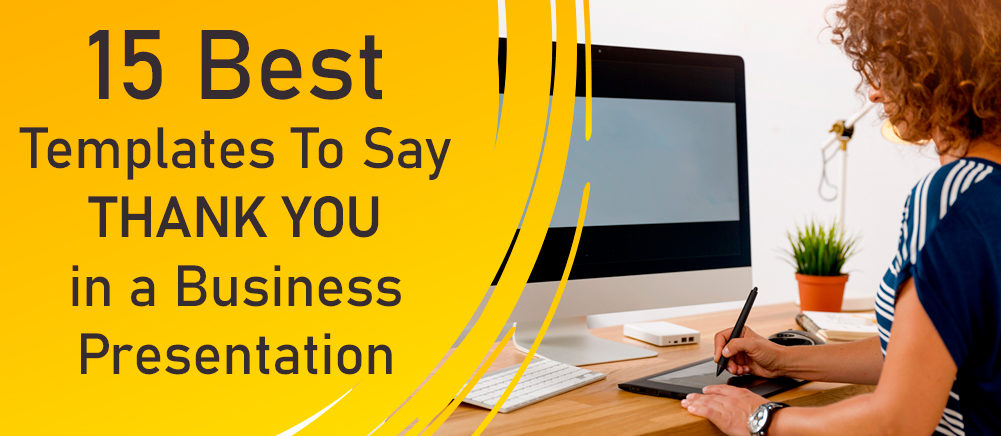
Malvika Varma
The quality of business relationships is one factor that doesn’t reflect monetary gains directly, but it plays a significant role in establishing a firm ground in the corporate world. Cordial business relationships ensure a good market reputation and foster a strong bond with customers and team members. One such goodwill gesture in the corporate world is gratitude.
“Silent gratitude isn’t much to anyone.” — Gertrude Stein
Although ‘Thank You’ may seem a tiny gesture, its impact goes a long way in a professionally rewarding journey. The first step of cultivating amicable business relationships starts with a simple word ‘Thank You.’ Business presentations are a great source for sharing the project details and expressing sincere gratitude to the business counterparts. A Thank You slide is also important to acknowledge the viewers’ interest and enthusiasm, which leaves a positive sign-off impression. A Thank You slide after the concluding remarks show appreciation for the audience’s time and engagement throughout the presentation. Additionally, it opens the gateway to fruitful business endeavors as it gives a more meaningful yet professional touch to the presentation.
As the significance of a Thank you slide is enormous, SlideTeam professionals have designed these 15 Best Templates To Say Thank You in a Business Presentation. Download our high-quality Thank You templates to extend your gratitude to the clients in a professional manner.
15 Best Thank You Templates To Download
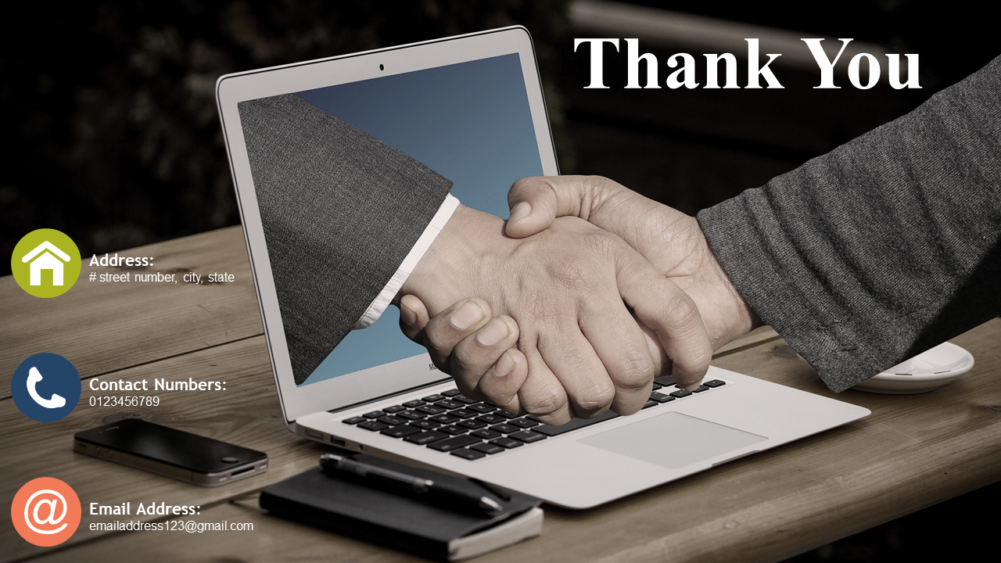
Incorporate this contemporary thank you template to present gratitude towards your client. With the help of this striking thank you template, you can express the thanks to the business customers. Conclude the business presentation with our attention-grabbing template.

Give the company’s details, contact number, and e-mail address by downloading this content-ready template. You can easily incorporate this thank you template to present the token of thanks to your business partners. This thank you template is a must for the business presentation.
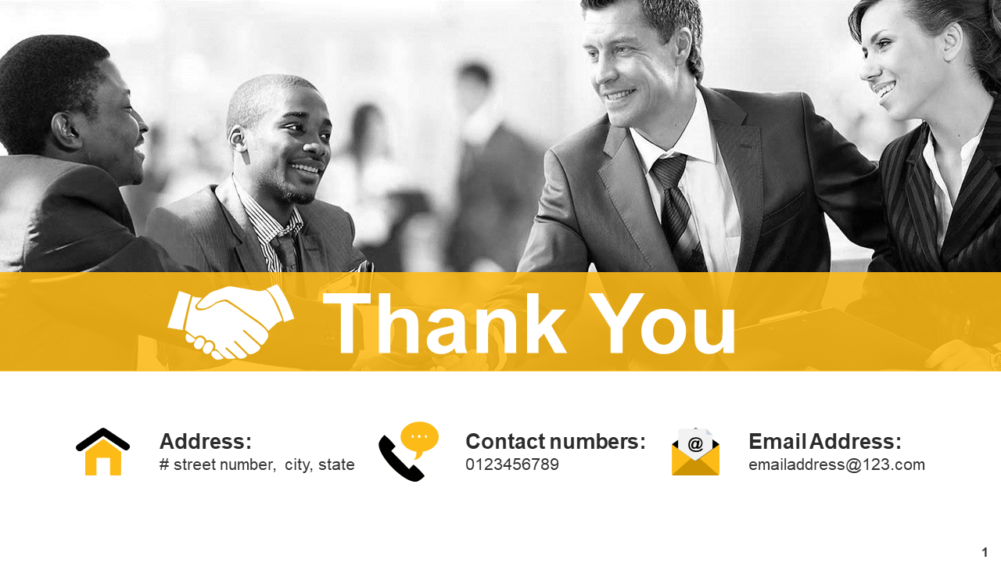
Sign off the business presentation on a good note by downloading this pre-designed thank you template. By utilizing this high-quality thank you template, you can employ this attention-grabbing template. Maintain the cordial relationship in business using this professionally designed thank you template.

Give the business details by downloading this thank you template for your business presentation. You can introduce this attention-grabbing template with the help of this contemporary thank you template.
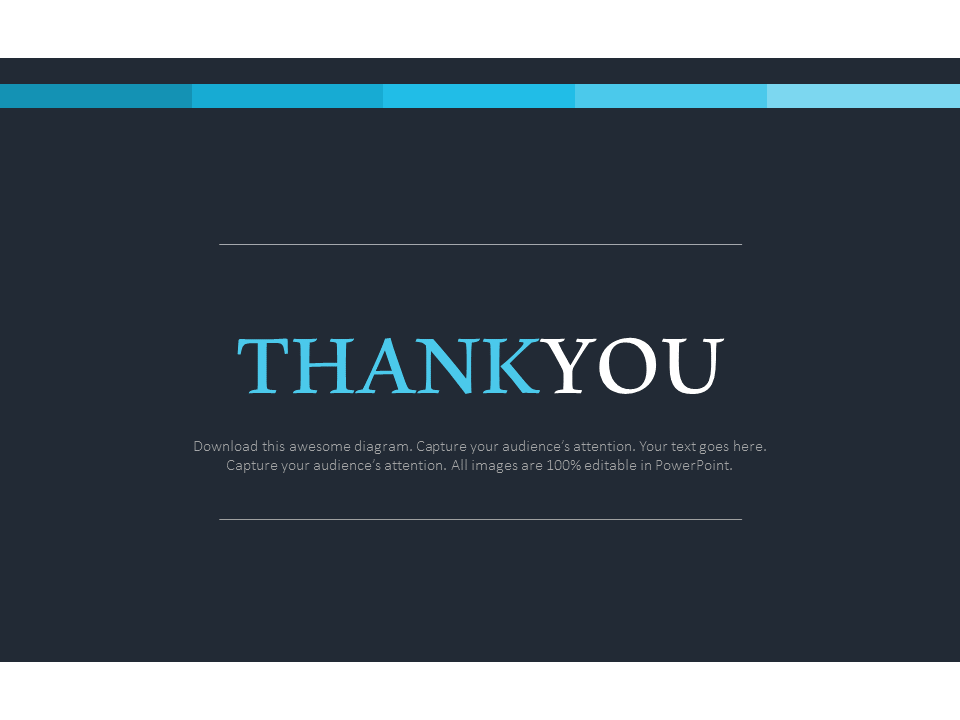
Download Thank You Slide For Business Communication Template
With the help of this professionally designed thank you template, you can acknowledge the audience’s time and the interest shown by them. The color palette used here instantly grabs the attention of the viewers.
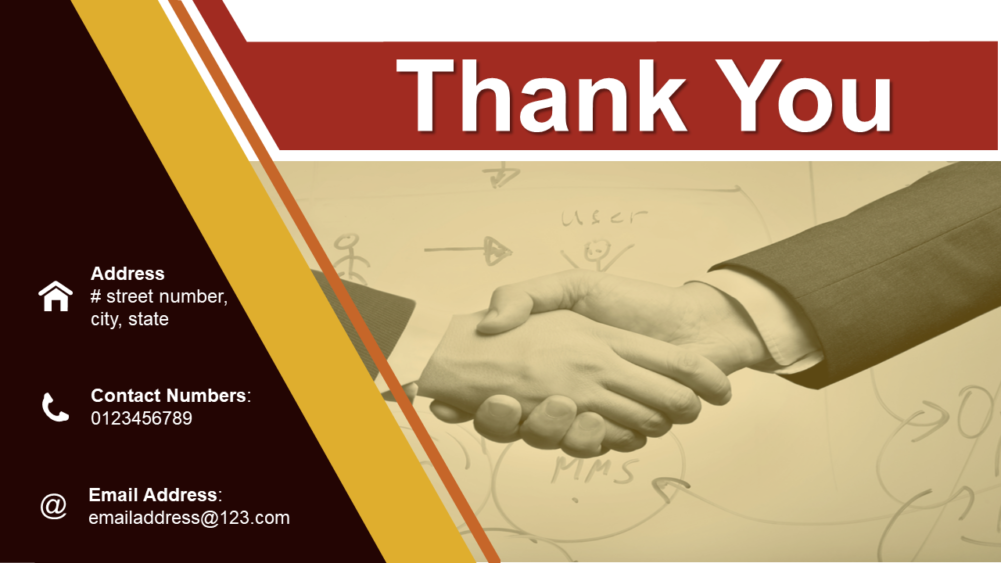
This template is perfectly suited for concluding the business presentation. As this template is completely editable, you can incorporate this eye-catching thank you template. State the address, the contact numbers, and e-mail addresses of the company by downloading this pre-built thank you template.
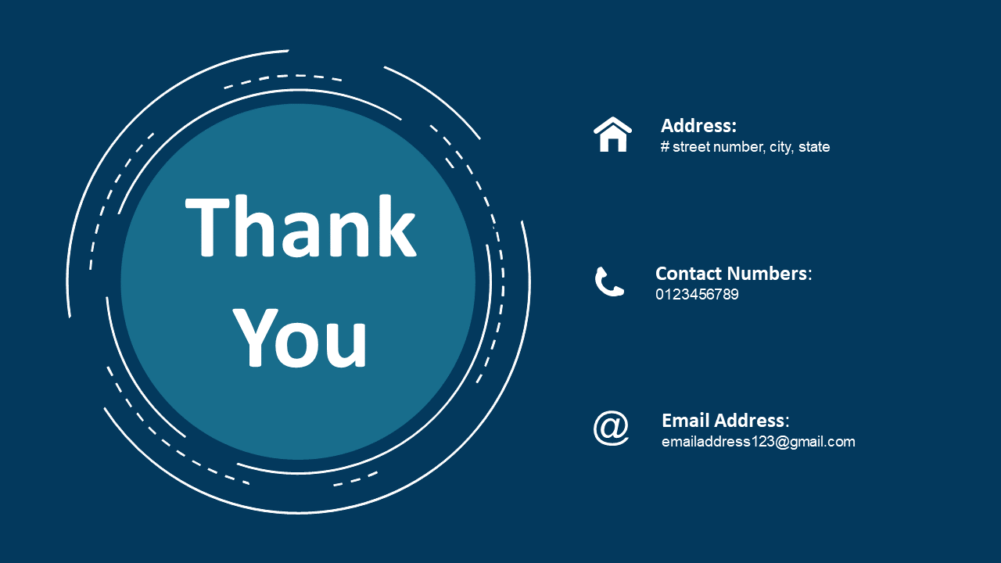
By downloading this impressive thank you template, you can appreciate your clients and boost your team members’ morale. You can modify the business details as per requirement by utilizing this visually appealing thank you template.
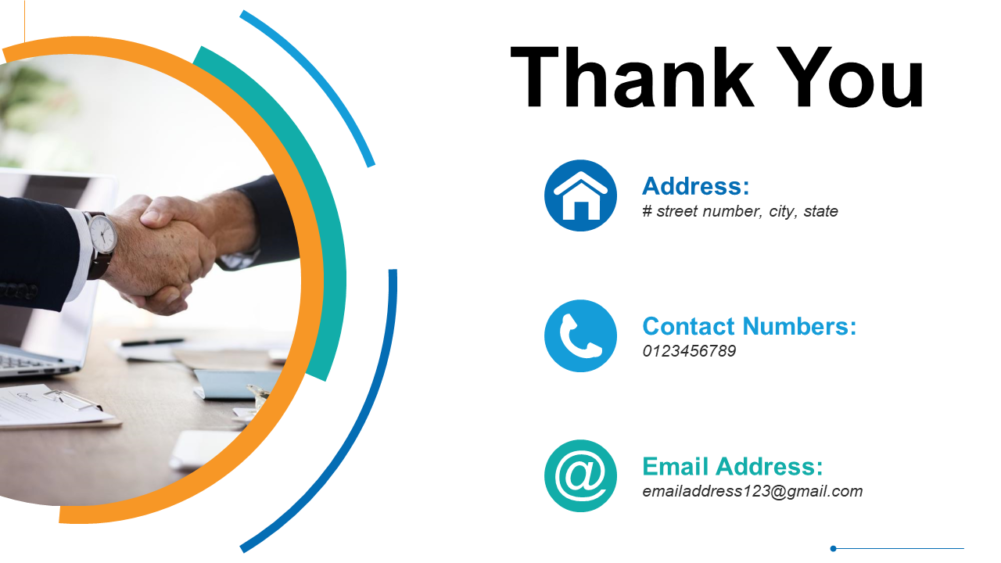
Showcase the essential contact details of your enterprise by incorporating this pre-designed thank you template. With the help of this compelling thank you template, you can appreciate your team members’ efforts and the clients who were actively involved throughout the project briefing.
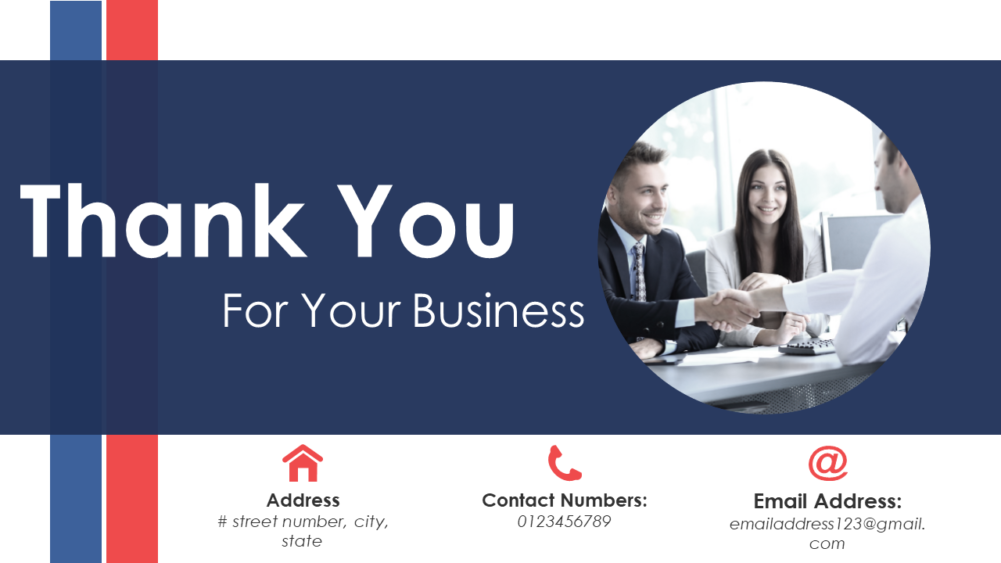
Employ this contemporary thank you template for your business presentation and leave a great impression on your client. You can edit the business details as per the requirements, as this template is entirely editable.
Template 10
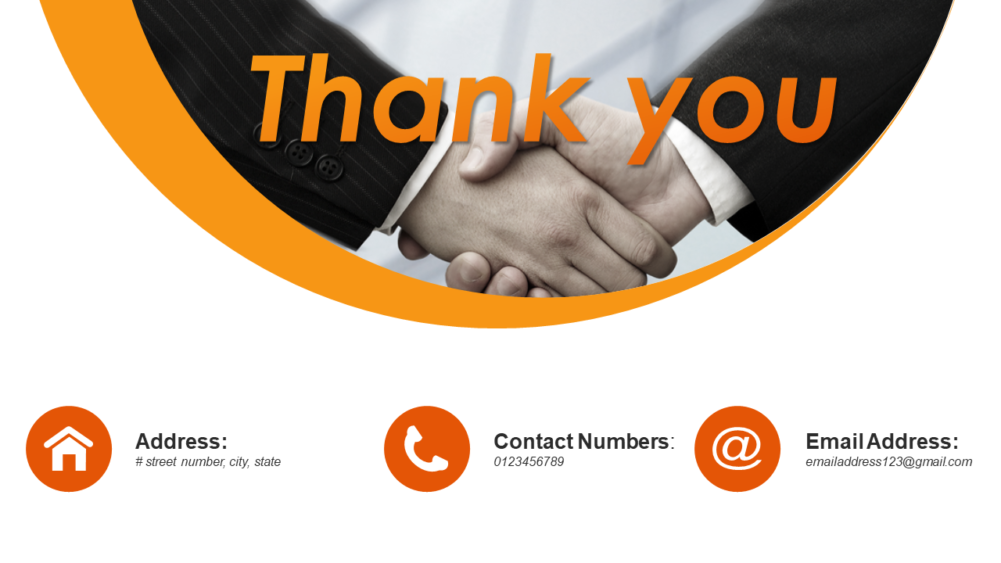
You can download this thank you template and express your gratitude to the client in an impressive way. The color palette used here grabs the attention of the audience and serves the purpose. By employing this professionally designed thank you template, you can give relevant business information.
Template 11
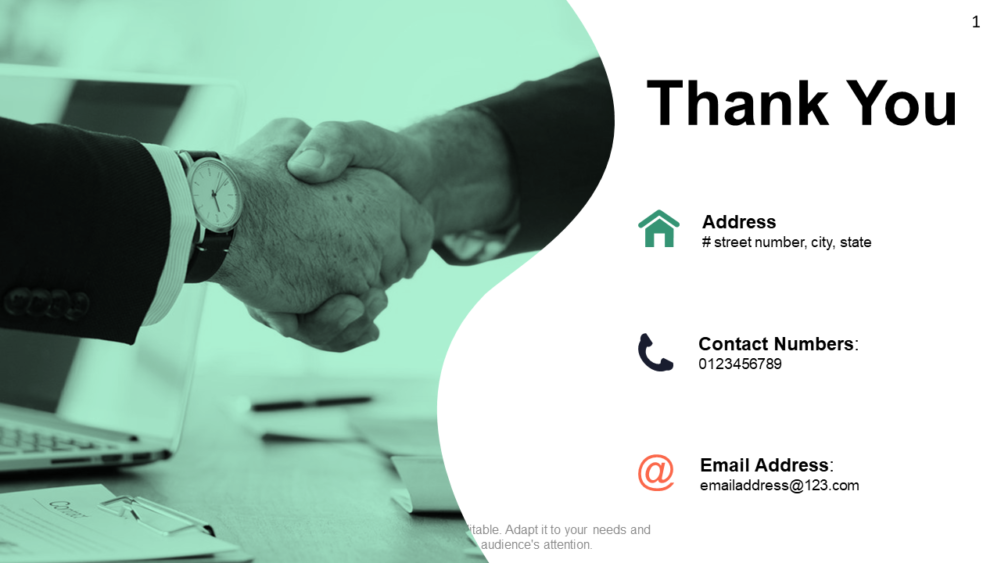
Present the sincere thank you to your customers by introducing this customizable thank you template for the business meetings. By downloading this contemporary template, you can mention the address, contact numbers, and e-mail addresses of the company.
Template 12

Give thanks to your colleagues for all the hard work they have put in by downloading this amazingly designed thank you template. Business professionals can take advantage of this modern thank you template and build good relationships with your customers.
Template 13
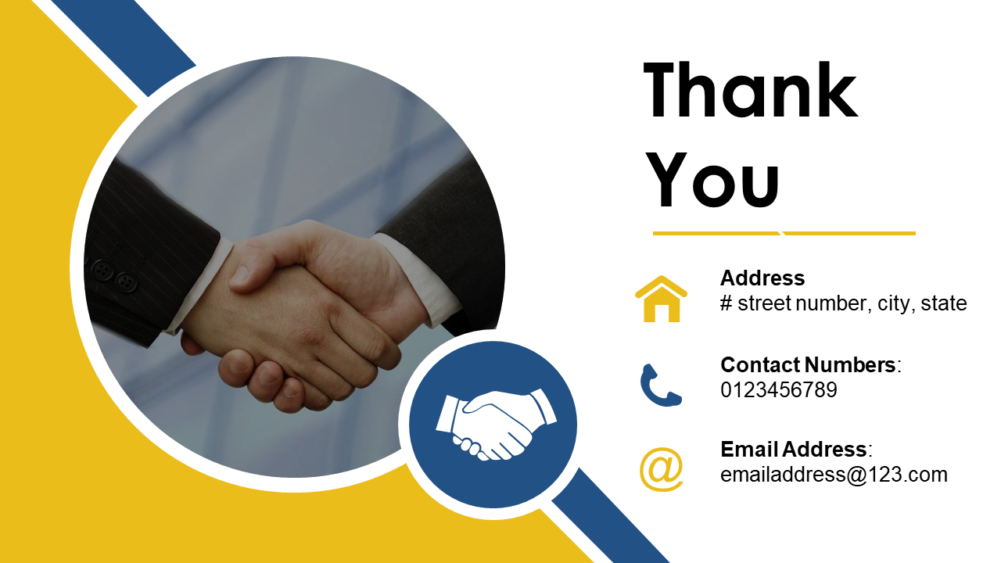
Discuss your company’s contact details by incorporating our visually appealing thank you template to your business presentation. Impress your clients by acknowledging their sincere attention to the subject matter.
Template 14
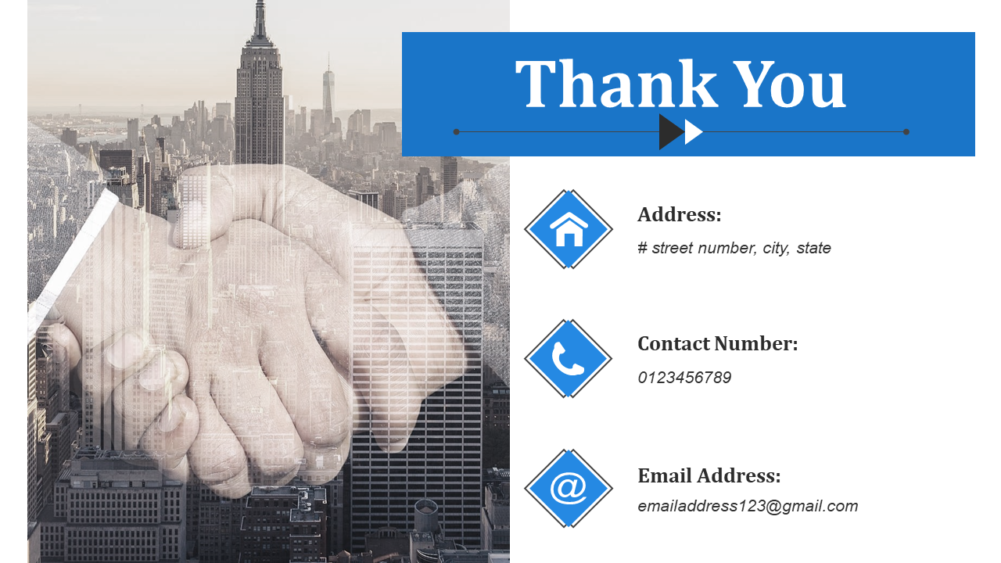
End the business meeting on the good by downloading this attention-grabbing thank you template. Build a foundation of trust and confidence by introducing this stunning thank you template.
Template 15
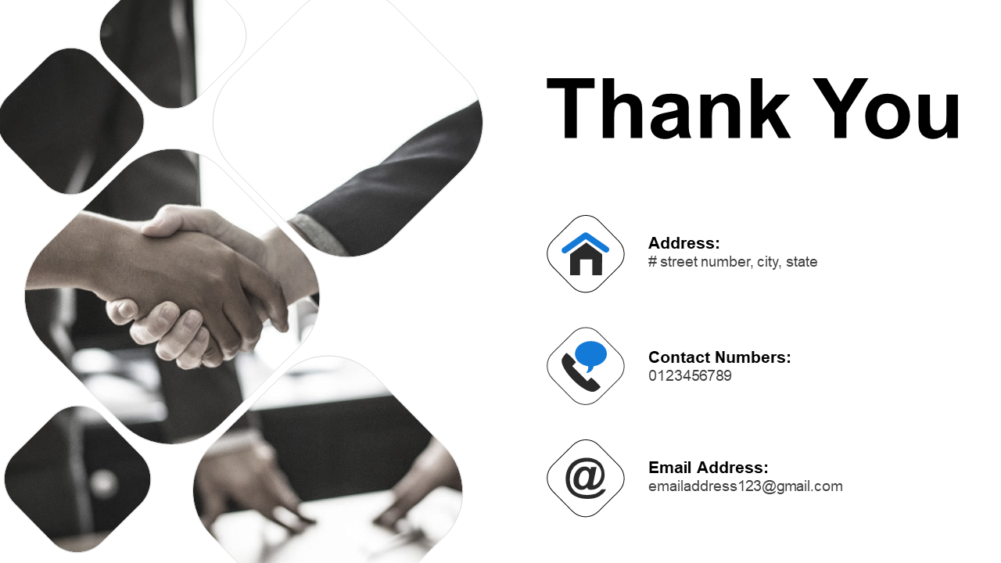
Utilize our content-ready thank you template and leave a great impression on your audience. Download this visually appealing thank you template and increase your chances of sealing the deal.
“Feeling gratitude and not expressing it is like wrapping a present and not giving it.” — William Arthur Ward
Download our 15 Best Templates To Say Thank You in a Business Presentation and appreciate your clients. Make an impressive impression on your customer by acknowledging through our ready-made templates.
Related posts:
- [Updated 2023] Top 10 Market Opportunity Analysis Templates For Developing a Robust Business Strategy
- The Ultimate Guide To Event Marketing (Best PowerPoint Templates Included)
- [Updated 2023] Top 10 DevOps Templates To Leverage Smart Engineering In Your Company
- Top 10 Legal Firm Marketing PPT Templates for Lawyers to Lead the Competition
Liked this blog? Please recommend us

10 Tips To Create a Successful Corporate Presentation (Top 10 Templates Included)
![thank you for your presentation sample [Updated 2023] 50 Best Company Presentation Templates To Ace The Corporate Ladder](https://www.slideteam.net/wp/wp-content/uploads/2020/03/Banner-16-335x146.png)
[Updated 2023] 50 Best Company Presentation Templates To Ace The Corporate Ladder
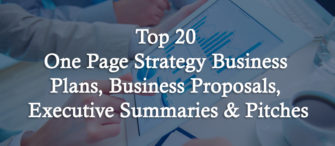
Top 20 One Page Strategy Business Plans, Business Proposals, Executive Summaries and Pitches For Entrepreneurs
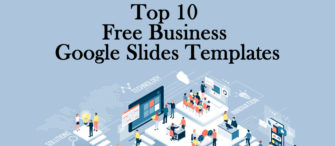
Top 10 Free Business Google Slides Templates for Entrepreneurs
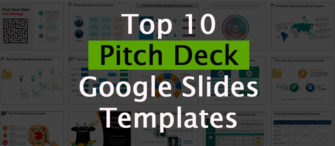
Top 10 Pitch Deck Google Slides Templates For Successful Fundraising
![thank you for your presentation sample [Updated 2023] Top 10 Business Strategy Google Slides Templates To Empower Your Team](https://www.slideteam.net/wp/wp-content/uploads/2020/06/Banner-1-335x146.jpg)
[Updated 2023] Top 10 Business Strategy Google Slides Templates To Empower Your Team
![thank you for your presentation sample [Updated 2023] Top 25 Brainstorming PowerPoint Templates for Stimulating Out-of-the-box Thinking!](https://www.slideteam.net/wp/wp-content/uploads/2020/05/size1001-436-7-335x146.jpg)
[Updated 2023] Top 25 Brainstorming PowerPoint Templates for Stimulating Out-of-the-box Thinking!
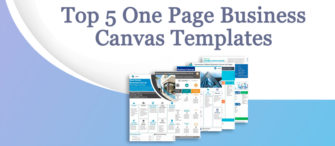
Presenting the most effective One-Page Business Canvas (with templates designed by professionals)
![thank you for your presentation sample [Updated 2023] Top 10 One Page Strategic Plan Templates For Business Management](https://www.slideteam.net/wp/wp-content/uploads/2020/08/size1001-436-25-335x146.jpg)
[Updated 2023] Top 10 One Page Strategic Plan Templates For Business Management
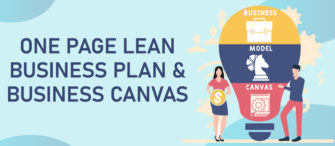
Reconcile and Allure with these One Page Lean Business Plan and Business Canvas Templates
![thank you for your presentation sample [Updated 2023] 20 Best Thanksgiving PowerPoint Templates To Gobble Up Like a Turkey!](https://www.slideteam.net/wp/wp-content/uploads/2020/05/size1001-436-9-335x146.jpg)
[Updated 2023] 20 Best Thanksgiving PowerPoint Templates To Gobble Up Like a Turkey!
This form is protected by reCAPTCHA - the Google Privacy Policy and Terms of Service apply.

Digital revolution powerpoint presentation slides

Sales funnel results presentation layouts
3d men joinning circular jigsaw puzzles ppt graphics icons

Business Strategic Planning Template For Organizations Powerpoint Presentation Slides

Future plan powerpoint template slide

Project Management Team Powerpoint Presentation Slides

Brand marketing powerpoint presentation slides

Launching a new service powerpoint presentation with slides go to market

Agenda powerpoint slide show

Four key metrics donut chart with percentage

Engineering and technology ppt inspiration example introduction continuous process improvement

Meet our team representing in circular format


How To Write A Professional Thank You Email (25 different use cases)
Did you know including a simple “thank you” email in your outbound strategies can jump response rates by almost 53.5% ?
While sending a thank you email is an expression of gratitude, it’s also a conversation re-starter. Especially for sales and marketing teams, it’s an essential strategy to maintain positive relationships with clients.
A study shows thank you emails have one of the highest open rates at 42%!
Want to learn how to write a thank you email but not sure how to stand out? Refer to the following guide based on real-time use cases and copy-pastable email examples.
But first, let’s understand what a thank you email is all about.
Table of Contents
Professional thank you email: what is it, and how to write a professional thank you email
When you’ve received a client referral, met a potential client at a business event, or successfully delivered a client project, regardless of the magnitude of the occasion, a thank you email is a quick way to show appreciation.
Thank you emails should be part and parcel of your business communication.
Imagine you’re at the receiving end of thank you emails. A teammate sends you an email thanking you for your significant role in a project’s completion. It instantly lights up your day. Not only that, you’re motivated to continue pursuing the partnership and giving it your best.
Some tips on what should go into your thank you emails:
- Write a short and sweet thank you email highlighting specific details and the reason for sending the email.
- Include a personalized subject line. For example, “ Stefan, it was wonderful meeting you! ”
- Ensure you don’t send a cookie-cutter message. Add the intention behind thanking the recipient, for example, after an event, conversation, or project they were a part of.
- Write crisp text, avoid sounding salesy, and double-check for typos and grammatical errors to show professionalism.
But wait. We know sending professional thank you emails is not this simple. So we’ve collected 25 different use cases of sending thank you emails to improve your personal connections.
Let’s get into it.
25 examples of professional thank you emails
We’ve divided the examples into four different use cases so you can jump to your preferred section and get sending winning thank you emails:
- Sending thank you emails to your clients
- Sending thank you emails to your partners
- Sending thank you emails to your boss
- Sending thank you emails to your colleagues
How to write a professional thank you email to your clients
Let’s go over seven different client occasions to send thank you emails and make a difference:
1. After a business event:
You’ve just attended a business event and networked with executives and potential clients in your industry. But thanks to us humans’ memory limitations, most clients forget the important conversations they had at an event.
So what’s the best memory refresher? Sending a personalized thank you note as an email reminding your potential clients of the incredible discussions you had with them at the event.
A well-structured, to-the-point thank you email also helps you continue the conversation further and get to know a prospect better.
A thank you email to a client after a business event example:
Subject line: Derek, it was lovely meeting you! Hi Derek, It was a pleasure talking to you at the SaaS Insiders event. I loved your presentation about AI and could not stop raving about it to my colleagues. Would you like to have this conversation over a quick Zoom meeting this Friday? Thanks again for your talk. Looking forward to meeting with you again soon. Thanks, Jack
Bonus tip: Potential clients may not always check their emails or respond to them. So, as a rule of thumb, try reaching them over other channels, too. For example, use LinkedIn to send a personalized thank you note along with an email.
Expandi lets you send such requests at scale by tying up emails and LinkedIn and automating the whole process.

Expandi’s Smart Sequences allows you to set up workflows based on several scenarios and outcomes. For example , if the prospect fails to respond to your first ‘thank you’ email, you can set up an automated LinkedIn message and an email to be sent after 1-2 days as a follow-up.
2. After a purchase or a transaction:
If your client has recently purchased with your business or engaged in a transaction, send them a short thank you email as a token of appreciation. After all, they deserve one for placing their trust in your services.
Moreover, a post-purchase thank you email sets the tone for communicating transaction details, providing necessary next steps, or even offering up-selling opportunities.
Here’s an example:
Subject line: Thanks for the purchase, we’re glad to have you onboard! Hi Mary, We’re excited to have you as a part of our agency! We cannot wait to bring you incredible results and watch your business grow. For the next steps, please sign our contract here . Please feel free to reach us if you have any questions. You can access our free resources to learn more about our processes and services. Thanks again for trusting us! [signature]
3. On special occasions:
Track your clients’ birthdays, anniversaries, holidays, or major milestones to send them a sweet note congratulating and thanking them for their valuable relationship.
Your clients will love the gesture and continue supporting your efforts.
Subject line: Warm birthday wishes! Hey John, Happy birthday! Hope your upcoming year is filled with joy and many new and existing opportunities. Want to take a moment and thank you for your sincere support and friendship over the last year. Hope we continuously collaborate and work on many more projects together. Thank you once again for your incredible support! [signature]
4. Referrals or recommendations:
If a client has made an effort and referred you to a job or a person, a short and simple thank you note is a polite way to appreciate them. Sending a thank you email persuades them to continue referring your services to others in their network.
Subject line: Thanks for the referral, Jack! Hi Jack, Thanks for referring me to John at Company X. Just got off a sales call with them, and they had great things to say about you. I was super proud of the fact that I worked with you! I sincerely appreciate your support and for taking the time to recommend me to your network. I’ll keep you posted on the call’s progress. Thank you, [signature]
5. Feedback or testimonials:
If clients have gone out of their way to provide feedback or a testimonial, ensure you express gratitude with a personalized email thanking them.
This small yet significant gesture instills mutual trust, urges them to continue working with you, and makes way for more valuable feedback.
Subject line: Thank you for the testimonial 😊 Hi Carol, Cannot thank you enough for taking the time to drop in a testimonial. Heartfully appreciate your prolonged support and hope to continue this partnership for years to come! Thanks again for trusting our services! [signature]
6. Client appreciation events:
Did you just host a successful client appreciation event? Then consider sending the participants a thank you email for their active participation.
Sending a thank you email post-event continues the conversion beyond an event, thus developing a healthy bond between businesses and clients.
Subject line: Thanks for attending last night’s session! Hi Joe, Thank you for actively being a part of our community and attending the networking event yesterday! Meeting you in person and knowing you’re a football fan was a pleasure. Hoping to stay connected and continuing our prolonged collaboration. Cheers! [siganture]
7. Successful project completion:
If you’ve successfully brought a project to completion and delivered it to a client, you should consider sending a thank you email to them.
Picture this: The client is already ecstatic about the project’s successful completion, and sending a thank you email may be just what they need to continue their collaboration for future projects.
Subject line: Thanks for your support in bringing Project X to completion! Hello Jane, Glad to inform the completion of Project X within the expected timeline! As always, you’ve been of great help. Your expert insights and ideas are something we’ll always look up to. We hope to continue working with you for many other future projects and bringing you incredible results! Thanks again! [signature]
How to write a professional thank you email to partners
Want to thank your partner(s) but have no idea how? Let’s discuss six different occasions to thank your partners for their valuable friendship and show gratitude:
1. Successful collaboration:
If you and your partner have successfully handed off a client project or hit a shared goal, consider sending them a thank you email and making their day.
For example, highlight their personal contribution that helped the project kick-off, acknowledge the value they brought to the partnership, etc. Doing so lays the ground for hitting many more business goals.
Subject line: We did it, Steve! Thanks for the partnership. Hey Steve, Project X is now done and dusted and all set to be kicked off. You had a major role in this, and cannot thank you enough! Your ideas and sales outreach expertise brought so much to the table that our clients loved every bit of our approach. Cannot wait to work on more projects with you and hit many more sales goals. Thanks again, and see you soon! [signature]
2. Partnership anniversary:
Long-term partnerships are priceless. Sending a thank you email for your partnership anniversary sets the stage for mutual respect, friendship, and trust.
In the thank you email, thank them for their continued efforts, trust, and collaboration throughout the years. Make it more interesting by reflecting on some major milestones you’ve achieved together, letting them take a walk back memory lane.
Subject line: Here’s to our incredible journey – celebrating our partnership anniversary! Hello Team X, Today marks five years since our partnership started! My team and I take this opportunity to express our heartfelt gratitude for your trust and friendship all through these years, We’ve had some major ups and downs along the way. But that didn’t stop us from achieving our goals together. Thank you for your invaluable contribution. Without your team and leadership’s feedback and expertise, we wouldn’t have made it this far. Here’s to many more years together as partners and friends! Cheers! [signature]
3. Referrals or introductions:
If you had a partner who referred clients or other partners to your business, don’t forget to drop them a sincere thank-you email.
Keep them posted on the outcomes so they are proud of their decision and continue referring you to others in their network.
Subject line: Thanks for the awesome referral! Hi Dylan, Reaching out to thank you for connecting me with Mike from Operations. I really appreciate you going out of your way and introducing me to your network. Happy to inform you that I’ve been in touch with Mike, and we’re hoping to get on a call soon. Will keep you posted on the happenings! Once again, appreciate your efforts. Let me know if I can refer you to someone too. Thanks, [signature]
4. Support during challenging times:
A helping hand during a challenging situation or period deserves utmost recognition. And if you had a partner support you during hard times, let them know what the gesture meant to you with a thank you email.
A thank you email in this situation further strengthens the bond with your partners. You can also add a thank-you gift in return for their assistance.
Subject line: Forever grateful for your support during the pandemic Hi Mike and Team, We hope this email finds you well. We at Company X want to thank you for your unwavering support during the recent pandemic. We will forever be grateful for the incredible, non-stop commitment and support during this challenging time. Thank you for sharing your resources with us. It helped us deliver projects on time with no client complaints. Please accept our vouchers as a token of appreciation. Thanks again for standing by us. Hoping to continue this healthy partnership for years to come. Warm regards, [signature]
5. Special occasions:
Is your partner’s birthday or a long-due vacation coming up? Did your partner company reach a major milestone? Whatever the reason may be, ensure you whip up a personalized thank you email to wish them well.
Subject line: Enjoy your well-deserved vacation, Stefan! Hi Stefan, I know a vacation is long due for you. Hope you enjoy every minute of it and make beautiful memories. Thanks for everything you did in the last quarter. We constantly hit our sales and marketing goals thanks to your awesome commitment. Looking forward to working on many more such targets once you’re back. Until then, have fun! Thanks, [signature]
6. Partnership renewal or extension
Expressing gratitude with a thank you email is essential when you’ve extended a partnership or contract.
It sets the tone for future communications and shared goals. Let them know you’re excited about reaching new feats and continuing the friendship.
Subject line: Celebrating our extended partnership Hi Mike and Team at Agency X, My team and I are super excited to continue our partnership and friendship with you all. Thank you for instilling trust in us. We wouldn’t do it without your support and commitment. Cannot wait to see what’s to come in the following years! Here’s to the best partners and friends 🥂 Wishing us all more success and growth. Thank you and best regards, [signature]
How to Write a Professional Thank You Email to Boss
There are many ways to thank your boss besides a promotion. We have six ways for you to express gratitude to an awesome boss:
1. Recognition or praise:
Did your manager or a lead leave glowing performance feedback or recognize your work? You know how these points play a key role in getting a raise.
So it only makes sense to thank them for their encouragement and immense trust in your skills.
Subject line: Thanks for the awesome feedback, Jack Dear Jack, I just reviewed your feedback and cannot thank you enough for those encouraging words. You’ve always been a huge motivator for me to perform my best at work. And no doubt, your encouragement and guidance have made a massive difference to my skills and professional growth. Thanks again for your never-ending support! Best regards, [signature]
2. Promotion or raise:
A promotion or a raise is a testament to your incredible skills that your boss trusts. Ensure you commend them for their faith in your contribution with a short thank you email.
Write about how you see this as an opportunity to grow as an individual and a professional. State your undying commitment to perform better and contribute to the team’s success.
Subject line: Thanks for the promotion, Mike! Hi Mike, Writing this email to thank you for promoting me to Marketing Lead. I’m aware your feedback played a big role in my promotion. Thanks for trusting my skills and being my guiding force for the last couple of years. I assure you I will continue doing great work in my new position and make you proud! Please let me know if there are any specific areas I must focus on in my new position. I’m excited to work with you in the new role and learn more. Thanks again! Warm regards, [signature]
3. Mentorship:
If you’ve received helpful guidance or mentorship from your boss, a thank you email is the best way to recognize their efforts and time spent.
Make the email more specific by adding instances where their advice has helped you the most.
Subject line: Grateful for your valuable advice, John Dear John, Thanks for your unwavering support ever since I’ve joined your team. I always look up to you for inspiration and advice. Our recent discussion on what career skills I should upskill to has been extremely helpful. Glad to inform you that I’ve already signed up for the Marketing course as suggested by you. I will keep you updated on my course completion. Grateful to have you as my boss! Thanks, [signature]
4. Opportunities for growth or learning:
Did your boss recently refer you to a training program, workshop, or conference? Such career-oriented events are a gold mine of opportunities.
And sending a thank you email is an excellent way to express gratitude for choosing and investing in you.
Subject line: Thanks for choosing me to attend ConX, Jane! Dear Jane, I just finished attending the ConX held at Northeastern University. And I must say, it was a great experience meeting top executives in our industry and interacting with them. And the credit goes to you for choosing me as the company’s representative. Thank you so much for the incredible opportunity and for trusting me to represent our company. Please let me if we can discuss the conference over a call. Thanks again for the opportunity, Jane. Hoping to talk soon. Warm wishes, [signature]
5. Support during challenging times:
If your boss lent a helping hand during a challenging time, send a thoughtful thank-you email to make their day and acknowledge their kindness.
Include how their support has significantly impacted your personal or professional life and how you’re forever grateful for the support.
Subject line: Thanks for your kindness, Jake. You’re the best boss! Dear Jake, Writing this email to thank you for extending my medical leave. As you know, things have been rough, and now I’m glad to let you know I’ve fully recovered. Thanks for the empathy and kindness you’ve shown in understanding my situation. The extended leave has ensured I focus on my health and wellbeing. I’m super glad to join work this Monday and work alongside the team. Once again, thank you for accommodating my medical leave! Warm regards, [signature]
6. Thank you email for leaving a job:
Leaving a job and want to appreciate your boss for the support? A thank you email can do the trick.
Subject line: It’s been a fun ride – thanks to you, Jill Hello Jill, As you’re aware, today is my last day at the company. Wanted to take a moment and pen this email to you for your extreme support and motivation throughout my tenure here. You’ve provided me with some amazing opportunities over the years that helped me grow as a professional. I look forward to staying in touch with you and hope our paths cross soon. Thanks again! Best regards, [signature]
How to Write a Professional Thank You Email to Colleagues
Appreciating each other in a workplace is essential to building a strong relationship and achieving goals together. We have six examples of how to write thank you email to colleagues and encourage them:
1. Help or support on a project:
If you have a co-worker who’s helped you finish a challenging project or offered guidance in any way, make it a point to thank them in an email.
Your co-workers will cherish your message and gladly help you with upcoming tasks.
While writing an email, mention specific instances your colleagues worked on and the outcomes. Keep the tone friendly and positive.
Subject line: Could not have done it without you, Alex! Hey Alex, Hope you’re having a great day! Writing this email to thank you because the client at Bank Z loved the presentation you helped me with. The entire team couldn’t take their eyes off the deck and its simplistic design. I’m glad I reached out to you for help. I must say, your design skills are exceptional. Looking forward to working on more such projects with you soon. Feel free to let me know if you need any help! Thanks, [signature]
2. Collaboration and teamwork:
A positive work atmosphere is a result of individuals engaging and collaborating effectively.
So if you’re a boss or manager looking to appreciate each of your team members for their outstanding teamwork, consider sending them a sweet thank you email.
Subject line: Keep up the team spirit, Ben! Hi Ben, Writing this to thank you for making a tremendous contribution to our team. You’re a great sport and always take on challenging tasks with ease. I see the team loves learning from you and that you’re always open to help. Also, thanks for the recent project completion. You’ve shown exceptional team spirit. Hope you continue to help and collaborate with the team and grow together. Let’s talk soon! Thanks, [signature]
3. Going above and beyond:
If you have a colleague who’s gone out of their way to help you or the team in any way, consider sending them a thank you email to make their day.
Highlight their thoughtfulness in helping out and how their actions have made a huge impact.
Subject line: Grateful for your help and dedication Hi Mary, Hope this email finds you well. Wanted to take a minute and thank you for everything you’ve done last week for our team. Despite your busy schedule, appreciate your willingness to help my team fix the bug, leading to on-time product delivery. On behalf of my team, I thank you from the bottom of my heart for your kind gesture. Please feel free to let me know if there’s any help you may need in the future. Best regards, [signature]
4. Support during a challenging time:
Did a kind-hearted colleague help you combat a difficult time? Then they deserve a thank you email from you.
Subject line: Thanks for lending a helping hand, Jake! Hi Jake, Thank you for always being a wonderful colleague and an aide during my challenging time. I wouldn’t have made it this far if not for you and your quick financial support. Thanks for giving me hope and understanding the situation. I’m forever grateful to you. If you need any kind of help at work, please do not hesitate to let me know. Thanks again for your friendship! Best regards, [signature]
5. Training or mentorship:
Sometimes colleagues are great mentors who help you make important decisions at work or in your personal life. And it’s only fair to thank them for being extra outgoing and influencing your career growth.
Subject line: Thanks to the best mentor! Hi Alex, Wanted to take a moment and thank you for your thoughtful mentorship over the last month. You were generous enough to invest your time and effort in coaching me when I was lost in finding my fit at work. Also, appreciate your patience and knowledge. Thank you once again for being an incredible mentor, human being, and friend. I hope to make it up to you someday, hopefully soon! Thanks, [signature]
6. Celebrating achievements or milestones:
A colleague might’ve hit a personal goal, such as a work anniversary or a much-awaited promotion. Whatever the reason may be, it calls for a thank you email to celebrate their achievements together.
Subject line: Congrats on your fifth year with us. You’ve been amazing! Hi Mark, Congratulations on your work anniversary! Cannot believe it’s been five years since you joined us. Time surely flies when you’re having fun at work. You’ve been an integral part of the team; our clients adore your work. Thank you for all your hard work and dedication. Wishing you many more amazing years at our company and massive success. Thanks, [signature]
We hope you found the perfect example to use for writing a professional thank you email.
A thank you email can do wonders in fostering a healthy work relationship with your bosses, clients, colleagues, or partners. Use it well, and remember to personalize it to make a better impact.
But let’s face it. Most of your clients or partners are busy and often forget to respond to emails.
In such a case, Expandi’s Smart Sequences come to your rescue.
Build and automate emails and LinkedIn messages to receive more responses for your efforts!
Learn more on Expandi.io and sign up for the 7-day free trial today .
1. How do you send an official thank you email?
Follow these steps to send an official thank you email:
- Write in formal language and be precise.
- Personalize the message and add specifics.
- Write a precise and personalized subject line.
- Mention why you’re thanking them clearly.
- Check for typos or grammatical errors.
2. How do you say thank you professionally in an email?
You can say:
- Thank you for your valuable advice.
- Thanks for being a great mentor.
- Appreciate your efforts in bringing the project to completion.
- Your guidance has helped me immensely – thank you.
- Thank you for your time.
THIS FREE eBOOK REVEALS EVERYTHING
This eBook is your ticket to never wondering how to promote your LinkedIn event the right way ever again
This FREE eBook will teach you all the tricks
- The exact 1on1 examples we used (many times over) from our content plan (posts, video, polls)
- How to automatically Invite your network throughout the month
- 7 ‘Untapped Promotion’ strategies to get over 1000+ people to register for your event
- How to interact with all attendees before the event and after the event
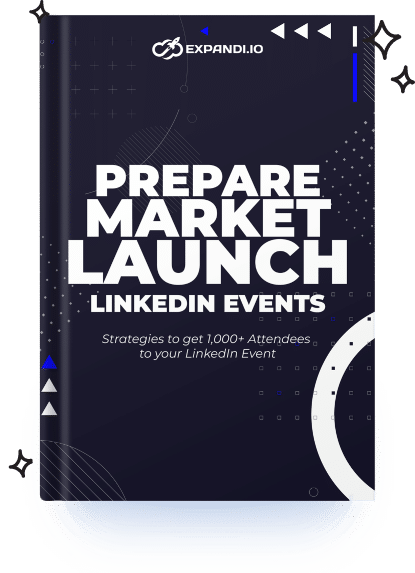
What works now won’t work again in a few months 😉 So…If you want take the swing and benefits – before it’s too late and before everyone starts using them
Download your FREE eBook now
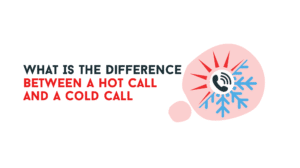
What Is The Difference Between A Hot Call And A Cold Call

Top 20 AI Sales Tools for High-Performing Sales Teams
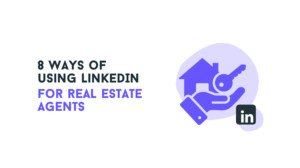
8 ways of using LinkedIn for real estate agents
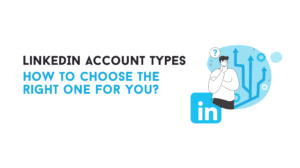
LinkedIn account types 2024: detailed comparison of all LinkedIn premium plans
- 7 important 'thank you' notes to send after your event: templates & tips
7 important 'thank you' notes to send after your event: templates & tips
- Last Updated : February 7, 2024
- 76.0K Views
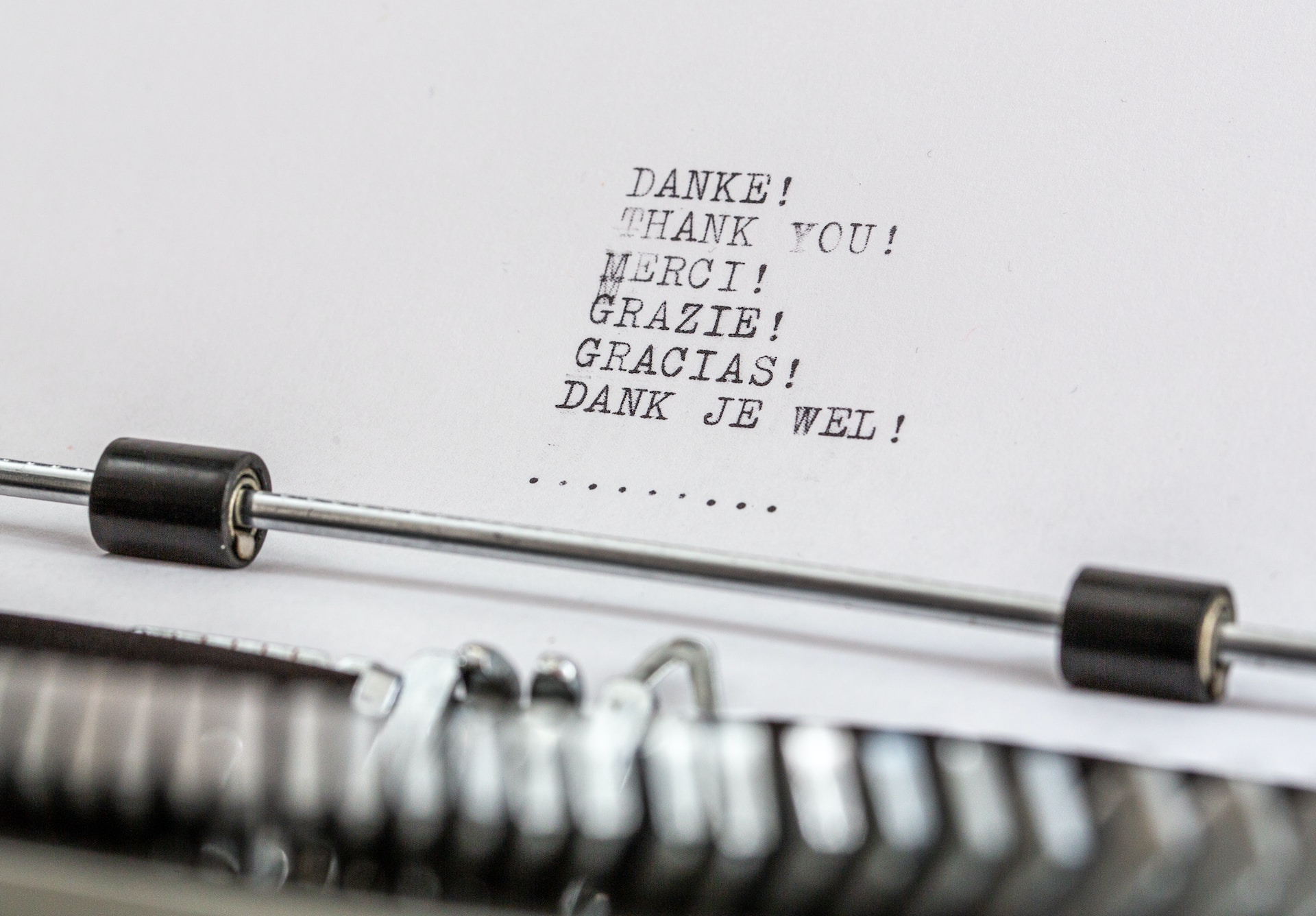
Well, folks, the curtains have closed, the lights have dimmed, and the last stragglers have finally stumbled out the door—your event is officially over! But before you kick off your heels and pop the champagne, it's time to show some love to the stars of the show: all the people who made it a success.
As an event planner, connections are key to keep pulling off successful events. Taking time to send thank-you messages to everyone can be the secret sauce to strengthen relationships and build a network of awesome connections for future endeavors.
In this article, we’ll provide you with email templates and guidelines to help you craft your thank-you notes. These are sure to reflect your appreciation and strengthen your relationships with key stakeholders. So, grab your pen (or keyboard), and let's get ready to dish out some heartfelt gratitude.
Writing Guidelines
When writing your email, it's important to do so in a way that is both professional and personal. These guidelines will help you strike that balance and craft a thoughtful message that event participants will appreciate.
Personalization
Personalize your email’s subject line and greeting with each recipient's name to make them feel valued. This also increases the likelihood of them opening the email!
Timeliness
Send the thank-you email as soon as possible after the event. The longer you wait, the less impact the message will have.
Gratitude
Express sincere gratitude for the recipient's participation and contributions to the event. Highlight the positive impact they had on the event's success.
Acknowledgment
Acknowledge the recipient's specific contributions to the event, such as their presentation, support, or participation.
Invitation for future collaboration
Invite the recipient to participate in future events or collaborate on future projects. This can help build a relationship and increase the likelihood of future collaborations.
Professionalism
Maintain a professional tone and avoid using overly casual language or slang.
Attention to detail
Check for errors and typos before sending the email. This shows that you value the recipient's time and attention.
Streamline communication with event tech
Beyond templates, consider incorporating event management software for drafting, scheduling, and sending event emails to key stakeholders. A good tool will provide:
Pre-designed templates: Choose from a library of professional email templates tailored to different audiences (speakers, sponsors, attendees, etc.).
Personalization tools: Insert custom fields like names, companies, and specific contributions for a more personal touch.
Scheduling and automation: Schedule emails to be sent automatically after the event or at specific intervals.
Segmentation and targeting: Send targeted emails to specific groups of stakeholders based on their roles, interests, or attendance data.
Benefits of using event tech software:
Save time and effort: Automate repetitive tasks and avoid manual email drafting.
Improve efficiency and accuracy: Personalize emails at scale and avoid human error.
Gain valuable insights: Track email performance and make data-driven decisions.
Without any further ado, on to the templates!
Speakers
When writing to your speakers, it's always a good idea to show them you paid attention. If the speaker had a particular style or way of delivering the presentation that impressed you, make sure to mention it. Did their energy pump the room up? Was their sense of humor sharper than a chef's knife? Did their speaking tone give you goosebumps in all the right places? Let them know that you noticed and appreciated their unique style.
And speaking of appreciation, if your attendees had some positive feedback to share about the speaker, make sure to pass it along! It's like a virtual high-five, a way of saying "Hey, you nailed it!".
Dear [Speaker Name],
I hope you're doing well! I wanted to thank you for being a speaker at [eventName].
Your presentation on [topic] was received very well by our audience. Many attendees also mentioned that it was one of the highlights of the event.
To give you an idea of the feedback we received, I have compiled some of the attendee feedback here [insert link].
I also wanted to let you know that we have created an on-demand video of your session so attendees who couldn’t make it to your session can watch it later. Please feel free to share it with your network or display it on your portfolio as well.
Thank you again for being a part of [event name]. It was an absolute pleasure working with you, and I hope we get to collaborate again in the future.
Please keep in touch and let us know if there's anything we can do to support you and your endeavors.
Best regards,
[Your Name]
[Your Organization]
Attendees
No attendees, no event—it's as simple as that! So don't forget to thank them for being a part of your event. A well-crafted thank-you email can not only show your appreciation but also gently nudge them towards taking further action.
Don't hesitate to add a Call to Action—after all, they're already interested in what you have to offer! Invite them to join your mailing list, follow your social media channels, or give feedback through a survey.
And why stop there? If you have any exciting post-event activities planned like a LinkedIn Live or a networking session, let them know! Who knows, maybe they'll be keen to keep the conversation going and take their involvement with your brand to the next level.
Dear [Attendee Name],
Thank you for attending [event name]! Firstly, we want to hear from you. Your opinion is incredibly important to us, and we want to make sure that we continue to deliver experiences that exceed your expectations. Please take a few minutes to complete our survey [Insert link to survey].
We have some exciting post-event networking activities planned, including a LinkedIn Live session where you can connect with fellow attendees and speakers to discuss the event's key takeaways [insert details about the networking activities and any links to registration or other information].
As we revisit the event, we wanted to share some highlights with you, along with a few photos that capture the spirit of the day [Insert a brief summary of some of the highlights from the event and attach photos].
Once again, thank you so much for being a part of our event and community. We're grateful for your support, and can't wait to see you again soon!
A thank-you email to a sponsor is probably the most essential one you will write because they empowered you to pull off an event of that scale. Let them know exactly how their contribution made a difference. Numbers, feedback, and social media stats will do the trick! Be sure to ask how the event benefited your sponsors too, from their experience at the event to their ROI.
Include any photos or videos from the event that showcase the sponsor's logo or branding. This is a great way to show the sponsor the visibility they received through their support.
Dear [Sponsor Name],
I wanted to take a moment to thank you for sponsoring [Event Name]. Your support and partnership played a key role in the success of our event, and we appreciate your participation.
I hope you're happy with the brand visibility you got from the event. I'm also adding a few photos and videos from the event that showed your brand well so you can use them in your campaigns.
We wanted to follow up and ask for your feedback on your experience as a sponsor. Did you feel that your ROI was worthwhile? Did the co-marketing campaign help you achieve your goals? Any feedback you can provide would be greatly appreciated, as we are always looking for ways to improve our future events.
Also, I wanted to let you know that we're currently offering the same sponsorship package for next year's event. If you sign up now, you can lock in the same price and ensure your spot as a sponsor.
Once again, thank you for your support of [Event Name]. We value our relationship with you and hope that we can continue to work together in the future.
Warm regards,
Vendors
Vendors do a lot of the heavy-lifting when it comes to putting the event together, so don't overlook thanking them for their support. Give them a shout-out for the specific items or services they provided. After all, it's the little things that count, like a perfectly crafted hors d'oeuvre or a stunning floral arrangement that makes the room pop.
You can offer to write them a review or recommendation to help boost their business. This way, you get to strengthen your professional relationship while also giving them the props they deserve.
Dear [Vendor Name],
I wanted to drop a quick note to say thanks for your awesome service at [Event Name] on [Event Date]. Your flexibility and willingness to go above and beyond to make sure everything was taken care of was greatly appreciated. The event wouldn't have been such a success without your help.
Thanks again for being such an amazing partner to work with. I'm excited to work together in the future.
Staff and Volunteers
Let's celebrate the real MVPs—your team! We all know that event planning can be downright chaotic at times, but having hardworking and passionate people on your side makes all the difference. Encourage them to continue to be involved in future events, as their dedication and commitment are invaluable.
Highlight outstanding contributions. Take note of any volunteers or staff members who went above and beyond their duties and mention them specifically. This lets them know that you noticed their hard work and are grateful for it.
Dear [Staff/Volunteer name],
I hope you've had some time to unwind and recharge after [event name]. I wanted to take a moment to personally thank you for your incredible efforts in making the event a success.
From the very beginning, it was clear that we had a great team of passionate individuals who were committed to making this event unforgettable. Your creativity, professionalism, and tireless work behind the scenes truly made all the difference.
Throughout the event, I was constantly amazed by [insert your feedback - e.g. your positive attitude, your willingness to go above and beyond, your unwavering commitment to excellence, etc]
It was an absolute privilege to work with you, and I feel grateful to have you on our team.
Thank you again for everything that you have done. I am looking forward to our next adventure together!
With gratitude,
Media
Want to make a big splash with your events? It's all about cultivating a good relationship with the press. After all, they're the ones who can help spread the word and generate buzz like nobody's business.
So if media coverage helped take your event to the next level, be sure to give them a shout-out and let them know just how much you appreciate their support. And if they need any extra details or quotes for their article, don't hesitate to offer your help.
Remember, a little love for the press goes a long way. So let's show them some appreciation and keep those waves rolling in!
Dear [Media Personnel],
On behalf of our entire team, I wanted to take a moment to express our gratitude for your coverage and support of [event name].
[If there was any pre-event PR, thank them for that here—e.g. Your coverage of the event provided valuable exposure and helped us spread the word about our mission and goals.]
If you need any further information or quotes from attendees for your news article, please do not hesitate to reach out. We would be happy to assist you in any way we can.
We also hope that you found the event to be informative and enjoyable. If you have any feedback on the event or suggestions for future events, please do not hesitate to let us know.
Again, we are grateful that you took the time to attend and report on the event. We value your partnership and look forward to working with you in the future.
A thank-you email is more than just a polite gesture. It's a powerful tool to foster goodwill, receive valuable insights, and improve future events.
So, whether you're sending a note to your speakers or your attendees, remember to be specific and personalize these templates to suit each person. And who knows? Your gratitude could lead to some exciting collaborations and partnerships down the road.
But wait, there's more! Thank-you notes are just the tip of the iceberg when it comes to event communication. As an event planner, your inbox can quickly become a whirlwind of emails – from initial invites to attendee follow-ups. Don't get lost in the chaos! Our comprehensive email resource blog serves as your one-stop shop for every email you'll ever need, throughout the entire event lifecycle.
Explore a curated list of pre-written templates, for each crucial stage of event planning. From the early days of sending save-the-dates to crafting registration confirmations and last-minute reminders, we've got you covered.
Related Topics
Marketer by day, geek extraordinaire by night—You can often find me at gig nights or the philosophy sections of bookstores. In my free time, I usually got headphones on, lost in an audiobook or podcast while indulging in my latest hobby, aka hyperfixation du jour. I like to travel to make feline friends everywhere I go. Sometimes I write. Join me as I navigate through the event industry!
Leave a Reply
Your email address will not be published. Required fields are marked
You may also like

Exhibition Management: A guide to planning an exhibition + free checklist

Sustainable event planning: 5 takeaways from COP26
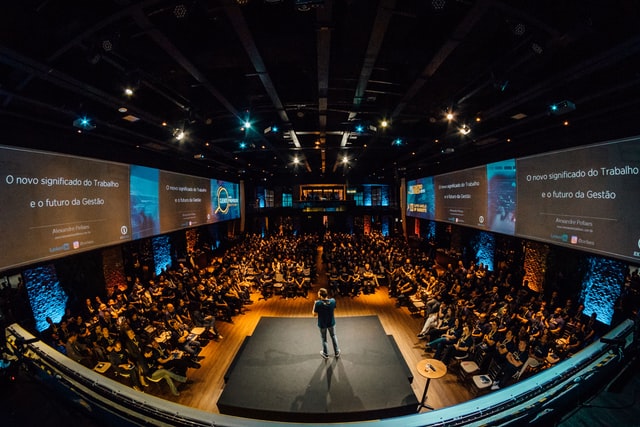
A 5-point guide to choosing speakers for events
Subscribe to the green room.
Sign up here and get all the most relevant MICE industry content delivered right to your inbox once a month.
Join Our Newsletter

120 Examples: Heartfelt Thank-You Messages and Phrases
By Status.net Editorial Team on November 23, 2023 — 27 minutes to read
- A Few Words About Gratitude Part 1
- Key Components of Genuine Thank-You Messages Part 2
- Examples of General Thank-You Phrases Part 3
- Examples of Thank-You Messages for Gifts Part 4
- Examples of Thank-You Messages for Support Part 5
- Personal Thank-You Phrases Part 6
- Thank-You Messages for Professionals Part 7
- Business Thank-You Phrases Part 8
- “Thank You for Your Consideration”: Phrases Part 9
- Thank-You Messages for Teachers Part 10
- Thank-You Messages for Friends Part 11
- Thank-You Messages for Family Part 12
- “Thank You for Your Help and Support”: Phrases Part 13
- Thank-You Messages for Acts of Kindness Part 14
- Thank-You Messages for Providing a Reference or Referral Part 15
- Common Thank-You Message Mistakes to Avoid Part 16
A thank-you message is a powerful way to express your gratitude and appreciation for someone’s help, support, or just for being in your life. When crafting a thank-you message, it’s important to make it genuine, heartfelt, and personal. In this section, we’ll explore different types of thank-you messages and provide you with examples and phrases to consider.
One common type of thank-you message is a personal thank-you note . This type of message typically acknowledges something specific that someone has done for you, such as a favor, gift, or kind action. When writing a personal thank-you note, focus on the person’s actions and the positive impact they had on you. Consider using phrases like:
- “I appreciate your help with…”
- “Your support meant so much to me…”
- “I couldn’t have done it without you…”
Another type of thank-you message is a professional thank-you note , which might be sent to a colleague, boss, or business contact. In a professional context, it’s important to maintain a balance between expressing your appreciation and sounding professional. You can use phrases like:
- “Thank you for taking the time to…”
- “I’m grateful for your assistance with…”
- “Your guidance has been invaluable… “
In some cases, you might want to express gratitude to a group of people, like coworkers or friends, with a group thank-you message . This type of message should be inclusive and recognize the collective efforts of everyone involved. When writing a group thank-you message, try phrases like:
- “Thank you all for your hard work and dedication…”
- “I’m grateful for each and every one of you…”
- “Your teamwork made all the difference…”
You may also encounter situations where you want to send a quick thank-you message , for instance, as a response to an email or a text message. In these cases, brevity and timeliness are key. Short, clear phrases will convey your appreciation effectively:
- “Thanks for your help!”
- “Appreciate the quick response!”
- “Thank you so much!”
Thank-you messages can take many forms, but the key elements remain the same: genuine appreciation, heartfelt words, and personalization.
Part 1 A Few Words About Gratitude
Intrinsically, gratitude is a powerful emotion that comes from appreciating what you have in your life. When you practice gratitude, you focus on the positive aspects of your life, which can make you feel more content and happier overall.
One great way to experience gratitude is by expressing thankfulness to others. Sending a thank-you message, either verbally or in writing, can offer a powerful way to demonstrate gratitude for another person’s actions, thoughts, or gestures. It allows you to acknowledge their kindness, reinforce your connection and create positive vibes.
Let’s discuss a few key elements that help in crafting a meaningful thank-you message:
- Sincerity: A genuine thank-you message goes a long way. Speak from your heart and make sure your words match your emotions.
- Specificity: Mention the specific action or gesture for which you’re thankful. It sets your message apart and assures the receiver that you truly appreciate their efforts.
- Promptness: Express your gratitude as soon as possible. A timely thank-you message has more impact and shows that you haven’t taken the person’s act of kindness for granted.
There are countless ways to express gratitude through different phrases and wording examples. The choice of words largely depends on the nature of the relationship and what you’re grateful for. Here are some versatile examples for diverse situations:
- I appreciate your help during this challenging time. Your support means so much to me.
- Thank you for the amazing birthday gift! I absolutely love it and can’t wait to start using it.
- I can’t thank you enough for being there for me when I needed someone the most.
Regardless of the specific words you choose, the important thing is to remember that expressing gratitude is an essential part of building and maintaining strong relationships. So, don’t hesitate to convey your thankfulness when you feel grateful for someone’s actions or even their presence in your life.
Part 2 Key Components of Genuine Thank-You Messages
When crafting a thank-you message, you should ensure it includes a few key components to effectively express your gratitude. These elements can be remembered using an acronym: STAR .
S pecific: Be specific about what you’re thankful for. Mention the gift, gesture, or act of kindness. This will make your gratitude feel more genuine and personalized.
Example: Thank you for the beautiful scarf you gifted me for my birthday.
T houghtful: Show thoughtfulness in your message. You can do this by complimenting the person or expressing how their gift or gesture has impacted you in a positive way.
Example: The scarf’s vibrant colors perfectly match my favorite outfits, and I can’t wait to wear it this winter.
A ppreciative: Express genuine appreciation for the person’s effort and time. Acknowledge the thought they put into their actions or the impact it had on you personally.
Example: I cannot express how grateful I am for your thoughtfulness in selecting this lovely gift. Your kindness means so much.
R eaffirmation (if applicable): Reaffirm your relationship with the person. This can be as simple as saying, “I’ll see you soon” or “I’m looking forward to the next time we can catch up.” This solidifies the bond between you and the recipient.
Example: I can’t wait to see you again and catch up over coffee.
A well-rounded thank-you message should convey specific gratitude, thoughtfulness , appreciation , and reaffirm your relationship with the recipient. By incorporating these components, your message will demonstrate your genuine appreciation and leave a lasting impression on the person you’re thanking.
Here are a few more examples:
- Thank you for the surprise birthday party! I had no idea you organized it all. It meant the world to me. Can’t wait to celebrate together again!
- I appreciate your kind words of encouragement during our conversation. Your support has given me a renewed sense of confidence. I hope we can meet up to chat more soon.
- The homemade cookies you made were absolutely delicious. I’m touched that you took the time to bake them for me. I’m excited for our next visit; maybe we can bake together!
Part 3 Examples of General Thank-You Phrases
As you express gratitude, you can use these simple yet heartfelt thank-you phrases to brighten someone’s day:
- Thank you so much for everything.
- I really appreciate your help.
- You made a real difference in my life.
- I couldn’t have done it without you.
- You have my deepest gratitude.
When you need to thank someone for their time, you can consider the following examples:
- Thanks for taking the time to talk to me.
- I appreciate the time you spent on this.
- Your guidance has been invaluable.
- Thank you for sharing your wisdom.
- The time you spent really made a difference.
If you want to convey appreciation for words of encouragement or motivation, you may use these phrases:
- Thank you for believing in me.
- Your words have lifted my spirits.
- Your encouragement has given me the strength to keep going.
- You’ve inspired me to persevere.
- I couldn’t have come this far without your support.
When you want to express gratitude for a gift or kindness, you can select from the following options:
- Thank you for this thoughtful gift.
- You really shouldn’t have, but I’m glad you did.
- You went out of your way to make me feel special.
- I can’t thank you enough for your generosity.
- Your kindness has melted my heart.
Part 4 Examples of Thank-You Messages for Gifts
When you receive a gift, it’s always nice to express your gratitude with a thoughtful thank-you message. Here are some examples of thank-you messages you can use or modify to suit your needs:
- Dear [Name], I absolutely love the [Gift] you gave me. It really brightened my day! Thank you very much.
- Your generosity is truly appreciated. The [Gift] is both beautiful and practical, and I can’t wait to use it. Thanks again.
- [Name], you really have a knack for finding the perfect gifts. I adore the [Gift] you picked out for me. Thank you!
For more specific gift scenarios, check out these thank-you message examples:
- Book: Thanks for gifting me [Book Title]. I can’t wait to dive into it and explore the world within its pages. You know my taste in literature so well!
- Homemade Treats: Your [Homemade Treats] are always irresistible, and I’m thrilled that you made some just for me. Thank you for your thoughtful and delicious gift!
- Gift Card: You’ve given me the perfect excuse to treat myself with this [Store] gift card. Thank you for your generosity—I promise to put it to good use!
If you want to thank someone for a group gift, you can use one of these messages:
- To everyone who contributed to the [Group Gift], I am beyond grateful. Your thoughtfulness means the world to me. Thank you all so much!
- Thank you for the wonderful [Group Gift]. The combined efforts and generosity of everyone involved is truly appreciated. I can’t thank you all enough!
No matter which thank-you message you choose to express your gratitude, remember to personalize it by mentioning the specific gift and the person’s name, if possible. This will make your thank-you message even more meaningful and heartfelt.
Part 5 Examples of Thank-You Messages for Support
When someone has been there for you during challenging times, it’s important to show them gratitude with a heartfelt thank-you message. Here are some examples of thank-you messages for support that you can use as inspiration:
- Thank you for being there for me during this difficult time. Your unwavering support has made a world of difference to me. I truly appreciate you.
- I just wanted to let you know how much your encouragement and kind words have meant to me. Knowing that you’re in my corner gives me the strength to keep going.
- Your understanding and patience have been invaluable to me, and I feel so grateful to have you in my life. The support you’ve given me has had a significant impact on my well-being.
Use these examples to craft a thank-you message that lets someone know how much you appreciate their support:
- I genuinely value your friendship and your unwavering belief in me during these challenging times. Your strength and positivity have lightened my load, and for that, I cannot thank you enough.
- Your guidance has been instrumental in helping me navigate this difficult situation. I’m grateful for your support and understanding, and I’m lucky to have someone like you in my life.
- Thank you for your continued encouragement and motivation. Your trust in me has allowed me to grow, and I’m grateful for the empowerment you’ve provided.
When you’re saying thank you, here are some ways to tailor your message to the specific kind of support your friend, family member, or coworker has given you:
- To a friend who helped you move: Thanks so much for your help packing and moving; you made the process so much easier and more enjoyable. Your support was invaluable.
- To a coworker who assisted with a tough project: Thank you for your hard work and dedication on this project; it wouldn’t have been a success without your help.
- To a family member who provided emotional support: I’m grateful for your compassion and empathetic ear; your understanding has given me comfort in difficult moments.
Thank your loved ones and colleagues for their support by making it personal and expressing how their efforts have positively impacted your life. A heartfelt message of gratitude goes a long way in showing someone you truly appreciate them.
Part 6 Personal Thank-You Phrases
Expressing your gratitude with a personal touch can make a big difference. Here are some heartfelt phrases you can use to convey your appreciation:
- Thank you from the bottom of my heart.
- Your kindness means the world to me.
- I can’t thank you enough for your help.
- You have my eternal gratitude.
- Your generosity has left me speechless.
- I am so grateful for you and everything you do.
- Thank you for being there for me.
When you want to thank someone for their support, consider incorporating some of these thoughtful expressions:
- Your encouragement has lifted me up.
- I couldn’t have done it without your support.
- You’ve been my rock during this difficult time.
- I appreciate your unwavering support.
It’s essential to make your thank-you message personal by mentioning the specific act of kindness or the quality you appreciate:
- Thank you for the delicious home-cooked meal you brought over last week. It made our day!
- I truly appreciate the time you spent tutoring me in math. Your patience and expertise helped me pass my exam.
- Your beautiful hand-lettered card brightened my day. Your creativity and thoughtfulness are unmatched!
Part 7 Writing Thank-You Messages for Professionals
When expressing gratitude to professionals, keeping your message concise, genuine, and specific helps convey genuine appreciation. Using a structured format can make the process easier and more efficient. Here’s an outline for drafting a professional thank-you message:
- Greeting : Start with a salutation that’s appropriate for your professional relationship.
- Appreciation : State specifically why you’re grateful and include any positive outcomes that resulted from their assistance.
- Connection : Mention any impact on your work or personal growth.
- Closing : End on a positive note, whether it’s an affirmation of your gratitude or an offer for future collaboration.
Now, let’s look at some example phrases for each part of the message:
Greeting examples:
- Dear [Name],
- Hello [Name],
Appreciation examples:
- Thank you for taking the time to help me with [specific task].
- I appreciate your guidance on [project].
- Your expertise in [subject matter] was invaluable.
Connection examples:
- Your insights helped me complete the project more efficiently.
- Your advice has improved my understanding of [topic].
- Your feedback has contributed to my growth in this field.
Closing examples:
- Once again, thank you for your support.
- I look forward to working with you again in the future.
- Please don’t hesitate to reach out if I can be of assistance to you.
Personalizing your message makes it more meaningful. Here are three examples of complete thank-you messages, following the format above:
Example 1: Dear Jane, Thank you for taking the time to review my presentation last week. Your suggestions made a significant difference in the flow and clarity of the content. I was able to deliver a more persuasive pitch, and the client was impressed with the final outcome. I look forward to more opportunities to collaborate in the future. Best regards, [Your Name]
Example 2: Hello John, I appreciate your prompt response in helping me troubleshoot the software issue I faced. Your expertise in identifying the malfunction saved me hours of work, and I was able to meet my deadline without any problems. Thanks again for your support, and let me know if I can assist you in any way. Warm regards, [Your Name]
Example 3: Dear Susan, Thank you for your insights during our brainstorming session yesterday. Your creative ideas inspired me to think differently about the project and develop new strategies. I feel more confident moving forward. Let’s collaborate more often! Kind regards, [Your Name]
Part 8 Business Thank-You Phrases
When you want to show your appreciation in the business world, using the right thank-you phrases can be essential. Here are some examples of professional and friendly thank-you messages you can use in various business situations.
General Business Thank-You Phrases
- Thank you for your assistance.
- Thank you for your continued support.
- Your expertise is greatly appreciated.
- We truly value your partnership.
- Your time and effort have not gone unnoticed.
After a Meeting or Presentation
- Thank you for the insightful presentation.
- Your input during the meeting was invaluable.
- We appreciate your dedication to the project.
After a Business Deal or Agreement
- Thank you for your prompt response.
- We are grateful for the opportunity to work with you.
- Your trust in our company is truly appreciated.
When Receiving Help or Advice
- Thank you for the valuable advice.
- Your guidance has been a huge help.
- We appreciate your expertise in this area.
After Receiving Feedback or Suggestions
- Thank you for the constructive feedback.
- We appreciate your suggestions for improvement.
- Your input is both valued and appreciated.
During a Job Interview or Networking Event
- Thank you for taking the time to meet with us.
- We appreciate your consideration for this opportunity.
- Your insights during the conversation were truly helpful.
Part 9 “Thank You for Your Consideration”: Phrases
Showing appreciation for someone’s time and consideration can help you strengthen relationships, both in personal and professional settings. Here are some examples of thank-you phrases and messages tailored specifically for people who have taken the time to consider your requests, suggestions, or proposals.
Example Phrases
- I’m grateful for your time and attention. This phrase conveys a sincere appreciation for the consideration that they’ve given you.
- Your insights are invaluable. This expression highlights the value of the other person’s input or feedback.
- Thank you for considering my request. This simple expression straightforwardly acknowledges the recipient’s time spent reviewing your request.
- I appreciate your thoughtfulness. This phrase conveys your recognition of their effort in considering your needs or concerns.
- Thank you for taking my concerns into account. Much like the previous example, this phrase shows your appreciation for their thoughtfulness.
Sample Messages
- Dear [Name], Thank you for taking the time to review my proposal. Your insights were invaluable, and I appreciate your thoughtfulness in providing feedback. I look forward to implementing your suggestions in our project. Best regards, [Your Name]
- Hi [Name], I’m grateful for your time and attention in discussing our team’s latest project. Your expertise really shone through, and we’ll definitely keep your suggestions in mind as we move forward. Thanks again! All the best, [Your Name]
- Dear [Name], Thank you for considering my request for a leave of absence. Your understanding and flexibility mean a lot to me, and I truly appreciate your support during this time. Sincerely, [Your Name]
Part 10 Thank-You Messages for Teachers
Teachers work tirelessly to help you grow and develop, so acknowledging their efforts with a meaningful message can go a long way. Below are some phrases and wording examples to use as inspiration for your own thank-you notes.
- Thank you for all that you’ve done for me.
- I appreciate your dedication and guidance.
- You’ve been a fantastic teacher, and I’m so grateful.
- Thank you for helping me improve my writing skills.
- Your passion for history made me excited to learn.
- Your patience and encouragement helped me conquer math.
- You’re an inspiration to all your students.
- Your enthusiasm for teaching makes each class enjoyable.
- I admired your ability to make challenging topics easy to understand.
- I’ll never forget the impact you had on my life.
- Your support made all the difference, and I’m very thankful.
- I look forward to the next steps in my education, knowing I had a great foundation with you as my teacher.
Here’s an example of how to put these phrases together in a thank-you message:
Dear Ms. Thompson,
Thank you for all that you’ve done for me this past year. Your dedication and guidance in helping me improve my writing skills have been invaluable. Your passion for literature made me excited to read and discuss our assigned books. I’m so grateful for your enthusiasm, which made every class enjoyable and inspiring.
You’re truly an inspiration to all your students, and your ability to make challenging concepts easy to understand sets you apart from other teachers. As I head into the next phase of my education, I feel fortunate to have had a strong foundation with you as my teacher.
Your support made all the difference, and I deeply appreciate it. I’ll never forget the impact you had on my life.
Warmest regards,
Part 11 Thank-You Messages for Friends
When expressing gratitude to your friends, it’s important to keep the messages genuine and heartfelt. Use specific details and personal anecdotes to make the message more touching. You can write a simple note, a beautifully crafted letter, or even send a warm text message. Here’s a list of example phrases that you can use as a starting point or inspiration:
- Thank you for always being there when I need a friend. I am so grateful to have you in my life.
- I appreciate your kindness and support. You have no idea how much it means to me!
- Your friendship has touched my life in more ways than I can count. Thank you for everything.
- I couldn’t have done it without you! You are a true friend, and I am lucky to have you by my side.
Part 12 Thank-You Messages for Family
Expressing gratitude to your family is an excellent way to build stronger relationships and maintain a positive atmosphere. A well-crafted thank-you message can make your family members feel appreciated and valued. Here are some tips on forming heartfelt thank-you messages, followed by examples of phrases you can use.
When writing thank-you messages for family, try to be specific about the reason for your gratitude. This shows you are not only appreciative, but also paying attention to their actions. Mention the action or gesture that prompted your gratefulness, so they feel personally acknowledged.
Example Phrases:
- Thank you for always being there for me, no matter what.
- I appreciate your guidance and wisdom so much.
- Your love and support mean the world to me.
Another important aspect of a thank-you message for family is showing sincerity. Use genuine language to express your emotions, and avoid making it sound like a generic statement. A genuine message will resonate with your family members, and they’ll be more likely to feel the love you’re trying to convey.
- I am deeply grateful for your constant encouragement.
- Your kindness and generosity have touched my heart.
- Your thoughtfulness has made a difference in my life.
Don’t forget to personalize your thank-you messages to suit the relationship you have with each family member. It’s essential to tailor your message based on the recipient and the unique bond you share. This adds a touch of warmth and authenticity to your thank-you note, making it all the more special.
- To my wonderful mother, thank you for your never-ending love and care.
- Dear sister, your support and friendship mean so much to me.
- As a father, you’ve provided everything I could ever need. Thank you.
Part 13 “Thank You for Your Help and Support”: Phrases
Expressing gratitude for help and support can be challenging, but it’s important to let others know how much you appreciate their assistance. Here are some examples of messages and phrases that you can use to express your gratitude in a supportive, conversational, professional, and friendly manner:
- Thank you for being there for me during this tough time. I appreciate your support more than I can express.
- Your encouragement has made a world of difference in my life. Thank you for believing in me.
- Thank you for offering your help and guidance when I needed it most. I’m grateful for your kindness.
- I appreciate all the time and effort you’ve put into helping me. Your support means the world to me.
- Your assistance in this project was invaluable. Thank you for your dedication and hard work.
- Many thanks for your constant support during this challenging period. Your encouragement helped me stay focused and motivated.
- I am so grateful for your help and expertise. Your guidance has been a real game-changer for me.
- Thank you for your generosity and willingness to lend a hand. Your assistance has lifted a huge burden off my shoulders.
- Your continued support has made all the difference in my success. I appreciate your unwavering faith in my abilities.
- I am forever grateful for your help during this pivotal moment in my life. Your guidance has made a lasting impact.
Part 14 Thank-You Messages for Acts of Kindness
When expressing gratitude for acts of kindness, remember to tailor your thank-you messages to show genuine appreciation and make the recipient feel valued. By personalizing your messages, you demonstrate that you genuinely care about the person who has shown kindness. Here are some tips on how to customize your thank-you messages, along with examples for various situations.
- Thank you for helping me move last weekend; your assistance made the whole process much smoother.
- I appreciate the time you took to explain the new software to me; your clear guidance made it so much easier to understand.
- Your encouragement during the job-search process lifted my spirits and kept me motivated; now I’ve landed the perfect job!
- The meal you prepared for us when we were sick was so thoughtful; it gave us the strength and comfort we needed to recover.
- Your support during the charity event meant a lot to me, as it’s a cause very close to my heart.
- I’ll never forget our late-night study sessions during college; your help played a huge role in making it through those exams.
- I can’t thank you enough for your generosity; it has left a lasting impression on me.
- Your support has made such a difference in my life, and I am truly grateful for your kindness.
Taking the time to tailor your messages will go a long way in strengthening your relationships and letting your loved ones know how much their acts of kindness mean to you.
Part 15 Thank-You Messages for Providing a Reference or Referral
Crafting a thoughtful thank-you message is a great way to express your gratitude to a person who has provided a reference or referral for you. Whether it’s a professional connection, a friend, or even a family member, expressing your appreciation is essential for maintaining healthy relationships and fostering a positive atmosphere. Here, we’ll explore some example phrases and wording to properly thank someone in that situation.
To begin, let’s look at some simple and casual phrases that are perfect for expressing your gratitude in a quick email or text message:
- Thank you for referring me to [Company/Job Title].
- I appreciate your recommendation!
- Your kind words about my skills and experience mean a lot to me.
- I’m grateful for your help in connecting me with [Company/Job Title].
For a more formal approach or a handwritten note, you can use some of these more detailed phrases:
- I can’t thank you enough for providing such a glowing reference on my behalf.
- Your support in helping me secure that job interview at [Company] means more than words can express.
- Your time and effort in referring me to [Job Title/Company] have made a significant impact on my career path.
- You’ve played a crucial role in my professional growth, and I’m truly thankful for your support.
- Because of your referral, I was able to land a job at my dream company! Thank you!
- Your faith in my abilities, as showcased in your reference, gave me the confidence I needed to succeed in the interview.
Sending a thank-you message not only shows your appreciation but also helps to strengthen your professional network. By acknowledging someone’s efforts on your behalf, you demonstrate your respect and commitment to the relationship. So, whenever someone provides a reference or referral for you, make sure to take some time to craft and send an impactful thank-you message.
Part 16 Common Thank-You Message Mistakes to Avoid
Sending a thank-you message is a lovely gesture, but it’s important to avoid common mistakes that could convey the wrong message. In this section, we will discuss some pitfalls to watch out for when crafting your thank-you messages.
Steering clear of lengthy messages. Long messages can be overwhelming and might dilute the impact of your gratitude. Keep your message concise and focus on expressing your appreciation rather than going into too much detail. Here’s an example of a short and sweet thank you:
I wanted to thank you for the beautiful scarf. It’s perfect for the chilly weather, and I love the colors. Your thoughtfulness means a lot to me!
Being mindful of your tone. Your tone should be genuine and friendly. Make sure your message doesn’t come across as forced or insincere. Maintain a balance between being polite and casual. A warm and sincere thank you might look like:
I can’t thank you enough for helping me move this weekend. Your assistance made the process so much easier, and I truly appreciate it.
Avoiding exaggerated claims. Be honest and realistic in your thank-you message. Over-the-top expressions of gratitude may seem inauthentic to the reader. Keep your message genuine and focused on specific instances you are thankful for. An honest gesture of gratitude can look like this:
I appreciate your support during the project. Your guidance and expertise helped me learn so much, and I look forward to collaborating again in the future.
Proofread your message before sending it. Correct any spelling or grammar mistakes and make sure the tone aligns with your intentions. This attention to detail will reflect positively on you and enhance the value of your thank-you message.
Frequently Asked Questions
How can i express gratitude for someone’s support and guidance.
Expressing gratitude for someone’s support and guidance can be done through sharing specific examples of how their actions made a positive impact on your life. You might mention challenging situations where their advice led to your success, or recall moments of empowerment and inspiration as a result of their guidance. Make your message sincere and heartfelt to let them know how much their support means to you.
What are some creative ways to show appreciation in a thank-you message?
To bring a creative touch to your thank-you messages, consider using personal anecdotes, sharing a memorable moment, or incorporating a unique quote that captures the essence of your appreciation. You can also experiment with the format, like writing a poem or crafting a personalized illustration. Adding a dash of humor, if appropriate, can make your message light-hearted and memorable.
What are the key elements in drafting a professional thank-you email?
A professional thank-you email should include:
- A clear and concise subject line, such as “Thank You for Your Assistance” or “Grateful for Your Time”.
- A purposeful opening greeting, addressing the recipient by their name.
- A genuine expression of gratitude, highlighting the value or impact of their contribution.
- Any relevant updates or follow-ups, if applicable.
- A closing line that reiterates your appreciation, such as “Thank you again for your help” or “I truly appreciate your support”.
- A professional sign off, like “Best regards” or “Sincerely”, followed by your full name and contact information.
What are some thoughtful appreciation messages for someone special?
For someone special, tailor your message to reflect your unique relationship, including personal details or anecdotes. Here are a few examples:
- Thank you for always being there for me. Your constant support and encouragement mean the world to me, and I’m truly grateful for the positive influence you’ve had in my life.
- I just wanted to say thank you from the bottom of my heart for the countless times you’ve lent a helping hand. Your selflessness and care have touched me deeply, and I’m so grateful to have you in my life.
- Your unwavering faith in me has made all the difference. I couldn’t have achieved so much without your guidance and wisdom. Thank you for being my mentor, confidant, and friend.
How can I write an eloquent thank-you message for someone’s time and effort?
To write an eloquent thank-you message, focus on acknowledging the person’s contribution by specifying the time and effort they invested, and expressing how their actions have impacted you or your project. Consider using expressive and descriptive language to convey your emotions and feelings effectively, while maintaining a polite and professional tone.
- Perfect Ways to Say "Thank You for the Opportunity" (Examples)
- Interview Follow-up Email Examples (1-2-3 weeks)
- 10 Smart Examples of An Interview Thank You Email
- Job Knowledge Performance Review Phrases (Examples)
- Thanking Someone [30 Responses for Professional Scenarios]
- 35 Heartwarming Thank-You Note Examples to Show Your Appreciation

- SUGGESTED TOPICS
- The Magazine
- Newsletters
- Managing Yourself
- Managing Teams
- Work-life Balance
- The Big Idea
- Data & Visuals
- Reading Lists
- Case Selections
- HBR Learning
- Topic Feeds
- Account Settings
- Email Preferences
How to Make a “Good” Presentation “Great”
- Guy Kawasaki

Remember: Less is more.
A strong presentation is so much more than information pasted onto a series of slides with fancy backgrounds. Whether you’re pitching an idea, reporting market research, or sharing something else, a great presentation can give you a competitive advantage, and be a powerful tool when aiming to persuade, educate, or inspire others. Here are some unique elements that make a presentation stand out.
- Fonts: Sans Serif fonts such as Helvetica or Arial are preferred for their clean lines, which make them easy to digest at various sizes and distances. Limit the number of font styles to two: one for headings and another for body text, to avoid visual confusion or distractions.
- Colors: Colors can evoke emotions and highlight critical points, but their overuse can lead to a cluttered and confusing presentation. A limited palette of two to three main colors, complemented by a simple background, can help you draw attention to key elements without overwhelming the audience.
- Pictures: Pictures can communicate complex ideas quickly and memorably but choosing the right images is key. Images or pictures should be big (perhaps 20-25% of the page), bold, and have a clear purpose that complements the slide’s text.
- Layout: Don’t overcrowd your slides with too much information. When in doubt, adhere to the principle of simplicity, and aim for a clean and uncluttered layout with plenty of white space around text and images. Think phrases and bullets, not sentences.
As an intern or early career professional, chances are that you’ll be tasked with making or giving a presentation in the near future. Whether you’re pitching an idea, reporting market research, or sharing something else, a great presentation can give you a competitive advantage, and be a powerful tool when aiming to persuade, educate, or inspire others.
- Guy Kawasaki is the chief evangelist at Canva and was the former chief evangelist at Apple. Guy is the author of 16 books including Think Remarkable : 9 Paths to Transform Your Life and Make a Difference.
Partner Center
Similar Letters
Thank you letter to someone for a speech or presentation, thank you letter for a presentation. sample letter, sample letter to thank someone for her presentation, thank you sample letter to someone for a speech or presentation, thank you letter to someone for a presentation. sample letter, sample letter to thank someone for her speech, sample letter to thanks someone for inquiring about classes, thank you letter to military, sample follow-up letter seeking meeting next weekend, thank you letter to a friend, thank you letter after an event, invitation letter sample to a web development seminar, year-end thank you letter, letter to thank someone for giving reference, thank you letter leaving company, second interview thank you letter, sample letter to thank someone for accepting recommendations, wedding thank you letter, thank you letter to a retiring colleague for his service, thank you letter for christmas, letter categories, thank you letter after presentation.

- Thank them for the presentation.
- Tell them how you benefited from the presentation and compliment them on how they undertook the presentation.
- Express thanks again.
SAMPLE LETTER
[Letter Date]
[Subject: Normally bold, summarizes the intention of the letter] -Optional-
Dear [Recipients Name],
I would like to take this opportunity to thank you for the wonderful presentation you gave yesterday. Your many years of research and in-depth understanding of [subject] was very evident in the presentation. It was very insightful and inspiring. I must say that contrary to what people say about [subject] presentations; it was very intriguing. The way you incorporated some light moments, and a bit of humor were interesting and this made the people present alert and attentive. Thank you so much for sharing your thoughts and ideas.
Sincerely, [Senders Name] [Senders Title] -Optional-
[Enclosures: number] - Optional - cc: [Name of copy recipient] - Optional -
Thank you letter after presentation.
Further things to consider when writing thank you letters to speakers, performers

Thank You Letters
Thank-you letters are letters written to politely acknowledge a gift, service, compliment or an offer. Simply put, these are letters you write to express your gratitude and appreciation for someone's thoughtful actions. You can send a thank-you letter after personal events, an interview, networking events, after receiving a gift or donation, etc. A thank-you letter is always special in that it lets the recipient know that what he/she did was greatly valued and appreciated. The letter should be sent promptly and when the events are still fresh so that it can be more meaningful. Thank-you letters should be warm, personal, and sincere. Begin with the two magical words "Thank you," and address the recipient in a way that feels most natural. Be clear about what you are thanking the person for. Let the recipient know why his/her specific gift or actions are cherished and why they are important to you. Inquire after the recipient's well-being and share some information about your life. Let him/her know that you are thinking about him/her and mention the next time you may want to meet. To wrap things up, thank the recipient again and let him/her know that you value his/her friendship.
Letters to Speakers, Performers
Letters to speakers and performers are letters written to people who give speeches at public events and those who entertain audiences. Whether you are organizing a special event, business conference, or graduation ceremony, the speakers and performers you invite will be among the primary attractions. They can give valuable insights and add prestige to your organization. Whatever the theme of your event, the speakers and performers must be suitable for the event as well as the audience. The best speakers and performers are usually booked months in advance. Therefore you should ideally send your invites six to twelve months prior to your event. Well-drafted letters to speakers and performers will ensure that the parties involved understand all the details of the event. Begin with the right address and salutation. Introduce yourself and mention the objective of your letter. Be specific about what you expect from the recipient. Include relevant information such as date, time, and venue of the event. If applicable, mention any financial arrangements regarding any travel expenses, the fee for the recipient, or honorarium. Include the date for a response and your contact details. Close the letter on a positive note. You may attach the event's program.
These articles may interest you

- Presentation
- thank you letters

IMAGES
VIDEO
COMMENTS
Sample Sentences for Step 1. On behalf of the members of the local Chamber of Commerce, I want to thank you for your insightful presentation yesterday. As chairperson for our County Fair entertainment committee, I want to thank your dance group for their delightful performance. They won the hearts of the entire audience.
1. Time Your email. Examples of The Perfect Thank You Email After A Presentation 4. According to research conducted by Moosend, Thursday was the best of the weekdays in terms of the highest open rate and Tuesday was the second-best day. Furthermore, 8-9 am was the best time of the day to deliver them. When it comes to email, timing is very ...
Tell the speakers or the presenters for the job well done and thank them. Congratulate them for the great work and elaborate some of the most important and memorable parts. If the talk or presentation was so-so, just thank the person for taking part in the program. End the letter with another praise or expression of gratitude.
An example of this would be, "Thank you for being here today, I really appreciate that you took the time to be here and listen to my presentation". It can also be something short and sincere, like a "Thank you very much!". 2. Summary.
Tell the speakers or the presenters for the job well done and thank them. Congratulate them for the great work and elaborate some of the most important and memorable parts. If the talk or presentation was so-so, just thank the person for taking part in the program. End the letter with another praise or expression of gratitude.
Tricks and tips: how to say thank you after a presentation 5. Samples of thank-you letters after presentations. Useful tools: 1. Newoldstamp - Email signature marketing 2. Mailchimp - Email builder and sender 3. Reply.io - Personal email outreach, calls, and tasks 4. Mailtrack - Email link opens tracking 5. Canva - Online tool for making designs
Address of the Recipient. Subject: Thank You for _____ Presentation Letter. Dear ______ (Name of the Recipient) (Body of the Letter) Sincerely, (Signature) Sender's Full Name. You should try to include a short presentation summary in your letter. This will remind the recipient about your presentation.
Here's how to do it right. Keep it genuine : The goal of expressing appreciation should be to let someone know how their actions have impacted you and/or others. If you have any other agenda ...
Use phrases such as: "I would like to express my sincere gratitude to all of you for being here today.". "I am extremely grateful for the opportunity to address such an esteemed audience.". Using Formal Language in Slides: Alongside your verbal expressions of thanks, you can use gratitude-focused slides in your presentation.
Sample Sentences for Step 3. Thank you for your helpful comments. Thank you for your enlightening speech. I appreciated your lecture and felt as if you were speaking directly to me. Please accept our thanks for a great presentation; Thank you for speaking to us this week. We thank you for your stimulating speech. Sample Phrases for Step 3
Irrespective of how you decide to make your presentation thank you slide, these six tips will help you: Include a call to action for your audience. Try not to end with questions. ... Avoid leaving your audience confused about whether or not your presentation is over. Examples of Presentation Thank You Letter. Subject line: A follow-up on (topic ...
For those whom you want to mention but don't have enough time to make individual acknowledgments consider grouping them according to function. Example: "To Alex, Mary, Judy and Sam, thank you for making me remember to laugh. You helped me keep my sanity and perspective when the going was tough." 3.
As you're wrapping up your presentation, finish with a splash of color. Thank you slides for presentations (or alternatives) should be eye-catching. This template helps you cover that with 32 unique slides—all vibrant and stunning in design. 2. Deas PowerPoint Template. There are several thank you slide for your presentation in this template.
3 Strategies to Close Your Presentation Powerfully. Use these 3 strategies in your conclusion to: recapture your audience's attention. get your audience to focus and remember your key points. help your audience connect with you and your topic. end your presentation powerfully. One: Include a Call to Action (CTA)
26. "Thank you for the lively discussion. Let's continue to build on these ideas.". 27. "As we wrap up, I encourage you to reach out with any further questions.". 28. "In closing, I'd like to express my gratitude for your valuable input.". 29. "Let's conclude on a high note and take these learnings forward.".
Template 5. Download Thank You Slide For Business Communication Template. With the help of this professionally designed thank you template, you can acknowledge the audience's time and the interest shown by them. The color palette used here instantly grabs the attention of the viewers. Template 6.
Learn how to write a professional thank you email with 25 different use cases. Discover the power of gratitude in business communication and boost response rates by almost 53.5%. This guide offers real-time examples and copy-pastable email samples to maintain positive relationships with clients, partners, bosses, and colleagues. Say thanks in a meaningful way and foster a healthy work environment.
Your presentation on [topic] was received very well by our audience. Many attendees also mentioned that it was one of the highlights of the event. ... Once again, thank you for your support of [Event Name]. We value our relationship with you and hope that we can continue to work together in the future. Warm regards, [Your Name] [Your Organization]
Dear [Recipients Name], I offer you my sincere appreciation to you for taking the time to make the presentation to our annual conference last month. The whole conference was a success, but most people commented on how outstanding your presentation was. I feel that the overall success of the conference was in a large part down to your talk.
General. First, let's take a look at the neutral ways to say "thank you". You may use these in an email to a colleague that you're not super close with, or a link building partner, for example. Many thanks. Thank you very much. I appreciate your help. Thank you. Sincerely. Thank you.
Personalizing your message makes it more meaningful. Here are three examples of complete thank-you messages, following the format above: Example 1:Dear Jane, Thank you for taking the time to review my presentation last week. Your suggestions made a significant difference in the flow and clarity of the content.
Think phrases and bullets, not sentences. As an intern or early career professional, chances are that you'll be tasked with making or giving a presentation in the near future. Whether you're ...
SAMPLE LETTER. [Subject: Normally bold, summarizes the intention of the letter] -Optional-. Dear [Recipients Name], Please accept my thanks for your brilliant speech, at last, week's meeting of the York Geographical Society. I know many members found your work very useful in their studies of the coastline of New England.
The letter should be sent promptly and when the events are still fresh so that it can be more meaningful. Thank-you letters should be warm, personal, and sincere. Begin with the two magical words "Thank you," and address the recipient in a way that feels most natural. Be clear about what you are thanking the person for.